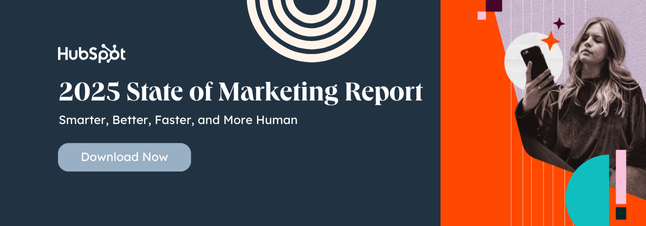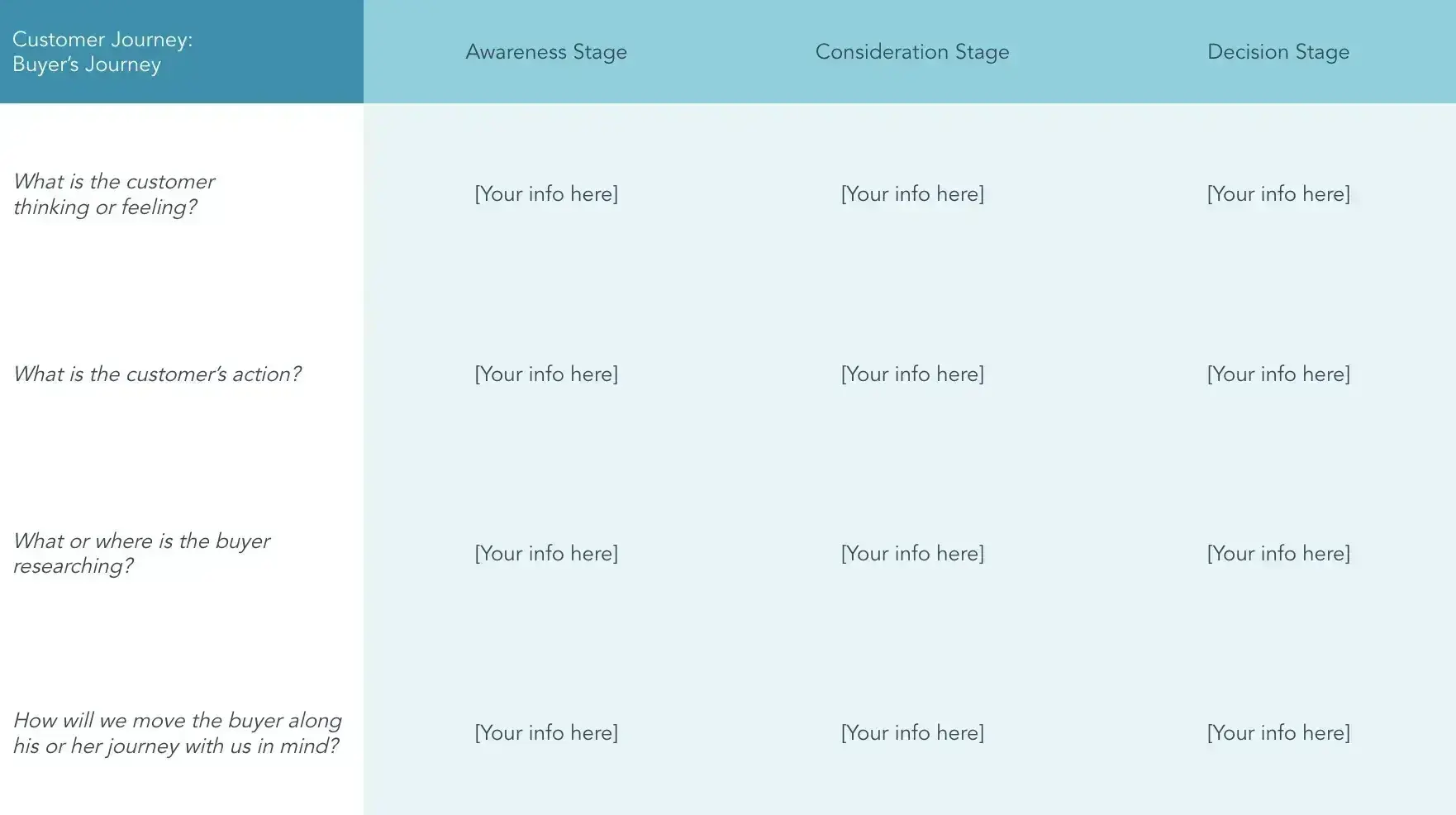20 best B2B lead generation tools
There’s no way around it — every business needs to drive leads to grow. However, B2B lead generation is far from a simple task. You are competing with other businesses, navigating misinformation, and playing trial and error with various tools. Not to mention, you also […]
MarketingThis AI prompt can transform you into an elite marketer in any field, here’s how
We all know AI assistants can help with marketing tasks. But, here’s what most people are missing: Using AI as a prompt engineer is where the real productivity gains happen. I’ve been experimenting with this approach for months, and the results are mind-blowing. Instead of […]
MarketingContent strategy red flags: What B2B marketing teams get wrong and how to course-correct
I see a lot of marketing teams stuck in the same cycle: They believe in content. They’re creating constantly. But, they’re just not seeing the results they want. Add that the CEO is asking why the competitor is “suddenly everywhere.” Oh, and internally, there’s no […]
Marketing




29 of My Favorite Visual Content Creation Tools
Visual content, be it video, infographics, photos, or some secret fourth thing, is a must-have in any marketing campaign. But, if you struggle to edit visuals or coordinate elements like colors and fonts, creating visual content for your brand can seem daunting. If that‘s the […]
MarketingVisual content, be it video, infographics, photos, or some secret fourth thing, is a must-have in any marketing campaign. But, if you struggle to edit visuals or coordinate elements like colors and fonts, creating visual content for your brand can seem daunting.
If that‘s the case, I’ve been in your shoes before. To help you create valuable visuals for your brand, here’s a list of nearly 30 online design tools you can use, many of which are free or have free trials.
But first, let’s quickly jump into how to create visual content.
Table of Contents
- How to Create Visual Content
- Visual Conent Examples
- Online Design Tools for Creating Stunning Visual Content for the Web
How to Create Visual Content
First things first, you need to know your audience. Before I create any graphic, I think about the type of content my target audience responds to and what platforms they frequent the most.
For example, during my time working at a television news station, I found that our viewers responded well to infographics and spent most of their time on Facebook.
So, naturally, I’d create infographics to break down complex news updates and distribute them on Facebook.
Once you figure out your format and distribution channel, you’re ready to start working on your visual content. I encourage you to be creative, think outside the box, and experiment with different approaches. That said, you should always use colors that pair well together.
Not sure how to coordinate colors? No worries! Whenever I’m struggling to find the right colors to incorporate into a graphic, I consult Canvas color wheel, which also includes a crash course in color theory and combinations.
I also suggest using your brand’s colors in your visual content wherever possible. It gives your content a cohesive and consistent look and helps you brand stay top of mind for consumers.
Use consistent, branded fonts if you‘re able to, and avoid using too many fonts. My rule of thumb is now more than two different fonts in one graphic. And don’t be afraid to experiment with tools like HubSpot’s Clip Creator or any of the ones I’ll list in this post.
Even if you don’t use every tool, its features and resources may inspire you for future projects.
Visual Content Examples
1. McDonald‘s “WcDonald’s Campaign”
McDonald’s ran an ad campaign called WcDonalds that featured ads animated in the Japanese anime style. The idea coincides with the recent popularity of anime in mainstream media and how the franchise if often referenced in anime and by fans alike.
I’m a huge anime nerd, so of course, I adored this campaign. As a marketer, I loved the bold use of color, the high-quality animation, and the fun storylines in each ad.
2. Airbnb’s Instagram
Airbnb relies heavily on visual content to attract customers to it‘s rental properties listed by Airbnb hosts. The vacation rental company’s Instagram mainly consists of gorgeous photos taken by Airbnb renters, influencers, and photographers.
The result is a gorgeous photo collage of picturesque rentals, happy families and pets enjoying the amenities, and genuine customer reviews.

3. National Geographic
The folks at National Geogrpahic are pros at using visual content like infographics to rely complicated information in a way that is easily digestible. In the example below, NG uses an infographic to show readers how fires often protect California’s giant sequoia trees.
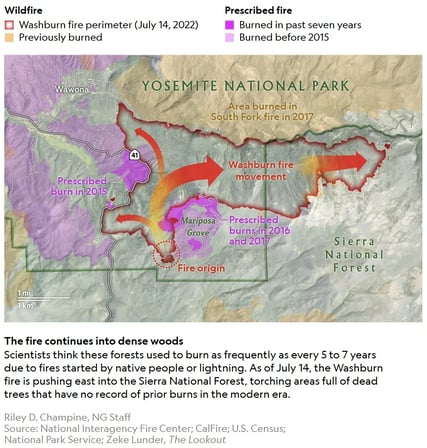
Online Design Tools for Creating Stunning Visual Content for the Web
When I initially started creating graphics for previous jobs, I was completely lost. I didn‘t have much an eye for color or font combinations, I didn’t always know what images worked for the message I was trying to convey, and I didn’t always know where to find the content I needed.
And don‘t get me started on the perils of creating visual content on a limited budget. Fortunately, you don’t have to struggle like I did because here are 29 online design tools to make visual content creation much easier.
Font Tools
1. Fontjoy
Need to find the perfect font combination for your next project? Fontjoy makes it easy for users to find great combinations of fonts. It uses a neural net to provide font suggestions, displaying them in real time to help you get a better sense of how they look paired together.

What I love: Fontjoy takes the guesswork out of pairing different types of fonts, something even I’ve struggled with.
2. Google Fonts
If you’re looking for quality typography for your next design, check out Google Fonts. This directory of web fonts makes it easy for users to add a font to their website in seconds or download it to their computer to use later.
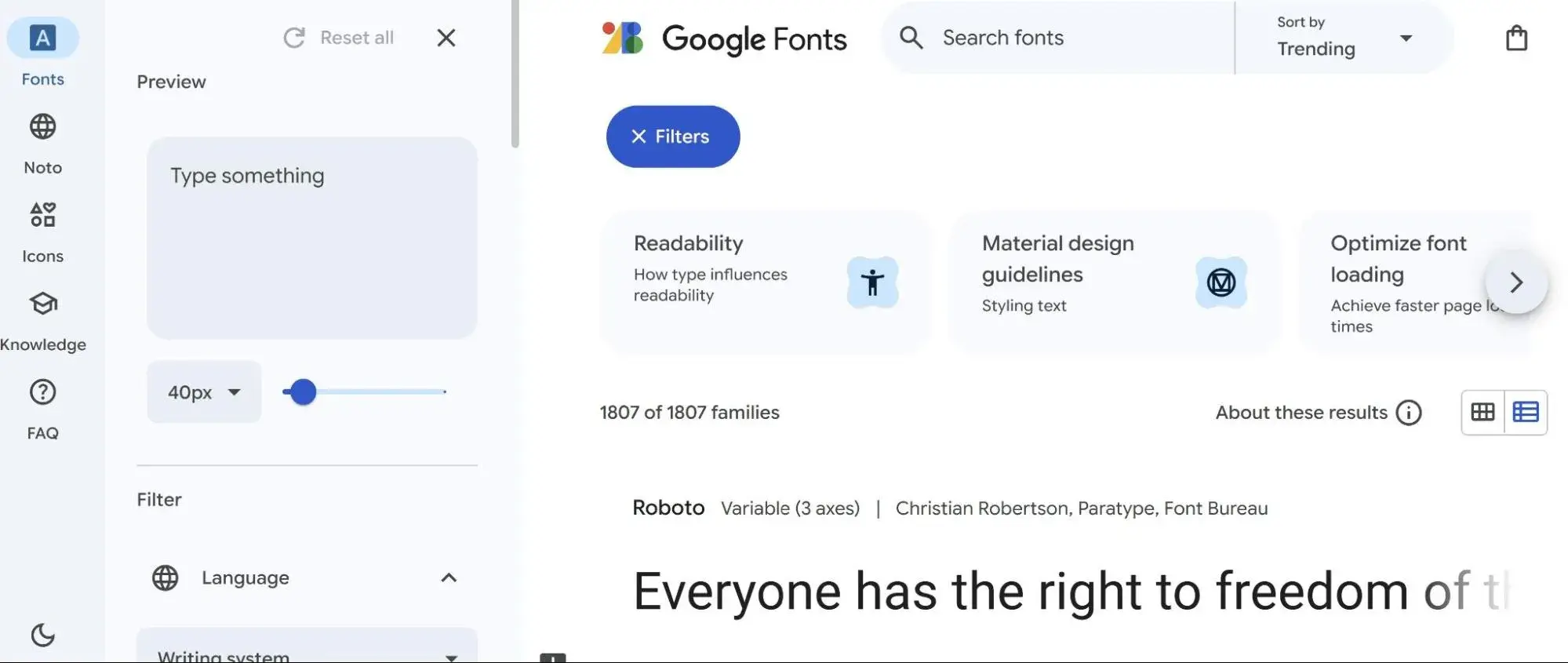
What I love: All of the available fonts are open source, meaning users can customize, improve, and share them as they see fit.
3. WhatFont
Have you ever come across a font on a particular web page and thought, “I need that?” With WhatFont, users can quickly and easily identify the names of the fonts used on any web page with just one click.
Available for download as a bookmarklet, Google Chrome Extension, or Safari Extension, you’ll never be left feeling stumped about a font name again.

What I love: WhatFont is incredibly easy to use and fun to experiment with when you’re looking for font inspiration.
4. DaFont, 5. 1001 Free Fonts, and 6. Font Squirrel
Looking for an extra special font to help your design stand out? While there are a ton of free font resources out there, we’ve narrowed down our favorites to DaFont, 1001 Free Fonts, and Font Squirrel.
What I love: These sites offer an extensive library of high-quality fonts that are easy to download and clearly defined in terms of licensing.
Templates
7. HubSpot’s 15 Infographic Templates
Sometimes, you‘re just short on time and need to make a graphic or graphics as quickly as possible. In those moments, you don’t need tools; you need a template.
With this pack of free infographic templates, you can create professional-looking infographics and save hours of time in the process. The best part? You can easily customize them to fit your company’s branding.
What I love: These templates can serve as time savers or inspo. The choice is yours!
8. Canva
Canva and I go together like peanut butter and jelly. I’ve been using the tool for both personal and professional projects for about 10 years now.
Whether I’m looking to create an ebook, infographic, business card, or email header, Canva has a template to simplify my process. In fact, the free web design tool offers professional, easy-to-customize templates for just about any design need you can think of.
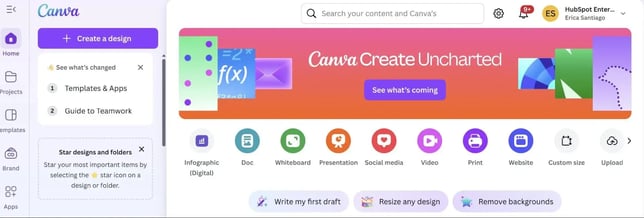
What I love: Canva is built with non-designers in mind, making it easy to drag-and-drop objects and images until you like the way it looks. Change the images, switch up the fonts, adjust the colors, and voilà: You’ve got yourself a design you can be proud of.
9. HubSpot’s 28 Customizable CTA Templates
If you want to drive your website visitors to take an intended action, you need to make it easy for them to do so. That’s where CTAs come in.
But not just any old design will do. In fact, factors like color, size, and shape, all play a role in the performance of your button. So to help you encourage more visitors to become leads, we’ve created 28 pre-designed CTA templates to employ on your website.
What I love: These templates are customizable, so I encourage you to test different colors and placements until you find what works best for you.
10. HubSpot’s 30 PowerPoint SlideShare Templates
Love the concept of SlideShare but don’t have a lot of experience designing in PowerPoint? No problem.
With our free PowerPoint templates, you can create beautiful SlideShare presentations without the heavy lifting. Simple plug in your content, adjust the colors to match your branding and swap out images as you see fit.
What I love: These templates range from clean and simple to a bit more intricate, so you’ll have no problem finding one that suits your content.
Color Tools
11. Coolors
I’m a firm believer that one of the most important elements of web design is the color palette. You want to make sure your images, graphics, and font colors convey your message and maybe even drive conversions.
But often, it’s hard to find the right color combination for a design, which is where Coolors comes in. Press the spacebar to instantly get recommendations for colors to use, including their respective HEX codes. Your color palettes will never be uncoordinated again.
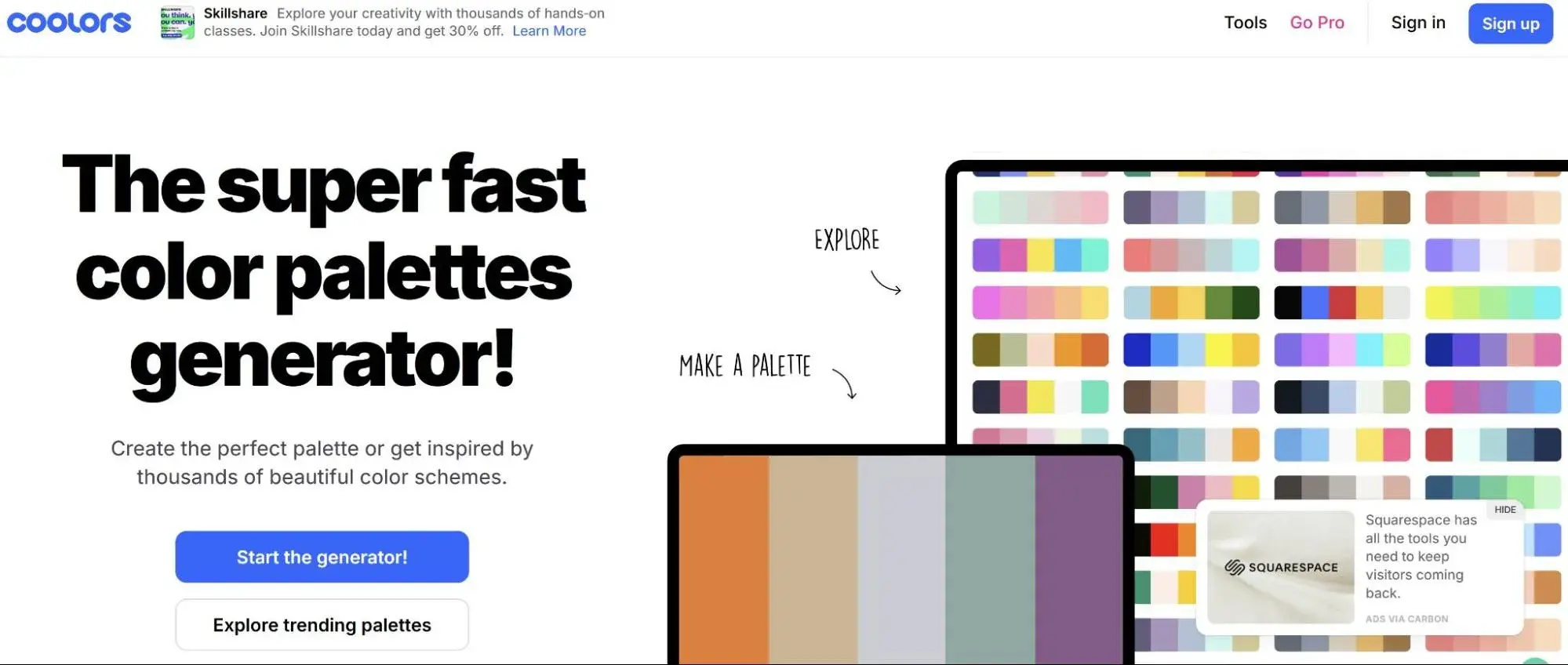
What I love: Coolors is very user-friendly and can help content marketers save a lot time finding the right colors for their visual media.
12. ColorZilla
ColorZilla is a great tool for all your color-related needs, from the most basic to the most advanced. Whether you’re looking to pull up the HEX code for a specific pixel on a page, analyze DOM element colors, or uncover element information such as tag name, class, id, and size, this tool can handle it all.

What I love: ColorZilla is versatile, so play around if you want to find other use cases for your graphics.
13. Canva Color Wheel
I love, love, love Canva‘s online color wheel! As I said earlier, it’s a simple way to pair different colors for your visual content, especially if you‘re like me and don’t know much about color theory.
What I love: The tool is so fun to play around with, and I love that it gives you a quick run-through of color theory so you can learn to apply it to other projects.
Annotation Tools
14. Awesome Screenshot
Ever find yourself drowning in 20 different programs to crop, edit, and annotate screenshots? With Awesome Screenshot, a browser extension for Firefox and Chrome, you can easily screenshot anything on the web and edit it directly within your browser.
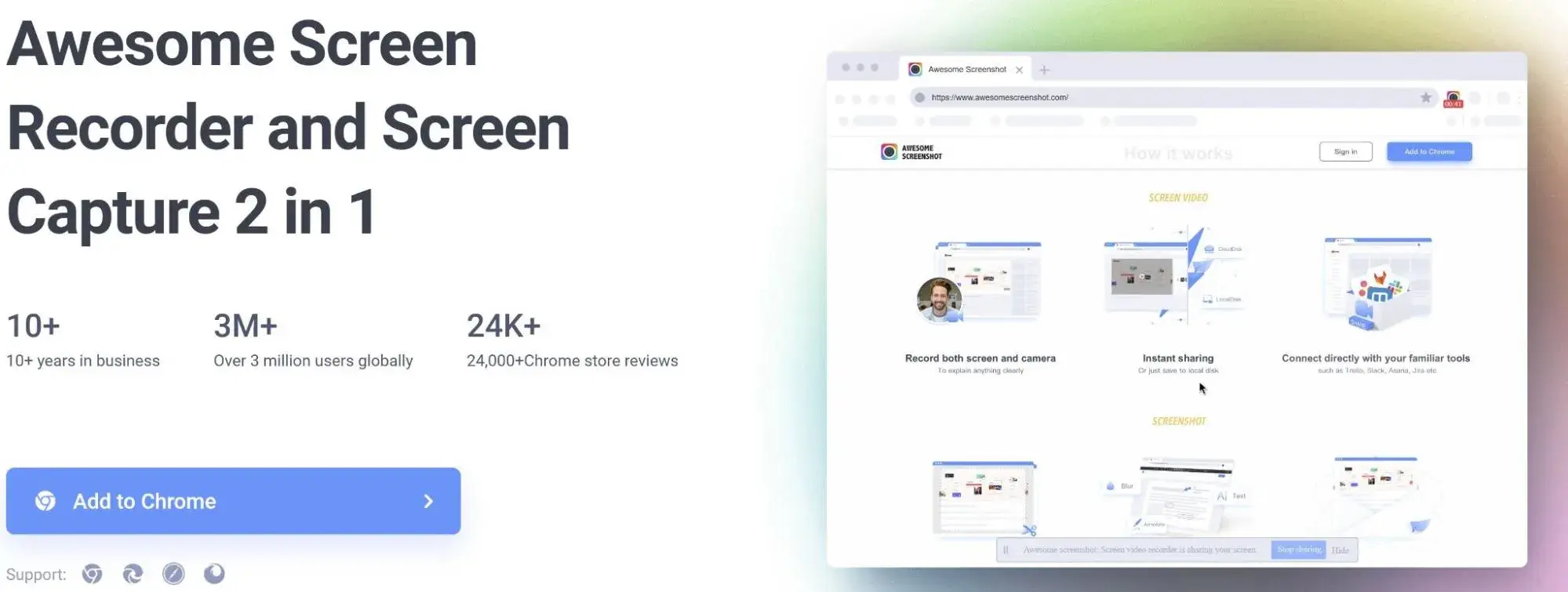
What I love: Awesome Screenshot is easy to use and a huge timesaver.
15. Filestage
How often have you shared feedback about a PDF or image, only for it to be misinterpreted? Filestage is a feedback tool that makes it simple to leave in-context feedback on just about any file type you can think of. Documents, PDFs, videos, graphics, and more.
What I love: With a wide range of annotation and proofing features, you can draw on top of your content to bring comments to life. This makes it easy to align internal and external stakeholders in real time. And best of all, your first two projects are free.
Photo Editing Tools
16. PicMonkey
Okay, let‘s say you don’t have the budget for Photoshop and feel somewhat limited by PowerPoint’s visual editing capabilities… what are you to do? If you want to spruce up your images — re-color them, add borders, add text, and even insert graphics on top — all without downloading yet another program to your computer, check out PicMonkey.

What I love: The whole photo editing process is intuitive, which means you can spend more time optimizing your blog posts instead of sprucing up its accompanying featured image.
17. BeFunky
If you love the look of cool, vintage Instagram-esque photo filters, you’ll love BeFunky. This free photo editor boasts a ton of awesome features, including effects, frames, graphics, and textures.
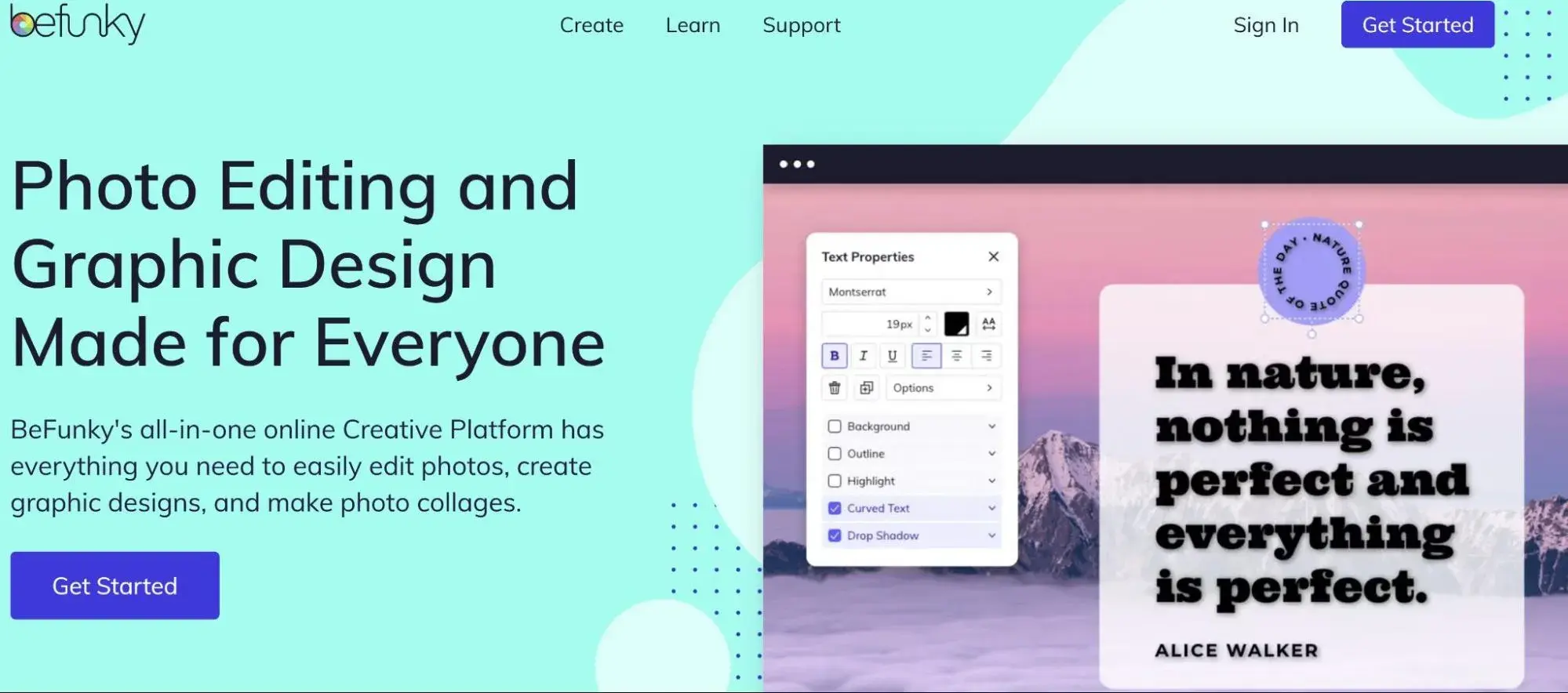
What I love: Whether you’re a seasoned designer or just getting started, the interface is super straightforward and approachable. With just a few clicks, you can enhance an ordinary photo or create a collage worthy of sharing on your social accounts.
18. Giphy
Giphy is a tool for converting portions of video into looping GIFs. You can also use other user-generated GIFs on the platform. This adds personality to presentations, emails, and blog posts.
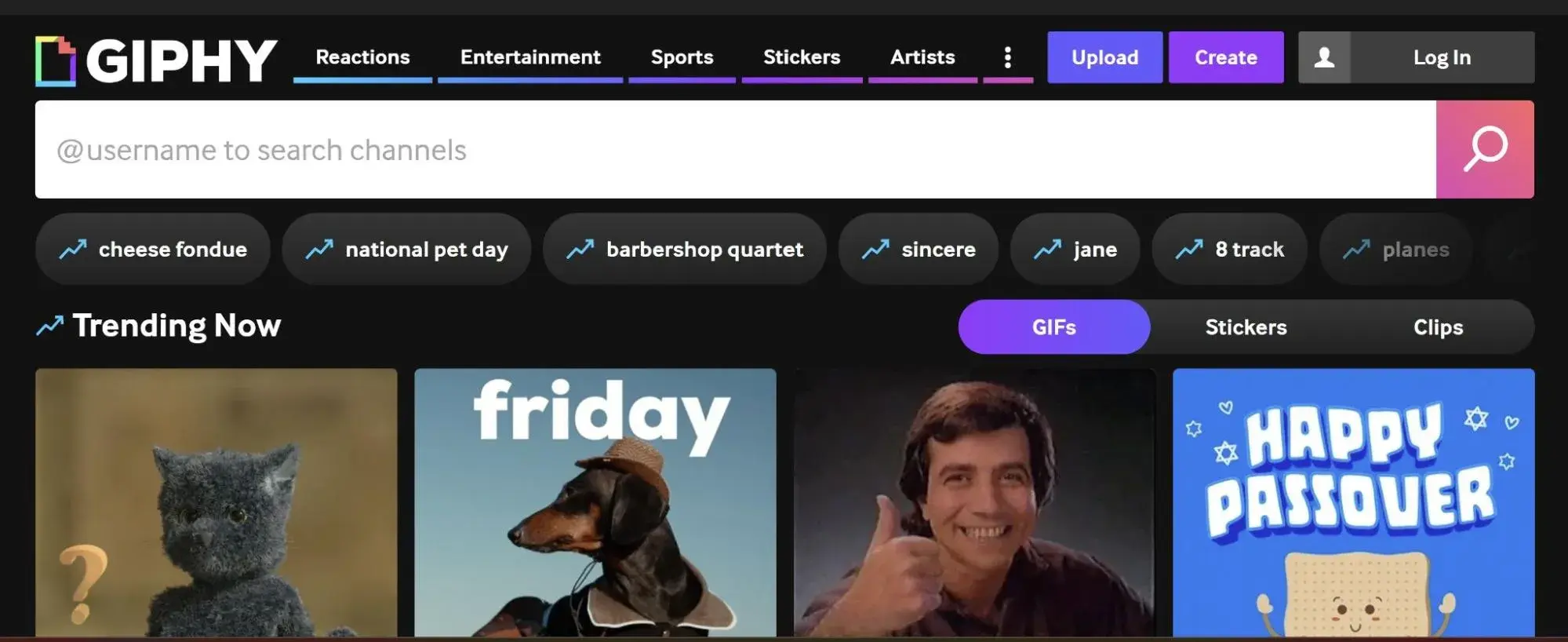
What I love: Giphy is essentially Google, but for GIFs. Just type in the show, movie, emotion, or vibe you’re looking for and see what fun GIFs pop up.
19. Adobe Express
Adobe Express is an online design tool for creating and sharing graphics, web pages, and videos. It offers access to thousands of images and icons, as well as branded templates, themes, fonts, and other design assets.
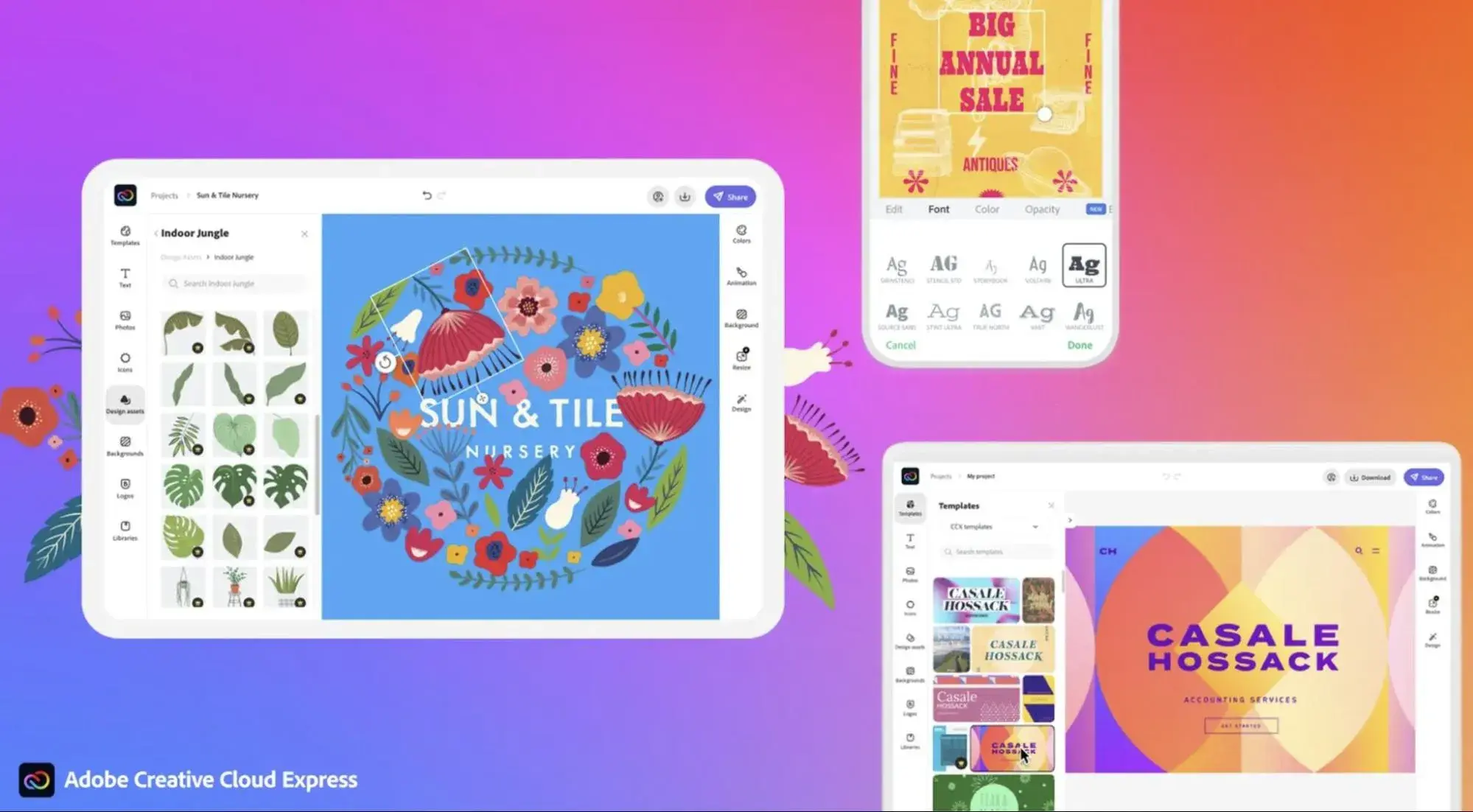
What I love: Adobe Express is great for people who are creating images on a budget and don‘t have the editing knowledge you’d typically need for applications like Photoshop.
20. VSCO
Just imagine: You‘re at an event. You’re laptop-less. And you just took an awesome photo with [insert esteemed thought leader here] that you want to share on social media… but it’s a little dark. Bummer.
With a mobile photo editing app like VSCO, you can tweak your photo to perfection and share it on the fly. The app is free for iOS and Android and comes equipped with impressive, professional-looking filters and functions.
What I love: You edit videos from pretty much anywhere with VSCO, making it efficient and convenient.
Stock Photo Resources
21. Vecteezy
If you’re looking for a Creative Commons image but are finding terrible options through its native search engine, check out Vecteezy. While it often surfaces similar content, Vecteezy has an algorithm that places the gorgeous images right at the top — cutting my image-hunting time down by a ton.
What I love: Vecteezy is easy to navigate and a huge time saver.
22. Death to Stock
All it takes is an email address to start receiving Death to Stock‘s high-quality photography straight to your inbox every week. From office shots to drool-inducing food plates, this stock photo service has a batch of photos to meet almost anyone’s needs.
These images can be used on your website, social channels, mockups, etc. To get familiar with their terms of service, check out their licensing page.
What I love: Death to Stock constantly updates its collection of media, so there are always new elements to choose from.
23. Stock Photos From HubSpot
If you‘re looking for stock photos to use in your next design but don’t want to worry about all that attribution stuff, well, look no further. HubSpot offers a ton of free stock photos that you can use literally anywhere.
What I love: All you need to do is download the batch and then be on your merry way to create engaging, visual content. Seriously… just do it.
24. Unsplash
If you’re looking for more “do whatever you want” photos with a scenery or inanimate object tilt, check out Unsplash.The pictures speak for themselves — so go check out the website for more.

What I love: Just like our own stock photos, no attribution is needed.
Design Tools for Infographics, Charts, and Mockups
25. Infogram
If you’re looking to make interactive infographics — not just plain visuals — check out this online design tool. Easily add graphs, maps, text, and even playable videos without diving deep into a design program.
What I love: It also has social sharing tools built right into the infographic, so you don‘t have to worry about creating a custom Pin-It button. It’s a pretty nifty tool if you want to create and ship an infographic — fast.
26. Venngage
Venngage is a free infographic maker that has the capability to produce charts, reports, and stunning data visualizations. You can start with a template and easily customize the look to fit your brand.
Under the free plan, you’ll be limited to the number of image uploads and designs you can do, but there are more advanced plans with premium feature sets.
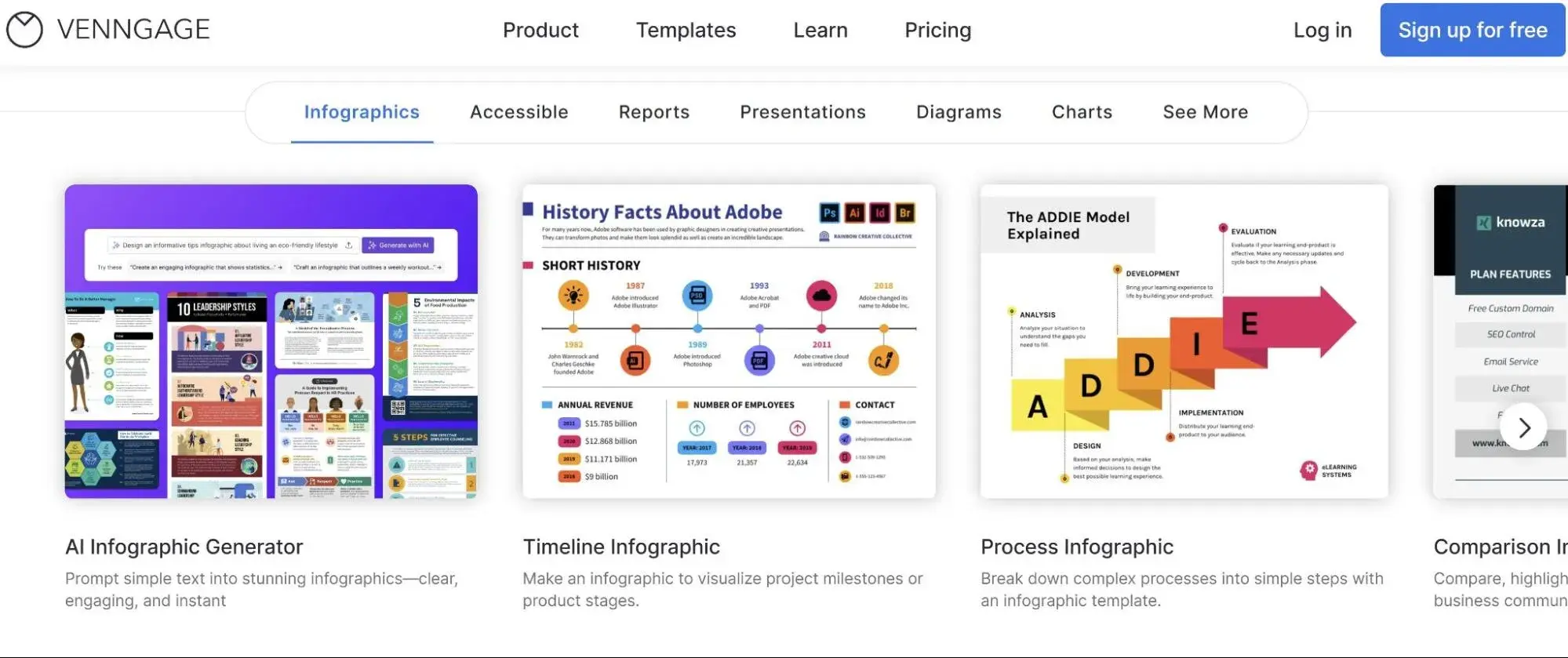
What I love: With highly customizable templates and AI-powered features, what’s not to love?
27. Visme
With Visme, you get a whole platform for creating digital content with capabilities for presentations, data visualization, infographics, social posts, and even short videos.
What I love: You can have up to 5 projects and 100 MB of storage in the free version, plus access to a library of free templates for projects such as ebooks, flyers, and logos.
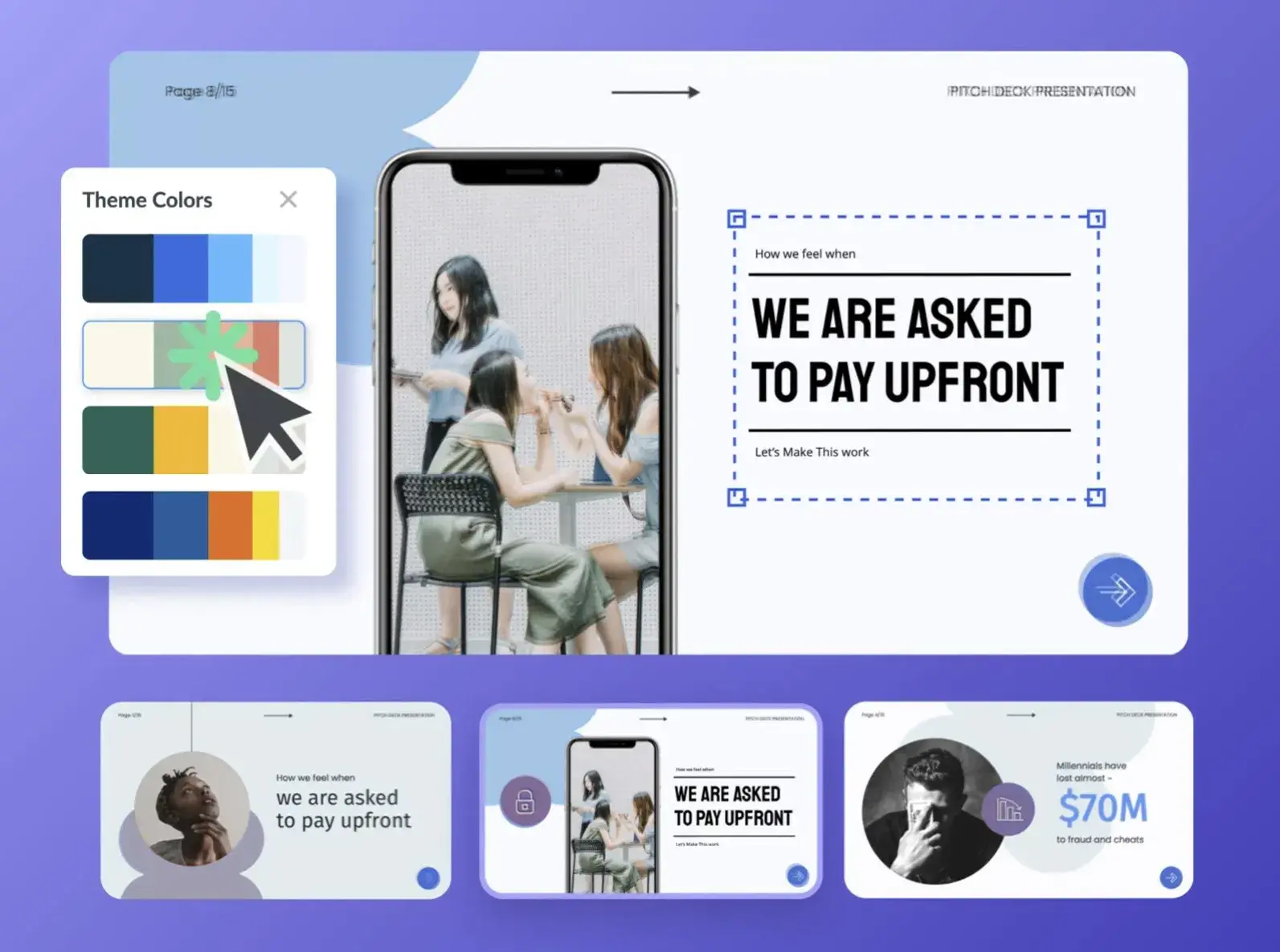
28 Miro, 29. Marvel
Depending on the sophistication of your design needs, you may find yourself in need of a prototyping app. This type of software can be used to turn your ideas — whether it be an app or a website that you’ve cooked up in your head — into a more tangible reality.
While many free options are available, we’ve selected two that really deliver in terms of ease of use and functionality: Miro and Marvel. Although both of these options offer more advanced, paid plans, you can get started with a free plan.
Time to Content Create
This list shows just a few possibilities for tools and templates that can help you create high-quality, engaging visual content for your brand. Now, you can go try some out for yourself.
Editor’s Note: This post was originally published in September 2013 and has been updated to be fresh, accurate, and comprehensive.
![]()

The Future Consumer: State of Consumer Trends in 2025 [Data from 700+ Consumers]
From the rise of AI to shopping on social media, times are changing fast. Some consumer trends are a flash in the pan, but others represent a permanent change in buying habits. If your business doesn’t keep up with the latter, you could get left […]
MarketingFrom the rise of AI to shopping on social media, times are changing fast. Some consumer trends are a flash in the pan, but others represent a permanent change in buying habits. If your business doesn’t keep up with the latter, you could get left behind.
To help marketers and business owners stay ahead of the curve, we’ve surveyed 700+ U.S. adults for HubSpot’s annual Consumer Trends Report. Keep reading to keep a pulse on:
- How consumers spend their time online.
- How and where they prefer to shop.
- Which standards they’re holding their favorite brands to.
Meet the Future Consumer
I spent a few hours digging through HubSpot’s survey results to uncover the top consumer trends in shopping, customer service, and technology. With voices and responses from over 700 people, here’s what I found.
The future consumer is digitally savvy, preferring mobile commerce and social media platforms for product discovery. Younger generations prefer influencer recommendations and short-form video content to get ideas and inspiration. Search patterns are changing, with customers starting to turn to social media and AI chat over traditional search engines.
Consumers want options from brands: More payment options and channel options for customer service. While more people are experimenting with AI, many don’t trust the tech yet.
Although convenience is important, it isn’t the only consideration for consumers. Sustainability, social advocacy, and data privacy are becoming more important for consumers making choices between brands.
Digital Media Trends
Let’s dive into these trends one by one.
1. Social commerce is growing.
Social media platforms have become a top place for people to both discover and buy products.
Our Consumer Trends Report found that social media is the top channel for product discovery for Gen Z, Millennials, and Gen X.
This can be both passive, through scrolling through posts and videos, and active — like when someone searches for a particular product.

One in four social media users (and 43% of Gen Z) have bought a product directly through a social media app in the past three months.
Of the social media platforms, Instagram, Facebook, and TikTok are the most popular for direct purchases. Some consumers remain wary, however, about subpar customer service or getting scammed by fake shops.
2. Gen Z embraces new social media platforms, while legacy platforms stagnate.
87% of U.S. adults use social media. While legacy apps like Facebook and Instagram aren’t going anywhere, they also aren’t growing like they used to. Newer social media platforms like BeReal, Twitch, and TikTok are gaining traction, while established platforms like Facebook and Instagram see slower growth.
This shift is particularly pronounced among younger users. Facebook doesn’t crack the top three platforms Gen Z uses, while TikTok tops the list. Consumers are embracing decentralized platforms like Bluesky, Mastadon, or Discord as they retreat from X.
When choosing a platform to be on, keep in mind that consumers like different social media platforms for different reasons. People like Facebook and Instagram primarily to keep up with friends and family, while they pick up YouTube and TikTok to be entertained.

3. Search behavior is changing.
While traditional search engines remain dominant, social search and AI are disrupting the landscape.
Google enjoyed 90% of the search engine market share from 2015 to 2024, but in January 2025, the giant’s monopoly dipped below 90% for the first time in a decade. The reasons for this are three-fold:
- The rise of alternate search engines. Small numbers of users are migrating to privacy-centric search engines like DuckDuckGo and Bing.
- AI-enabled search. Rather than turning to Google, consumers are starting to search for products and ideas on apps like ChatGPT or Perplexity. Experts expect ChatGPT alone to take 1% of the search market in 2025. Our survey found that 72% of consumers plan on using gen AI-powered search for shopping in the future. Of those already using it, 79% said their experience was better than shopping experiences with traditional search.
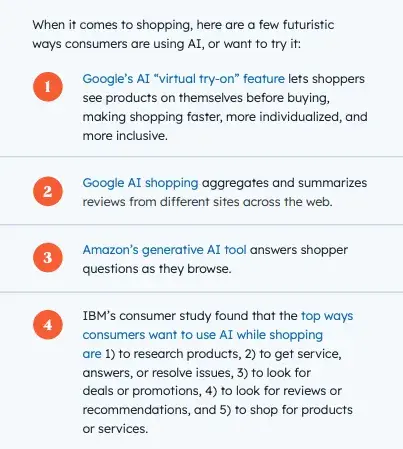
- Social product discovery. As I’ve already covered, younger consumers are turning to social media platforms to find inspiration and products. 36% of social media users say they search for brands and products or services on platforms, and 24% search for local shops or businesses. 18% of consumers (and 31% of Millennials) say they turn to platforms like YouTube to search for answers to questions instead of Google.
4. Economic uncertainty means tighter budgets.
Most businesses aren’t sure what to make of the economy in 2025. Consumers aren’t either. While people we surveyed disagree about whether we’re in a recession, the impact is real: 47% say they’ve taken steps to prepare for a potential recession.
Here’s how that translates to spending: 55% of people say they’re tightening their budgets because of current economic conditions, while just 11% say they’re loosening them. This doesn’t mean consumers aren’t spending — they’re simply prioritizing intention and necessities over impulse purchases.
5. Data privacy reigns.
75% of consumers now believe that data privacy is a human right. While data protections are much stricter in Europe than in the U.S., consumers are making their preferences known.
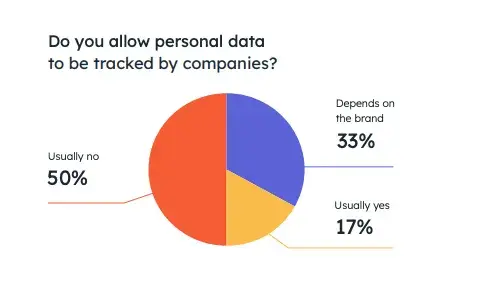
We asked what would make consumers more comfortable sharing data with companies, and it comes down to trust, transparency, and security.
Of consumers, 75% want to be in control of what’s happening with the information they provide — what data is collected, how it’s used, and with whom it’s shared.
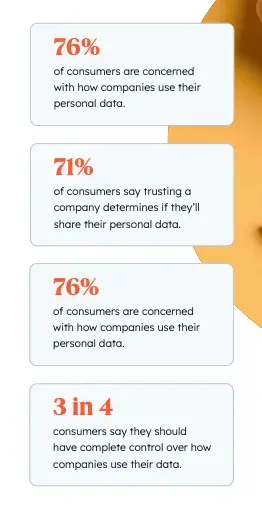
6. Consumers are divided on social advocacy from brands.
Consumers are divided about the role companies should play in social advocacy. There are large differences of opinion on whether companies should be vocal on social issues or stay out of it: 43% say brands should not take a stance, while 36% say they should.
Take a look at Target, for example. The retailer was one of the most outspoken advocates of DEI during the Black Lives Matter wave of 2020 and 2021. In early 2025, Target dropped its DEI initiatives, sparking praise from a few but a large outcry and a 40-day boycott from many longtime customers.
The top issues consumers want to hear about are affordable healthcare, climate change, and income inequality. 55% of consumers believe companies should advocate for racial justice, while just 15% say they shouldn’t.
Speaking out can be a gamble — but so can staying silent. The key is to know your audience well so you can follow their lead and act on the values that are important to your brand and leadership.
7. Green is the new black.
Sustainability is a non-negotiable expectation for products and services across all industries. Consumers are increasingly prioritizing sustainability in their purchasing decisions.
In fact, 58% of consumers globally are willing to pay more for eco-friendly products, with Millennials (60%) and Gen Z (58%) leading this trend. Brands that emphasize transparency in sourcing and production are likely to gain a competitive edge in 2025.
8. AI as a personal assistant.
AI is becoming the ultimate personal assistant, offering personalized and predictive solutions in our personal and professional lives. When I need to find an appropriate product, check on an order status, or file an insurance claim, I can often do it 24/7 through an AI assistant.
This matches the trend of self-service that I’ve seen growing for some time. Our research found that when researching a brand or product, 59% of consumers prefer to gather information themselves rather than speak to a human. They also expect immediate problem resolution on the channel of their choice.
This doesn’t apply just to shopping, but to customer services and sales. If you haven’t already, consider setting up an AI assistant or chatbot to help consumers answer basic questions, request customer service help, or schedule appointments.

9. Make it omnichannel.
Customers want a seamless integration of digital and physical shopping experiences, across multiple channels. They expect ultra-convenient, frictionless experiences in every interaction with brands and services.
For example, if I chat with a business on Facebook Messenger about a return, I expect them to be able to pull up my order. On the business side, we call this omnichannel experience.
Here are the channels that customers prefer for interacting with brands:
- Phone (49%)
- In-person at a physical store (44%)
- Email (32%)
- Live chat tool/chatbot (25%)
- Text message/SMS (22%)
That’s a tall order for businesses to serve customers through all of those channels and keep the context and level of service the same across each one.
So, what does it take to create an omnichannel experience? You need an integrated platform that can sync customer data across channels and equip marketing teams, customer service reps, and AI assistants with the context and agency they need to serve customers’ needs.

10. Mobile commerce dominates.
Big purchases call for big screens? Not anymore. It comes as no surprise to me that mobile commerce now dominates online shopping.
Consumers HubSpot surveyed said they use mobile phones more than any other device for online shopping and when searching for questions online. That’s particularly true for Gen Z, of which 81% use their phone as their primary shopping device.
11. Memories over materials.
Have you asked for an experience gift like a concert or class for Christmas? Or contributed money to someone’s honeymoon fund instead of a wedding gift?
Americans are increasingly valuing experiences over material goods, with 58% preferring to spend money on experiences — 14% higher than the global average.
This trend is driving growth in sectors like travel, entertainment, and experiential retail as people seek meaningful, shareable moments rather than accumulating more stuff.
12. Influencers are here to stay.
In 2025, 29% of people say they’ve discovered a product through an influencer on social media.
Gen Z social media users say that influencer recommendations are more impactful than family and friend recommendations, though their elder generations disagree.
The number of people who consider themselves influencers is surprisingly large: 21% of people — and a whopping 45% of Gen Z and Millennials — consider themselves influencers or content creators.
24% of brands work with influencers for campaigns, and most say that it’s an effective marketing strategy. Brands have found particular success with micro-influencers with a niche audience and 10,000 to 99,999 followers.
13. AI adoption is growing, but trust remains low.
AI adoption is becoming widespread, but consumers are still skeptical. We found that one in three consumers uses AI tools like chatbots and ChatGPT, but trust is still low. 17% of customers “strongly distrust” and 16% “somewhat distrust” AI tools, while 35% neither trust nor distrust them.
That means that as you roll out AI tools, you’ll need to work hard to build trust and communicate with transparency.
14. Pay how you want.
With the explosion in payment methods from Venmo to CashApp to Zelle to even cryptocurrency, consumers want the convenience of alternate payment methods.
There’s also a trend that customers don’t want to pay just once upfront. Our survey found that just 63% want to pay for a product at full price. Alternately, 21% want to pay in installments (Buy Now Pay Later or BNPL), and 17% prefer a subscription model. Research shows that 8% of consumers already use BNPL, and 31% pay for a digital streaming subscription.
To stay competitive, consider expanding the payment options you accept.
15. Consumers crave authentic content.
Surprise! People actually want to see your content. But — and here’s the catch — they want it to be authentic and relatable. Almost two-thirds of consumers say it’s more important for marketing content to be authentic than polished.
While it’s good news that you don‘t need a huge budget to woo your audiences, you will need to create content they’ll actually enjoy, keep their attention on, and be persuaded by.
Videos and images are a great way to connect authentically with your customers and showcase the people behind your brand. Here are the types of content that customers say they enjoy the most:
- Images/photos/infographics (52%)
- Short-form video content like TikToks and Reels (45%)
- Live videos/live streams (35%)
- Long-form video content (24%)
Dive Deeper Into Consumer Trends
In the post above, I gave just a few highlights of our State of Consumer Trends Survey, as well as predictions for what’s to come. Want to explore the latest Consumer Trends report and see how trends have changed over time? Click below to download the full findings of that survey in our State of Consumer Trends Report.
Editor’s note: This post was originally published in May 2022 and has been updated for comprehensiveness.
![]()
B2C Sales: A Comparison With B2B and How to Do Them Right
Throughout my career, my sales experience has been rooted in B2B SaaS. I understood, in theory, the differences between B2B vs. B2C sales, but I didn’t truly grasp the reality until I had the chance to sell directly to a customer for the first time. […]
SalesThroughout my career, my sales experience has been rooted in B2B SaaS. I understood, in theory, the differences between B2B vs. B2C sales, but I didn’t truly grasp the reality until I had the chance to sell directly to a customer for the first time.
Suddenly, I was in an entirely different arena. Gone were the long sales cycles, the decision-making committees, and the endless follow-ups. Instead, I was speaking to individuals, making split-second connections, and tapping into emotions rather than logic. What was once a strategic, process-driven approach had transformed into a fast-paced, emotionally charged interaction.
I was selling a subscription to a digital product, and during training, we were handed a pitch that was supposed to “work.” At first, I stuck to the script. But, I quickly realized that I had far more success when I focused on sparking an emotional response rather than following a rigid formula.
In this article, I’ll break down the key differences between B2B and B2C sales from what I have learned. More importantly, I’ll show you how to succeed in B2C (because, trust me, it takes a lot more than just a great product).
Table of Contents
- B2B vs. B2C Sales
- Defining B2C: How B2C Companies Sell to Consumers
- The Difference Between B2B and B2C Sales
- B2C Engagement
- B2C Sales Tips
Defining B2C: How B2C Companies Sell to Consumers
B2C stands for business to consumer. B2C sales is the sale of products or services to individual consumers, through a third-party website, in-person, or online.
In B2C sales, you might be selling a single product or many products within a single category. Or, you might work with a brand like Amazon that sells many different kinds of products. B2C sales roles sell for direct-to-consumer (DTC) brands. They also help B2C sellers who work with other businesses before they connect with their customers.
B2C ecommerce is a popular sales spot. Per Statista, the estimated value of retail ecommerce is steadily increasing each year and will reach almost $1.8 trillion by 2028.
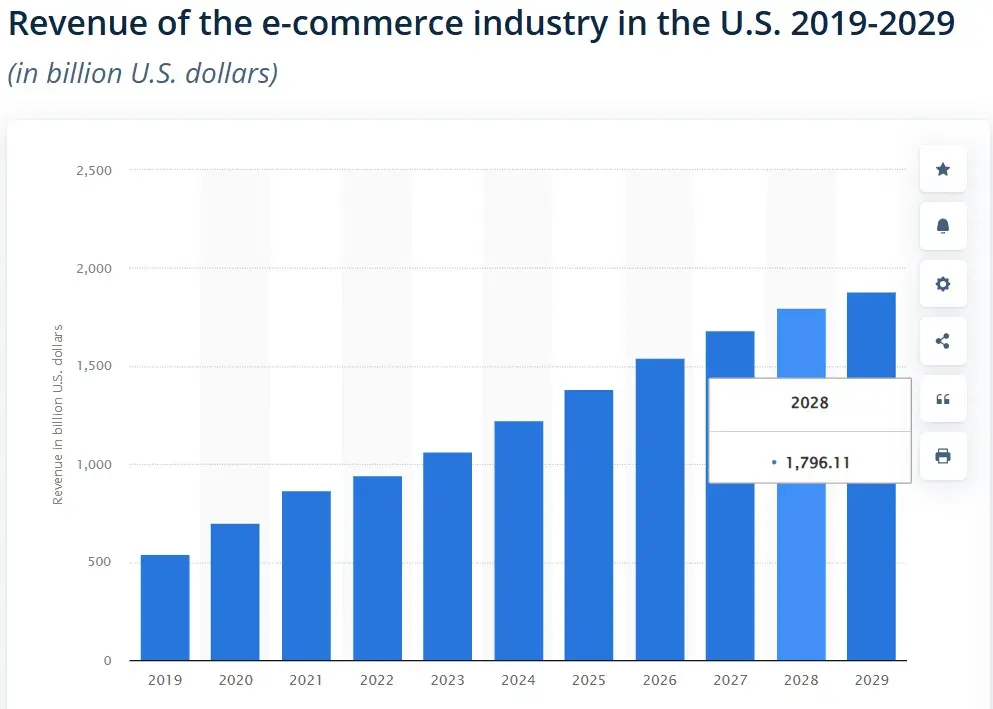
B2C sales includes:
- Retail employees at your favorite shop.
- Service professionals like those in the health and beauty industries.
- Real estate agents.
- Sales professionals at local hotels, colleges, and restaurants.
There are many different ways that businesses sell to consumers. B2C businesses include:
- Direct sellers. These include retailers like Nike who sell their branded products directly to customers. It also includes stores like Target that sell their own products as well as products from other brands.
- Online intermediaries. Sites like Amazon and Etsy are B2C businesses that sell products from a range of brands to consumers.
- Services. Hotels, colleges, and gyms use B2C salespeople to encourage users to buy and continue using their services.
- Subscription services. Another framework for B2C sales is subscription services, which means buying goods or services on a regular, renewable basis. Think about Spotify, Netflix, or HelloFresh.
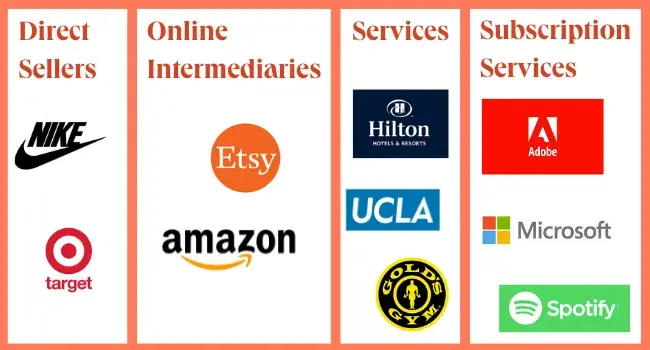
Because marketing plays such a big role in B2C, sales in B2C are often overlooked. Instead, B2C sales is often defined in comparison to B2B sales.
There are many overlaps in B2B and B2C sales. In fact, many businesses have both B2B and B2C sales teams within the same organization.
For example, a hotel will have a B2C sales team that works with individual or small groups of travelers to book travel and events. At the same time, their B2B sales team will work with corporate groups to negotiate rates. This team may also develop wholesale relationships with booking agents and travel agencies.
There are also similarities between B2B and B2C sales. To be effective in sales, you must:
- Ask the most crucial question: “Why do I deserve the business of a potential customer?”
- Step into your customer’s shoes, evaluate their needs, and ensure that the solution you’re offering genuinely addresses their needs.
- Develop a strong relationship and clear communication with your marketing team.
- Have a clear understanding of your business’s sales process and strategy.
- Know how to analyze and use consumer data.
- Encourage consumers to promote products after purchase.
- Understand and develop customer service skills.
- Offer multi-channel service and engage with consumers where it’s most convenient for them.
Though there are many ways these two approaches to sales are alike, let’s talk about some key differences.
The Difference Between B2B and B2C Sales
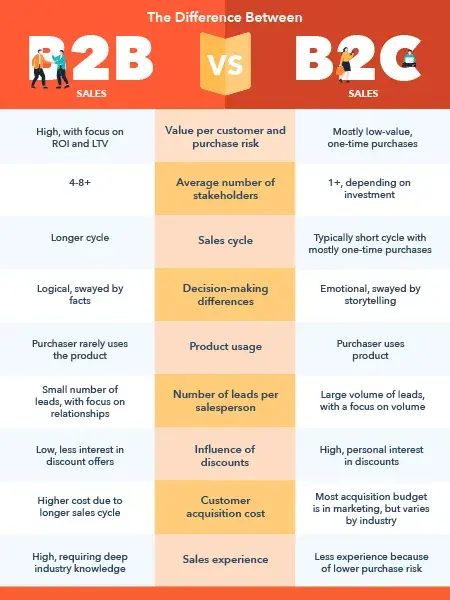
Using Partners to Approach Customers
B2B Sales
During my time in B2B sales for a tech company, we had a promising potential client who was highly interested in our product after a successful demo. However, despite their enthusiasm, the deal kept stalling due to a lengthy bureaucratic approval process.
At some point, we discovered that this client was already working with one of our technology partners. Recognizing an opportunity, we reached out to our partner, who then introduced our product to the client within their existing business relationship. This endorsement provided the credibility and push needed to finalize the sale.
By sharing this experience, I am trying to reinforce the power of partnerships in B2B sales. Collaborating with established partners builds trust, accelerates decision-making, and ultimately helps close deals more efficiently.
B2C Sales
Unlike B2B, B2C sales mostly involve direct engagement with individual consumers. Since the decision-making process is more personal and immediate, B2C businesses focus on marketing, customer experience, and direct sales channels rather than leveraging partnerships to approach customers.
After-Sales Customer Service
B2B Sales
In B2B, especially when selling tech products, strong after-sales support is an added benefit. Businesses often require feature modifications, troubleshooting, and ongoing training to fully integrate the software into their operations. A well-supported client is more likely to continue using the product effectively and see its long-term value.
Even though after-sales service wasn’t part of my official job description, I made it a habit to check in with my point of contact. Not only did this strengthen my relationship, but it also created opportunities for potential upselling.
Pro tip: Staying engaged post-sale ensures the business remains satisfied and reinforces trust in your company.
B2C Sales
While customer service exists in B2C, it operates differently compared to B2B. After-sales support is often not directly linked to sales, and it usually serves as a separate department in the company.
Individual purchases tend to be lower in complexity and value (more on this in the next point). For fast-moving consumer goods, customer service is almost nonexistent, as products are designed for quick, hassle-free consumption with minimal follow-up required.
Value per Customer and Purchase Risk
B2B Sales
B2B products are often high in value. B2B consumers usually want to know the return on investment (ROI) and lifetime value (LTV) before deciding to take the risk or limit it.
B2C Sales
B2C products and services usually have lower prices than B2B products. This is because many B2C products involve one-time quick purchases, and it doesn’t always take a salesperson to close a deal.
Focus as a Salesperson
B2B Sales
B2B sales will work with a larger number of stakeholders. During the sales process, B2B sales may need to sell their products and services to many people in an organization.
This might include:
- Decision-makers
- Gatekeepers
- Department leaders
- Subject matter experts
- Policy experts
This complexity can make it challenging to stay focused during the sales process. For instance, I once participated in an online demo for a leading U.S. space agency, where over 15 people were on the call. No one had their cameras on.
Establishing a connection felt nearly impossible, and I later discovered that many attendees were neither decision-makers nor end users. In such scenarios, the conversation feels less impactful, and it’s harder to drive the sale forward.
B2C Sales
In contrast, B2C sales involve individual customers who typically navigate the buyer’s journey independently. For high-value purchases like cars or homes, they may seek input from partners, friends, or family, but the decision-making process is generally more straightforward than in B2B sales. The focus for a salesperson in B2C sales is usually always the end consumer.
Sales Cycle
B2B Sales
The sales cycle in B2B is significantly longer and more involved. It often includes numerous steps such as lunches, pitches, product demos, and multiple rounds of discussions.
In my previous role, I was sent by the company to various cities to attend tech conferences and connect with potential customers. I recall a three-day event where, after several discussions with a prospect, he expressed interest in meeting with senior leaders from my team.
By the time we managed to schedule and hold that first meeting, two weeks had passed. By sharing this experience I mean to highlight how crucial patience is in B2B sales and how it’s normal for things to take time to align.
Pro tip: As the sales cycle is relatively long in B2B, I suggest spending more time trying to sell directly to C-level executives and decision-makers. It’s helpful to remember that 57% of C-level and VP buyers prefer to be contacted by phone.
B2C Sales
B2C sales typically feature a quicker path to purchase. While consumers may rely on reviews, their buying decisions are often faster, especially in retail. B2C sales cycles are generally more impulsive, with customers making quicker decisions compared to the extended, methodical processes in B2B.
Marketing plays a significant role in getting B2C customers onto lead lists, with social channels, affiliate programs, and ads contributing to brand awareness. Once the customer is engaged, the sales process tends to be much faster.
Success as a Salesperson
B2B Sales
In B2B sales, success doesn’t come easily. It requires a significant investment of time and effort to establish a reputation in the industry. I remember when I first started at the tech company, I was the least experienced salesperson on a team of eight.
My first major challenge was responding to an RFP from a large oil and gas company. The document shared by that company was hundreds of pages long, and as part of my role, I had to craft a proposal that demonstrated how our solution could meet their needs.
I spent a lot of my early days working on this. Naturally, I wasn’t producing immediate sales results. It was a humbling experience that reshaped my expectations of success in the B2B sales process.
B2C Sales
It’s easier to demonstrate your ability as a salesperson in B2C sales. From a career’s point of view as well, B2C sales is more approachable and easier to enter. With shorter sales cycles and less complex decisions, sales are typically easier to achieve. So, it’s simpler to showcase your effectiveness and prove you can excel in the role.
Decision-Making Differences
B2B Sales
B2B purchases present more risk to the business. They often have the potential to disrupt systems and processes that the business relies on. To convince a range of stakeholders, facts are usually the most effective strategy.
Customer testimonials play a more significant role in establishing credibility. Also, certain social media platforms play a role in reaching a decision. For instance, YouTube is a key resource for B2B buyers, with around 65% relying on it for purchase insights.
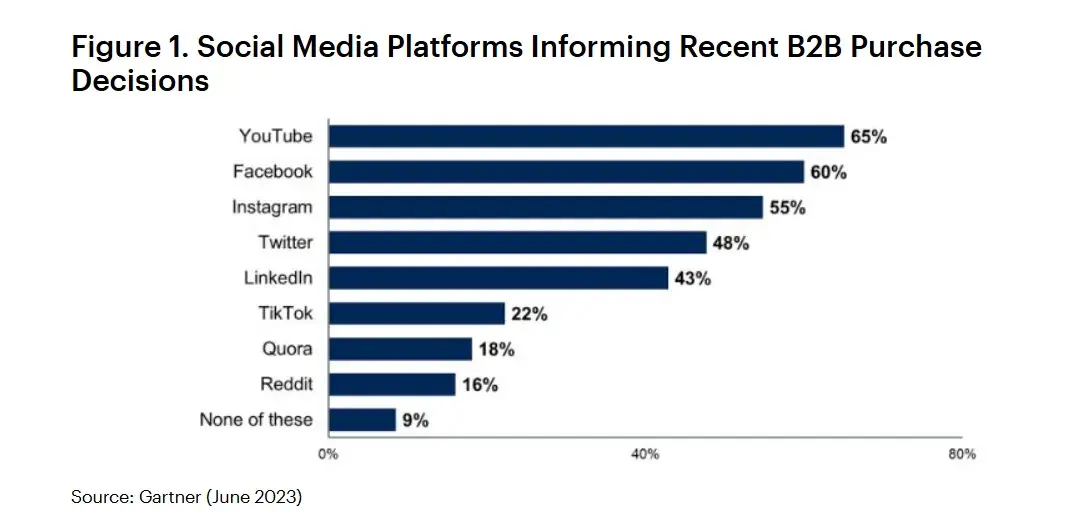
The buying process in B2B is more calculated and deliberate as it’s likely to have an impact on their long-term decisions.
B2C Sales
A B2C buyer is often resolving an urgent need. Because of this, B2C sales are often emotional or impulsive. So, B2C sales reps often need to compete with word-of-mouth, habits, cravings, and advertising to get a consumer to switch brands.
For expensive or long-term purchases, like choosing a college or planning a wedding, B2C consumers may approach the buying process more like B2B buyers.
Product Usage
B2B Sales
Most B2B buyers are purchasing on behalf of their business. This means that a committee makes most decisions, not the people who use the product.
Because of this, a B2B salesperson may need several different strategies for selling a single product.
B2C Sales
B2C buyers are buying for themselves. This means that sales strategies will target the individual and the needs that they share at the moment.
Number of Leads per Salesperson
B2B Sales
In B2B, there is usually a smaller number of potential business leads, and salespeople spend more time with each lead. I feel that is great because they know how to focus their sales efforts.
But it‘s a challenge because the long cycle and defined lead pool give competitors more chances to break in before you close a sale.
B2C Sales
B2C sales may have a base of millions of potential customers. Sales and lead volumes are high, but the leads aren’t always the right fit.
It’s often a B2C sales job to identify the right leads, and time management is key. The more time you spend on a lead that won’t close, the less likely you are to meet your sales goals.
Influence of Discounts
B2B Sales
Because most B2B buyers are purchasing on behalf of their company, they have a budget to work with and usually an internal approval process. This might mean a slow timeline but less interest in discounts.
B2C Sales
A B2C consumer usually buys with their own money, so they tend to invest more in discounts. This is especially true in industries where discounts are the norm, like travel and hospitality.
Customer Acquisition Cost (CAC)
B2B Sales
The high price point and low number of quality leads in B2B sales usually demands a higher cost of acquisition. Because B2B deals involve longer sales cycles, extensive nurturing, and multiple decision-makers, companies must invest heavily in personalized outreach, account-based marketing, and sales team efforts.
I suggest checking out this post on the differences between B2B and B2C marketing to learn more.
B2C Sales
Most of the CAC in B2C goes toward marketing. Businesses can rely on digital marketing strategies such as social media posts and influencer collaborations to attract and convert customers at scale. B2C sales in industries like travel and education may have a higher CAC.
Sales Experience
B2B Sales
B2B salespeople are working with experts in their industries and selling complex products and services. The sales experience is derived more by the depth of industry knowledge, the ability to provide tailored solutions, and the strength of relationships built throughout the process.
I believe that nowadays social selling is a game-changer. Research shows that sales leaders who embrace social selling are 51% more likely to hit their quotas than those who don’t. Even more compelling, 78% of social sellers outperform their peers who aren’t constantly active on social media.
I suggest going to this article if you want to learn more about rocking the B2B sales experience.
B2C Sales
B2C sales are generally simpler and more transactional. Many B2C brands have embraced meme marketing to boost engagement and build brand recognition. As there’s a big overlap between B2C marketing and sales (more on this below), I think the sales process has also become more casual.
For example, a brand that adopts Gen Z language to connect with a younger audience instantly feels more relatable. Also, as most B2C purchases involve lower risk, there’s typically less need for an in-depth sales strategy or extensive buyer nurturing.
How different are B2B and B2C sales really?
The creator economy and the rise of B2B ecommerce have blurred some of the lines between B2B and B2C sales in the last several years. Consumers today have more direct access to products and services than ever before.
These shifts mean that both B2C and B2B salespeople need to be flexible and adapt themselves to the changing market. Many B2B companies have also started operating on the emotions of a smaller group of individual leaders. So, businesses now make quicker and more emotional investments than businesses of the past.
B2C Engagement
Whether you are selling cars, houses, or gym memberships, B2C engagement depends on what is being sold and who is selling it.
But, I think there are a few common challenges in the B2C sales process that you can tackle to improve engagement.
Prevent lead leakage.
Because B2C salespeople get leads from a variety of sources, they run the risk of losing leads quicker than they can contact them.
For example, an online lead may be easy to convert, but a drop-in or offline lead may get lost in the shuffle of everyday tasks. Check out this resource to make the most of your sales pipeline.
Nurture leads at every stage of the buyer’s journey.
The high volume of incoming B2C leads makes it difficult to keep nurturing leads who are further down the pipeline. Time management and prioritizing is essential. These skills can help you keep quality leads engaged and assess whether incoming leads can return value.
Stay organized.
Keeping your notes in a single system like the HubSpot CRM platform makes it easier to create and review notes, then quickly return customer calls.
I’ve found that adding a CRM can also help your business collect more reliable data to update your outreach strategies.
Know your product.
Many sales reps stop learning after their initial training. But, continuous training is important for salespeople to set expectations for consumers. Product knowledge is more than closing a deal — it’s about delighting your customers.
Let’s talk about how to excel at B2C sales.
B2C Sales Tips
1. Understand who you’re selling to.
I highly recommend having a solid picture of your target demographic when devising your B2C marketing and sales strategies. You’ll waste a lot of time, effort, and money trying to indiscriminately appeal to anyone and everyone. Do some research, understand your customer base, and develop detailed buyer personas.
As per HubSpot’s definition, a buyer persona is “a semi-fictional representation of your ideal customer based on market research and real data about your existing customers.”
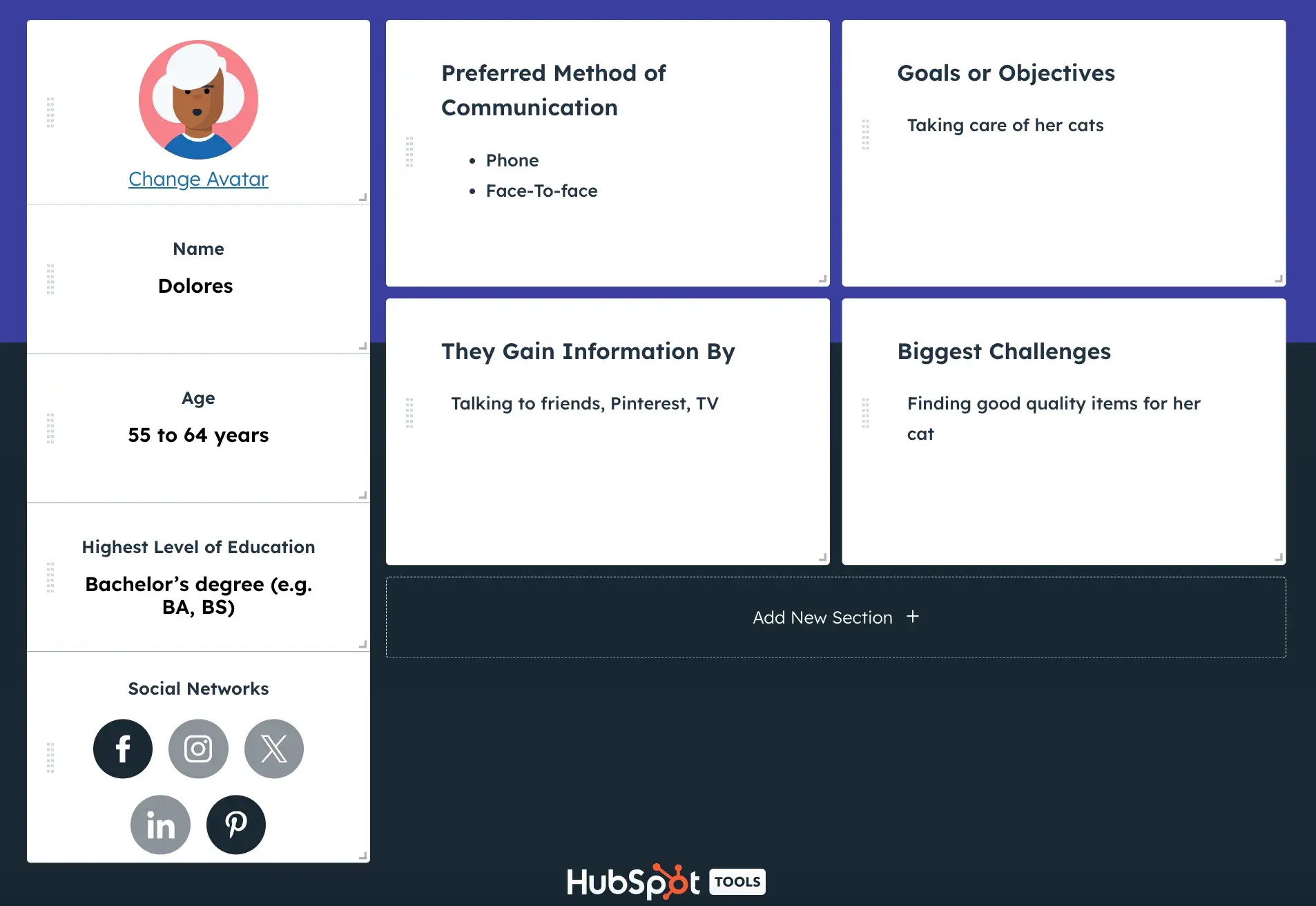
Make your buyer persona today!
For instance, say I knit and sell kitten sweaters. I notice that 50-to-70-year-old cat lovers from rural areas make up a significant part of my business. I use that information to develop a buyer persona specific to those qualities.
That base is probably going to gravitate toward a different brand of sales than young professionals in their twenties. My experience with B2C sales has made me understand who I’m appealing to, so I tailor my messaging and sales pitches accordingly.
Pro tip: Use the Make My Persona tool to create custom buyer personas for your target products and services. Using this persona, remember important details while you’re working with customers.
2. Establish rapport if you’re selling face-to-face.
If I am personally interfacing with my customers, I’m going to need to put them at ease and earn their trust throughout the sales process. I do this by understanding their needs and sell on that basis.
B2C selling is personal. I’m convincing a single consumer to spend their own money to accommodate their individual needs. That means I have to give them a personal stake in my pitch and messaging. The best way to do that is to let them know that I’m invested in their best interests.
Offer thoughtful insights and direct your conversations without dominating them. Be authentic. And do what you can to make your customers understand that you have both the know-how and genuine desire to solve their problems with your product or service.
Pro tip: The goal is to increase the chances of building rapport and talking to the right person. For a more in-depth look at needs-based selling, check out this article.
3. Bolster your ecommerce presence if your business is online.
If you think most of your business will happen online, I recommend keeping track of your ecommerce conversion rate. That figure is the most crucial metric in determining the health of your online business and the efficacy of your online messaging.
Having a great product or service is one thing. Making it readily accessible and attractive for purchase is another.
To improve your B2C sales online, you should look into taking steps like:
- Adding explainer videos to your product pages.
- Giving visitors a clear and attractive set of product images.
- Adding web chat features that allow customers to ask product questions online.
It can only help to take these kinds of strides. Giving your prospective customers a smooth, accessible user experience on your site is a great way to improve your online B2C sales.
Pro tip: Business analytics can help you add urgency to your favorite selling points. This quick, free analytics course can help you use your consumer data for more effective selling.
4. Follow up with and delight both new and existing customers.
When I land a new customer online, I send them an email to let them know I appreciate their business. I assure them that I’ll be there for them from then on out. And, I try to address any issues they may have with their purchase.
Pay special attention to your existing customers. Let them know you’re still thinking of them well after you’ve earned their business.
My advice would be to consistently contact them without badgering them. Carefully scheduled emails and promotions to your previous customers can pay off in spades.
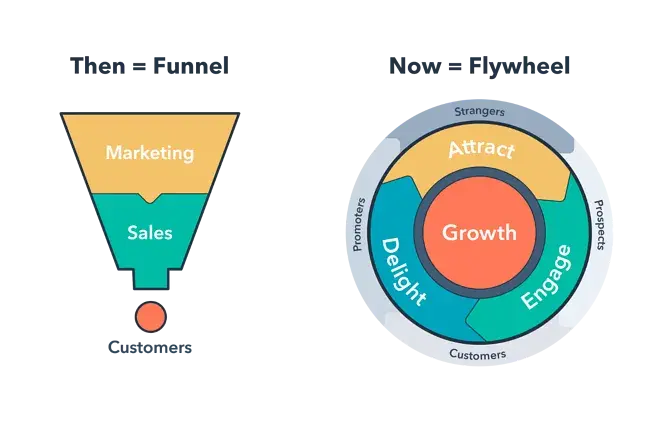
Turning one-time buyers into repeat customers leads to excellent ROI, and turning repeat customers into brand evangelists is even better. They’ll tell their friends and family about how awesome your product or service is. That means free promotion.
Final Advice on B2C Sales
Maximizing your company’s potential goes beyond just making sales. It’s also about strengthening your service infrastructure and refining your outreach strategies. I think B2C sales is challenging to navigate, but with the right approach, you can streamline the process and drive meaningful results.
Remember to stay adaptable and customer-focused. Try to foster their loyalty. Keep learning and evolving. This way, you position your business for long-term success!
This post was originally published in January 2020 and has been updated for comprehensiveness.
![]()
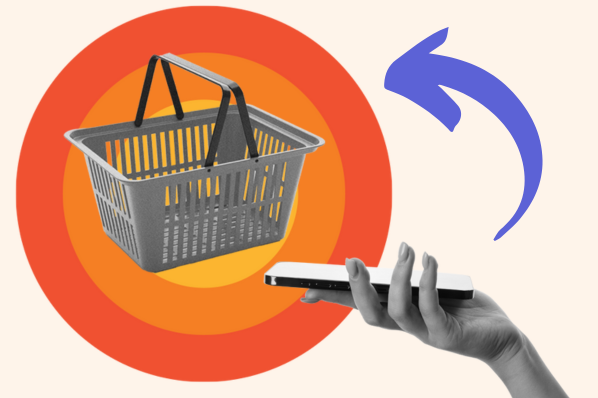
Social Media's Role in Reshaping Online Shopping, According to Retailers
Social buying. Everyone and their mama is doing it — or maybe it‘s just me and my family. I’m consistently tagged in posts (thank you, cousin) about adorable gifts, must-have outfits, and the like. Now, I’m a content marketer who knows when I’m being sold […]
MarketingSocial buying. Everyone and their mama is doing it — or maybe it‘s just me and my family. I’m consistently tagged in posts (thank you, cousin) about adorable gifts, must-have outfits, and the like.
Now, I’m a content marketer who knows when I’m being sold to, but even I get lured by social posts with irresistible products. And I know I’m not alone — as of 2024, over 110 million Americans (roughly 42% of internet users) are fellow social buyers.
So, if you’re a brand selling products to consumers and you’re not already using social selling, 2024 is a superb year to start.
Not convinced?
Let’s explore the social commerce landscape, best practices, and fun examples of brands already seeing success. Plus, I’ll share insights from experts I talked to about the future (and present-day) of social commerce.
Social Media and Online Shopping — Today’s Landscape
7 Social Media Online Shopping Trends
Tips for Making the Most of Your Social Media
Social Media and Online Shopping — Today’s Landscape
Salespeople. Marketers. Brands. They’re all jumping aboard the social selling bandwagon for good reason. Global social commerce sales could reach an astounding $2.9 trillion by 2026.
I know it’s a staggering number, but forecasts aren’t always enough to convince the gatekeepers of our selling and marketing budgets, are they?
So, let’s look at some facts and numbers straight from the horse’s mouth (buyers and brands):
- Salespeople reveal, “Our highest quality leads come from social media, so we’ll prioritize this channel.”
- Consumers say, “36% of us use social media to find new products, plus 28% of us Gen Z and Millennials purchased directly from social media apps within the past three months.”
- 80% of social media marketers agree that “consumers are buying our products directly from social apps more than they purchase from our brand websites or third-party resellers.”
- 87% percent of brands confirmed that “social selling has been effective for their business.”
- Instagram says that “71% of Gen Z are likely to buy directly from [Instagram] compared to 68% for YouTube and TikTok.”
And if that’s not enough to convince you, check out this chart illustrating how well sales improved year over year for brands using social selling.
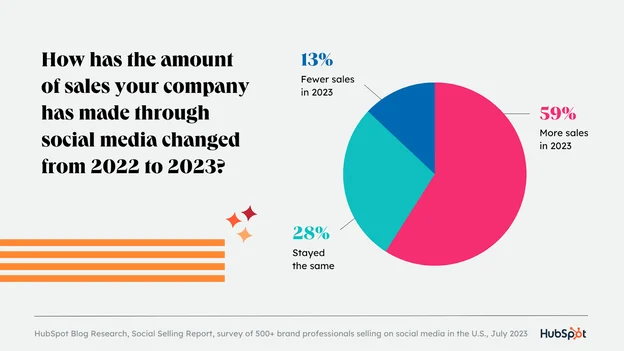
In a nutshell, social media commerce is on the rise, widely accepted by young consumers, and drives sales for brands.
7 Social Media Online Shopping Trends
What’s the secret behind the success and rapid growth of social media selling? Well, there isn’t one. Like any other marketing channel, you must monitor competitors and test different strategies.
But to give you a leg up, I gathered the top trends I’m seeing based on responses from experts and my own research.
1. Seamless In-App Shopping Experiences
As I noted above, consumers are buying from brands directly on social media platforms, so it makes sense to build a seamless in-app shopping experience for your customers.
No one wants to jump through hoops to make a purchase they thought would take only a few seconds.
But since you don’t have control over the development of these apps, or how well they’ll work for your customers, be sure to choose platforms already two steps ahead.
For example, I see social networks like Facebook, Instagram, and TikTok enhancing in-app shopping. Facebook has a marketplace and shops you can use to build your digital storefront.
(In our recent study, we found this feature to be highly important to 36% of marketers.)
Instagram also has shopping features that could be used by over 46 million American social buyers in 2024. Both Facebook and Instagram allow users to checkout directly on the platform.
TikTok Shop is also available, but has been slow to gain traction in the U.S. In the summer of 2023, it generated $3 million to $4 million daily.
If you decide to use the platform, know that users can shop from multiple brands at once and add products to a single shopping cart.
But don’t rely on platforms to deliver seamless social media shopping experiences. I recommend taking it further by creating shoppable social posts. You can also use Likeshop.me to tie your shop to your social posts.
World Market wins with shoppable Instagram posts.
Like all the decor you see in a photo-rific post on Instagram? You can buy everything in one sitting. Below is an example of a highly shoppable post from World Market created using Likeshop.me.
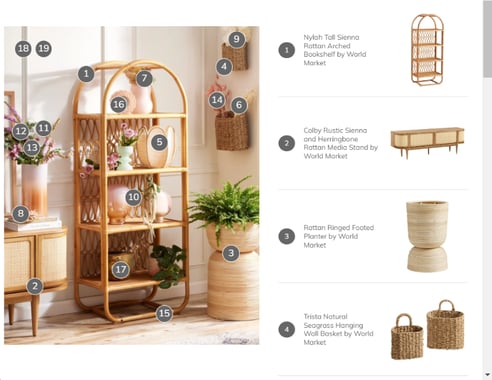
This shopping feature turns your Instagram posts and TikToks into mini-shops where you can tag and add products for shoppers to explore (and more importantly, purchase).
Gift Delivery also saw great success using shoppable videos.
“By integrating direct purchase links into our video content, we’ve made it seamless for customers to buy products as soon as they see them featured,” shares Billy Parker, Gift Delivery’s managing director.
Parker continues that preliminary campaigns with this feature yielded “a 20% uptick in sales attributed to shoppable video content alone.”
Parker also notes that “the success of these campaigns lies in their ability to not only showcase products in action but also in the convenience they offer, significantly shortening the customer journey from discovery to purchase.”
Are you wondering which platforms you should focus on?
The top social networks offering the highest ROI (according to 1,000+ social media marketers) include:
- Instagram (33%).
- Facebook (25%).
- YouTube (18%).
- TikTok (12%).
- X/Twitter (6%).
2. Short-Form Product Videos to Drive Engagement and Sales
Product demos, teasers, and similar videos are a money-maker on social media for 66% of video marketers. The beauty of this trend is that it’s short and sweet, and allows you to toot your own horn.
According to 36% of video marketers, three minutes or less is all you need. Done right, 40% of video marketers state that videos help customers understand your product better.
But how do you create engaging videos that feature your product without it coming off as an ad?
One option is to get an influencer involved. Tying social proof into the video makes it less sales-y — even more so if you partner with a small, trusted content creator (more on that later).
Examples of short video content you can create include:
- Behind the scenes (BTS). Show you’re human and relatable.
- Product teasers. Showcase a new feature or product.
- How-tos. Share a quick tip to improve a process using your product.
- User-generated content (UGC). Demonstrate how others are using your product.
- Highlight reels & montage. Show the multiple benefits of your product in action.
- Customer reviews. Leverage customer success stories as social proof.
- FAQs. Answer questions about your product.
- Influencer collabs. Partner with an influencer to feature your product in their content naturally.
You get the idea. So what does short video content look like in the real world? Let’s take a look.
Irresistible Me lets its hair down on TikTok.
Irresistible Me is a beauty company specializing in hair extensions and wigs.
“TikTok is where we let our hair down — literally! It’s all about fun, quick, engaging content,” says Irresistible Me’s Marketer Kate Ross. “We jump on trends, create challenges, and use TikTok shopping features to link back to our products. It’s like the energetic party everyone wants to be at.”
Here’s an example of a TikTok using user-generated content, or should I say influencer-generated content, with Audrey Boos.
@irresistibleme_hair The curls are unreal😱@audrey🛸
#fyp
#foryou
#foryoupage
#curlyhair
#curlyextensions
#irresistiblemehairextensions
#viral
#extensions
#trendy
♬ original sound – Stan 🙂
The video did well, with over 2K likes, 700+ bookmarks, and nearly 100 comments.
“TikTok has been huge for us. We’ve been getting creative, jumping into challenges, and teaming up with influencers who just get what we’re all about,” continues Ross. “It’s all about fun videos that show off what you can do with our products. This approach has brought a bunch of new faces to our site and helped us stand out in a pretty crowded market.”
3. More Team-Ups With Nano- and Micro-Influencers to Build Trust
I’m seeing fewer big influencers and more micro-influencers in my feeds lately. And I kinda like it. Okay, I really like it. Like most, I enjoy seeing real and relatable content creators.
It appears more brands are taking this approach, too, which is better for their bottom line — it reduces the marketing spend and potentially boosts their revenue.
Roughly 67% of influencer marketers work with micro-influencers and 24% team up with nano-influencers. The top social platforms they plan to do most of their partnerships on are:
- Instagram (27%).
- Facebook (19%).
- YouTube (18%).
- TikTok (15%).
So far, 47% of marketers report successful micro-influencer partnerships. This is not surprising when 21% of social media users between 18 and 54 buy products based on influencer recommendations.
So how can brands put this to use?
Glossier uses UGC to show how everyday women use its products.
Glossier, a renowned makeup company, regularly partners with nano- and micro-influencers. The following IG reel shows Sky Mejias applying its lip products. It’s a mix of a tutorial and social proof to get followers to give the items a try.
The video generated 320K views and nearly 7K likes, so we know it got good reach. This influencer is considered a nano-influencer since she has just over 3,500 followers.
It’s also promising that 1 in 3 Gen Zers bought from an influencer-founded brand in the past year. This proves how much our younger generation of buyers trusts influencers.
“Micro-influencers have been our secret weapon. We’ve seen incredible engagement from collaborations that feel genuine and personal,” shares Ross. “One campaign that stands out involved partnering with a micro-influencer who shared her journey from short to long hair using our extensions. Her story resonated with many, leading to a spike in visits and sales.”
Ross shares that they also leveraged AI: “What’s cool is how we can test using AI to match our products with the right influencers, ensuring their audience aligns with our target customers.”
4. Social Media Becomes a Top Search Channel
Gen Z and millennials continue to break the mold, this time with how they find brands and products. The old way: Google, Bing, and Yahoo. The new way? TikTok and Instagram.
Our State of Social Media Marketing 2024 report shows that 36% of Gen Z and 22% of millennials search social media more than they do search engines.
To conform to this new trend, brands must treat social media posts like they would SEO content.
“I can confidently say hashtags and reels are among our top performing Instagram strategies,” shares Michael Nemeroff, co-founder of Rush Order Tees. “We use targeted keywords as hashtags for our posts. However, we specifically prioritize keywords that still have less than 100k uses as hashtags to increase our chances of reaching more narrow, niche audiences.”
The Ordinary and its partner influencers use keyword-focused hashtags.
The best way to demonstrate the keyword-focused trend is to do it. So, I typed #acneskincare into Instagram and found the following reel by Joy Mercy Michael.
What makes this post work? It’s 100% user-generated content. It’s unsponsored and naturally refers her viewers to The Ordinary’s product (among a few others in the description, making it feel more authentic).
And since she tagged the brand in the post, it’ll reach its audience too. It also helps that she has over 100K followers.
Pro tip: Since it’s not just your own posts customers will find featuring your products, I recommend selecting a hashtag directly related to your product.
By promoting this hashtag in every post, you increase the likelihood that customers will use it too, which in turn increases the odds of prospects finding your products.
The more of your posts users see in the results, the higher the odds they’ll click on one.
5. Live Streaming Continues to Grow
Publishing images, reels, and carousels on social media keeps your audience engaged. But there’s nothing like the experience of interacting with a brand and other shoppers in real time.
Live streaming allows retailers to connect with customers and potential buyers on a more personal level, which humanizes your brand and offers the attention they need during the customer journey.
I believe brands should do more Q&A-style lives to invite viewers to interact and get answers that may keep them from hitting the buy button. The stream could feature an employee or an influencer.
Hallmark Timmins, a Canadian gift shop, partners with the latter.
“My brand has tested live-stream shopping events and found sales conversions to be three to four times higher than traditional social media posts,” explains Shawn Stack, Founder of Hallmark Timmins.
Stack continues that, “Viewers seem to find the real-time, interactive nature of live streams highly engaging, and the option to buy with one click reduces purchase friction.
We’ve also built personal connections between our influencers and their viewers, who regularly tune in to not just shop but also chat and get style advice.”
Your stream doesn’t have to be all sales. It can be a product demonstration or a Q&A session. If you have a product line, hire models or influencers to use the items so your audience can see how it works/looks before buying.
But don’t turn your stream into an infomercial. Instead, use “quiet selling,” where models wear shoppable items viewers can purchase during the stream. There’s no overt selling — just valuable discussions.
In a recent HubSpot study, we found that 27% of marketers want to use platforms that offer live-streaming features.
Are you wondering if live streaming actually works? According to CivicScience data, 25% of Gen Zers and 14% of millennials have purchased from live shopping streams.
Additionally, by 2026 live shopping sales will make up 5% of ecommerce in the U.S.
Aldo uses live shopping mixed with influencers to drive engagement.
Canada is already seeing success with live streaming. For instance, Aldo launched a successful live shopping pilot, partnering with influencers Mimi Cuttrell and Nate Wyatt to showcase its spring 2021 collection.
The interactive livestream allowed viewers to explore products from home, achieving a 308% engagement rate and driving 17,000 page views to Aldo’s website in the following five days.
I expect to see this trend become mainstream in America soon, especially with social commerce on the rise.
6. Augmented Reality is Enhancing Shopping Experiences
The pandemic normalized shopping for and purchasing everything entirely online — even houses and cars.
Brands that took notice are adopting augmented reality (AR) to attract shoppers who enjoy the convenience of online shopping, but still want the in-store shopping experience.
This AR shopping experience works by overlaying a digital product image on a real-world image of a store or the customer’s home (or face). Like that lamp? Use your smartphone or tablet to see how it’d look on your bedroom nightstand.
Peeping that pair of glasses? Mirror yourself in selfie mode wearing the shades to see if they’re your style.
It’s the same for hair products. “We’re currently working on implementing Augmented Reality (AR) on our website,” shares Ross, “so that customers can see how they’d look in different hair extensions or wigs without leaving their couch.”
It’s a smart move — it gives shoppers what they want, increases sales, and reduces returns.
I predict brands will drive traffic to their website using AR experiences on social media. However, many will create these tools within their apps and websites to keep consumers shopping in their online stores.
American Eagle partnered with Snapchat for “Dress Yourself” AR and VR experience.
In 2021, fashion brand AE used Snapchat to launch its Dress Yourself AR campaign — a unique experience where customers could use their self-facing camera to try on and shop various looks within its back-to-school collection.
They could even share the looks with their friends.
AE also partnered with Bitmoji to create a first-of-its-kind virtual reality clothing line that customers could purchase on Snapchat and wear on their avatars.
This wasn’t its first dabble in the metaverse — AE also launched a virtual store on Snapchat during the holiday season of 2020. After raking in $2 million, it chose to go all in, hiring an in-house metaverse team.
Now, it’s a matter of when other retail brands will follow suit.
Tips for Making the Most of Your Social Media
Ready to dive head first into some of these social commerce trends? Before you do, be sure to read the following best practices I gathered from retailers and marketing experts.
Use interactive content to engage and collect first-party data.
Posting on social media can help with brand recognition. But if you’re trying to sell on social media platforms, engagement is the name of the game.
You can use a mix of videos to drive views and interest, but there’s another way I found to be quite effective: quizzes.
These are not just your typical “take this quiz to see what type of dog you are” kind of content. I’m talking about quizzes that tie directly into a purchase.
I believe this is a game changer — it got me to purchase a face wash cream from IL MAKIAGE (and they got me with an upsell for its cream before checking out, too).
According to PopSmash, a Shopify quiz app tool, quizzes have helped:
- A haircare brand increase Shopify store conversions by 41%.
- A cosmetic brand increase ad revenue by 200%.
- A home goods brand increase their average order value by 60%.
“Instead of trying to sell directly on social media, we’ve found success in targeting engagement that sells for us,” explains Gabe Mays, founder of PopSmash. “For example, when posting about products, we have merchants share a link to a product recommendation quiz where users can find the best variant of that product for them.”
According to Mays, this works better because people are on social to be entertained, not buy. The quiz engages them while helping them discover the best products for them and can drive conversions.
The opt-in rate: Out of those who comment on a social post, around 30% will take the quiz and opt-in.
Craft engaging, authentic live sessions.
Live streaming is a growing trend, but it won’t work well if your streams are … well, boring. It’s tempting to jump in and showcase your products, but remember — consumers want to be entertained, not sold to.
As I stated earlier, you shouldn’t create infomercials. Use themes, trends, and edutainment content to attract viewers and then quiet sell to them with shoppable items in the video.
I’d also recommend teaming up with influencers across platforms like Twitch, YouTube, and Kick (the new kid on the block).
Then, when a sales event comes around — such as during the holidays or a new product launch — you can partner with influencers to showcase the goods.
“For Mother’s Day, we did something special,” shares Ross. “We teamed up with moms who are also influencers to chat about something many moms go through but don’t always talk about: hair loss after having a baby. These amazing moms shared their own stories … which helped a lot of our followers feel understood and less alone.”
These influencers didn’t just talk about the problem, though. Through their videos, they also showed how Irresistible Me’s hair extensions could help.
“What made this campaign a hit was how real and open it was,” continues Ross. “Plus, offering a special deal for Mother‘s Day was the cherry on top. It was all about connecting, sharing real stories, and showing that there’s a simple way to feel great about your hair again.”
Use giveaways to increase reach for quizzes and improve personalization.
“The new key approach we‘ve found (especially for DTC brands) is not to just think of ’social selling’ as selling since often users are on social to be entertained, not to shop,” says Mays. He says that you have to first engage them, and then take an “oh by the way, maybe you’ll like this” approach.
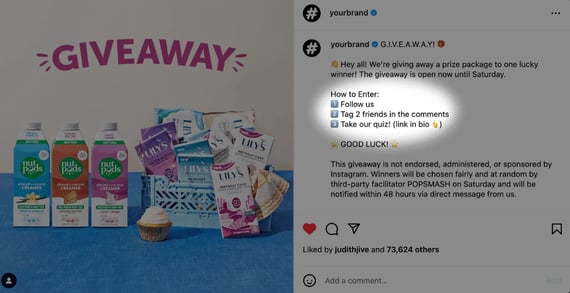
According to Mays, giveaways like this activate your social audience, who drive organic engagement and funnel it to the quiz. The quiz captures contact details (e.g., name, email) and product preferences to get them into a higher-converting channel like email or SMS.
Mays advises, “The key thing here is that ‘social selling’ isn’t just about trying to drive sales in the moment, but giving yourself leverage (personalization and contact data) to consistently drive longer-term sales.”
Don’t just generate customers — grow a community.
At least 20% of people have joined and participated in an online community. Some of them belong to communities created by their favorite brands.
It’s a fun way to connect with customers, get feedback, and share products and information they care about.
It’s about building relationships and loyalty — and hopefully, brand advocates — to increase your brand awareness and sales.
Our research shows that in 2024, 86% of social media marketers will prioritize building an active online community.
“One major trend is community-driven curation and influencer marketing. Our ‘DoDo Crews’ program taps into passionate communities, giving them tools to share looks and inspirations directly with their followers,” shares Mark Sheng, project engineer at DoDo Machine.
Sheng shares that, “Early results show a 25% bump in conversion when shoppers discover products through these trusted sources.”
Sheng’s advice is to put the community at the center. Facilitate authentic connections among brands, creators, and shoppers. Use trusted voices and native video. Social shopping should feel like genuine sharing between friends.
Community & Connection = Clicks & Conversions
Social selling isn‘t about shoving products down people’s throats. It‘s about fostering genuine connections and cultivating communities of passionate fans.
The brands winning are those making their customers feel like they’re sharing between friends (or at least, trusted advisors).
User-generated content, influencer partnerships, community curation — these are what will continue to drive social sales. When trusted voices do the selling for you, it turns a promotion into a friendly recommendation.
Tie in immersive tech like AR try-ons and shoppable videos to meet customers exactly where they are: scrolling on social, ready to be entertained and inspired to spend.
Brands putting community first will unlock clicks, purchases, and meaningful loyalty. They’re the ones who understand the future of social commerce is all about human-to-human connection, not brand-to-consumer broadcasting.
![]()

Company Growth Strategy: 7 Key Steps for Business Growth & Expansion
A concrete business growth strategy is more than a marketing effort. It’s a crucial cog in your business machine. Without one, you’re at the mercy of a fickle consumer base and market fluctuations. So, how do you plan to grow? If you’re unsure about the […]
SalesA concrete business growth strategy is more than a marketing effort. It’s a crucial cog in your business machine. Without one, you’re at the mercy of a fickle consumer base and market fluctuations.
So, how do you plan to grow?
If you’re unsure about the steps needed to craft an effective growth strategy, I’ve got you covered.
Table of Contents
- Business Growth
- Business Growth Strategy
- How to Grow a Company Successfully
- Growth Strategy Examples
- Why You Need a Business Growth Plan
- Types of Business Growth
- Types of Business Growth Strategies
- The Key to Growing Your Business
Why You Need a Business Growth Plan
So why do I think building a business growth plan is so crucial, even for established businesses?
There are so many reasons, but here are three that apply to almost all companies at some point:
- Funding. Functionally, most businesses are always on the lookout for investors. You’ll have an advantage if you present a solid growth plan to convince them. Most expect it.
- Insurance. Growth creates financial padding, like a forcefield to protect your business when unexpected issues crop up. The economic upheaval for brick-and-mortar businesses in 2020 is a perfect example.
- Credibility and creditability. For brand new businesses, getting a loan and making sure you can repay your bank is at the top of the priority list. There’s no real profit until that debt is managed. Having a growth plan will not only help you secure a business loan, but it will also be there to refer to so you’ll know what to do to continue making your payments.
For the majority of businesses, growth is the main objective. Business decisions are often made based on what would contribute to the company’s continued growth and overall success.
Several methods can facilitate growth, which I’ll explain more about below.
Types of Business Growth
As a business owner, you’ll have several avenues for growth. Business growth can be broken down into the following categories:
1. Organic
With organic growth, a company expands through its operations using its internal resources. This is in contrast to seeking external resources to facilitate growth.
An example of organic growth is making production more efficient so you can produce more within a shorter time frame. This means more sales with half the effort.
A perk of using organic growth is that it relies on self-sufficiency and avoids taking on debt. Additionally, the increased revenue created from organic growth can help fund more strategic growth methods later on.
Example: Organic growth could be putting some of your revenue aside to purchase a second machine. A second machine would double your production without debt. This increases your ability to take on larger orders. This way, you create more revenue to invest in a third machine or fund another growth strategy.
2. Strategic
Strategic growth involves developing initiatives that will help your business grow long-term. An example of strategic growth could be creating a new product or a market strategy to target a new audience.
Strategic initiatives often require significant resources and funding. Businesses usually take an organic approach first, hoping their efforts will generate enough capital to invest in future strategic growth initiatives.
Pro tip: Strategic growth can be a major endeavor, depending on the size of your business. Be prepared to learn a lot, work hard, and see slow development. Or, hire a skilled employee to work hard at it for quicker results.
Another option is to spend the money on a user-friendly platform you or an employee can manage. Strategic growth is easily a full-time job for anyone, if not for a team of professionals.
3. Internal
An internal growth strategy helps optimize internal business processes to increase revenue. This strategy relies on companies using their own internal resources.
Internal growth strategy is all about using existing resources in the most purposeful way possible.
Internal growth can be challenging because it forces companies to look at how their processes can be improved for efficiency rather than focusing on external factors like entering new markets to facilitate growth.
Example: Cutting wasteful spending and running a leaner operation by automating sales with AI is an example of internal growth.
4. Mergers, Partnerships, Acquisitions
Although riskier than the other growth types, mergers, partnerships, and acquisitions can come with high rewards.
There’s strength in numbers. A well-executed merger, partnership, or acquisition can help your business break into a new market. You can also expand your customer base or increase your products and services.
A company’s industry and target market influence its chosen growth strategies.
To create a strategy, consider the available options and strategically work them into your business plan. Depending on the kind of company you’re building, your growth strategy might include aspects like:
- Adding new locations.
- Investing in customer acquisition.
- Franchising opportunities.
- Product line expansions.
- Selling products online across multiple platforms.
Pro tip: Your particular industry and target market will influence your decisions, but it’s almost universally true that new customer acquisition will play a sizable role.
That said, you can adopt different types of overarching growth strategies before making a specific choice, such as adding new locations. Let’s take a look.
Types of Business Growth Strategies
There are several general growth strategies that your organization can pursue. Some strategies may work in tandem. For instance, a customer and market growth strategy will typically go hand-in-hand.
Revenue Growth Strategy
A revenue growth strategy is an organization’s plan to increase revenue over a time period, such as year-over-year. Businesses pursuing a revenue growth strategy may:
- Monitor cash flow.
- Leverage sales forecasting reports.
- Analyze current market trends.
- Diminish customer acquisition costs.
- Pursue strategic partnerships with other businesses to improve the bottom line.
Specific revenue growth tactics may include:
- Investing in sales training programs to boost close rates.
- Leveraging technology to improve sales forecasting reports.
- Using lower-cost marketing strategies to lower customer acquisition costs.
- Continuing to train customer service reps to increase customer retention.
- Partnering with another company to promote your products and services.
Pro tip: Revenue for the sake of personal income is often essential at the start of a business, and end of a business to use as enticement for selling the company. While you look to the future with your company running, it’s wise to use revenue growth toward continued overall business growth.
Customer Growth Strategy
A customer growth strategy is an organization’s plan to boost new customer acquisitions over a time period, such as month-over-month.
Businesses pursuing a customer growth strategy may be more open to making large strategic investments, as long as the investments lead to greater customer acquisitions.
For this strategy, you might track:
- Customer churn rates.
- Calculate customer lifetime value (CLV).
- Leverage pricing strategies to attract more customers.
With new customer sign-ups as the North Star metric, you might spend more on marketing, sales, and CX.
Specific customer growth tactics may include:
- Investing in your marketing and sales organization’s headcount.
- Increasing advertising and marketing spend.
- Opening new locations in a promising market you’ve not yet reached.
- Adding new product lines and services.
- Adopting a discount or freemium pricing strategy.
- Tracking metrics such as churn rates, CLV, and monthly recurring revenue (MRR).
Pro tip: Remember that it’s about people. Market research tools such as trend monitoring can help keep you aware of what your target audiences are genuinely interested in. This way, you can personalize your marketing to meet their needs.
Marketing Growth Strategy
A marketing growth strategy is similar, but not the same as, a market development strategy. This strategy is an organization’s plan to increase its total addressable market (TAM) and increase existing market share.
Businesses pursuing a marketing growth strategy will research different verticals, such as:
- Customer types.
- Audiences.
- Regions.
This helps give brands a measure of the viability of a market expansion.
Specific marketing growth tactics may include:
- Rebranding the business to appeal to a new audience.
- Launching new products to appeal to buyers in a different market.
- Opening new locations in other regions.
- Adopting a different marketing strategy, like local marketing or event marketing, to appeal to other markets.
- Becoming a franchisor so that individual business owners can buy franchises from you.
Pro tip: The idea here is to get a bigger slice of the pie by growing into already established markets. Instead of finding new markets, this strategy finds space in existing ones.
1. Use a growth strategy template [Free Tool].
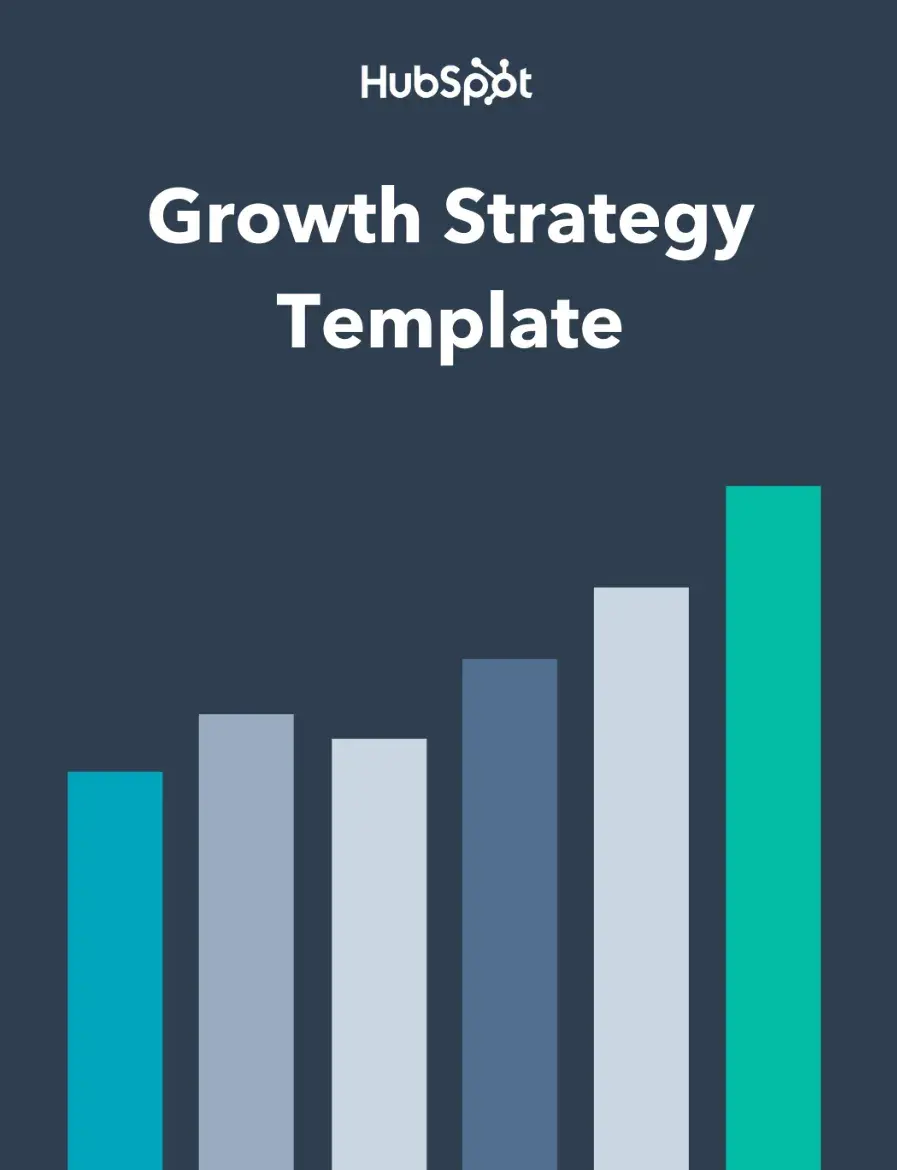
Download HubSpot’s Free Business Growth Strategy Template
With any new venture, you need to document your steps. I recommend downloading this free Growth Strategy Template and working off the included section prompts to outline your intended process for growth in your organization.
New business ventures are 260% more likely to launch if they have a business plan and 30% more likely to grow when they have a plan for it. You can still run, but plan your route first!
2. Choose your targeted area of growth.
Your business growth plan should hone in on specific areas of growth. Common focuses of strategic growth initiatives might include:
- Growth in employee headcount.
- Expansion of current office, retail, or warehouse space.
- The addition of new locations or branches of your business.
- Expansion into new regions, locations, cities, or countries.
- The addition of new products and services.
- Expanding purchase locations, like in-store or online.
- Growth in revenue and/or profit.
- Growth of customer base.
- Customer acquisition rate.
Your growth plan may encompass more than one of the initiatives outlined above, which makes sense — the best growth doesn’t happen in a vacuum. For example, growing your unit sales will result in revenue growth — and possibly additional locations and headcount to support the increased sales.
Pro tip: Geographical spread is popular right now. In a 2023 Forbes survey, 79% of business owners focused on expanding into new geographies. Of small brick-and-mortar and online sellers, 90% want to do the same. Expanding your geographic footprint might be a good option!
3. Conduct market and industry research.
Researching the state of your industry is the best way to determine if your desired growth is both necessary and feasible. Conduct research by:
- Running surveys.
- Hosting focus groups with existing and potential customers.
- Digging into existing industry research.
The knowledge and facts you uncover in this step will shape the expectations and growth goals for this project to better determine a timeline, budget, and ultimate goal.
4. Set growth goals.
The next step is to determine how much you’ll be growing. To do that, you’ll need to set goals.
These goals should be based on your endgame aspirations of where you ideally want your organization to be. Your goals should also be achievable and realistic, which is why setting a goal based on industry research is so important.
Take the steps to quantify your goals in terms of metrics and timeline. For example, your goal may be to “grow sales by 30% quarter-over-quarter for the next three years” instead of just “increasing sales.”
Pro tip: Try to be SMART about your goals. Make them Specific, Measurable, Achievable, Relevant, and Timely based on the results of your market research.
5. Plan your course of action.
Next, outline how you’ll achieve your growth goals with a detailed growth strategy. Again, I suggest writing out a detailed growth strategy plan to gain the understanding and buy-in of your team.

This action plan should contain a list of:
- Action items.
- Deadlines.
- Teams or persons responsible.
- Resources for attaining your growth goal.
6. Determine your growth tools and requirements.
The last step before acting on your plan is determining any requirements your team will need through the process. These specific resources will help you meet your growth goals faster and more accurately. Examples might include:
- Funding. Organizations may need a capital investment or an internal budget allocation to see this project through.
- Tools & Software. Consider what technological resources may be needed to expedite and/or gain insights from the growth process.
- Services. Growth may be better achieved with the help of consultants, designers, or planners in a specific field.
7. Execute your plan.
With all of your planning, resourcing, and goal-setting complete, you’re ready to execute your business growth plan and deliver results for the company.
Make sure to:
- Holding your stakeholders accountable.
- Keep the line of communication open.
- Compare initial results to your forecasted growth goals to see if your projected results are still achievable.
- Adjust, if necessary.
Your growth plan and the tactics you leverage will ultimately be specific to your business, but there are some universal strategies you can implement when getting started.
Companies can implement different growth strategies to expand a business and its revenue. Check out this list of company growth strategy examples.
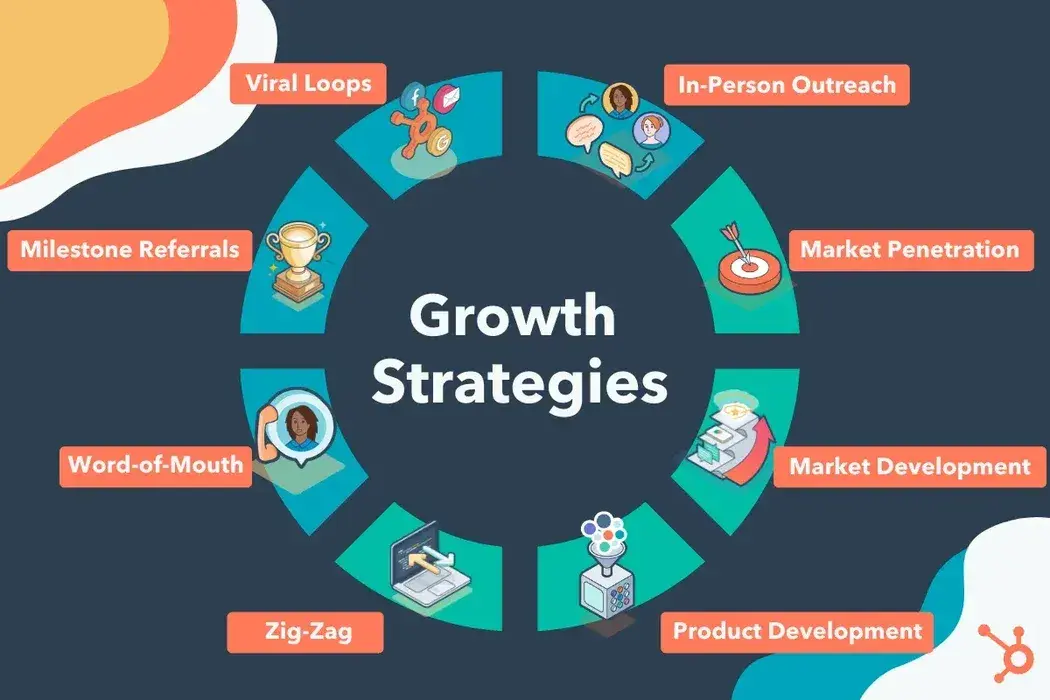
1. Viral Loops
Some growth strategies are tailored to be completely self-sustainable. They require an initial push but ultimately rely primarily (if not solely) on users’ enthusiasm to keep them going. One strategy that fits that bill is the viral loop.
The basic premise of a viral loop is straightforward:
- Someone tries your product.
- They’re offered a valuable incentive to share it with others.
- They accept and share with their network.
- New users sign up, see the incentive for themselves, and share with their networks.
- Repeat.
Ideally, your incentive will be compelling enough for users to actively and enthusiastically encourage their friends and family to get on board. At its best, a viral loop is a self-perpetuating acquisition machine, operating 24/7.
That said, viral loops are not guaranteed to go viral. And they’ve become less effective as they’ve become more commonplace. However, the potential is still there.
Part of the appeal is that the viral loop flips the traditional funnel upside-down:
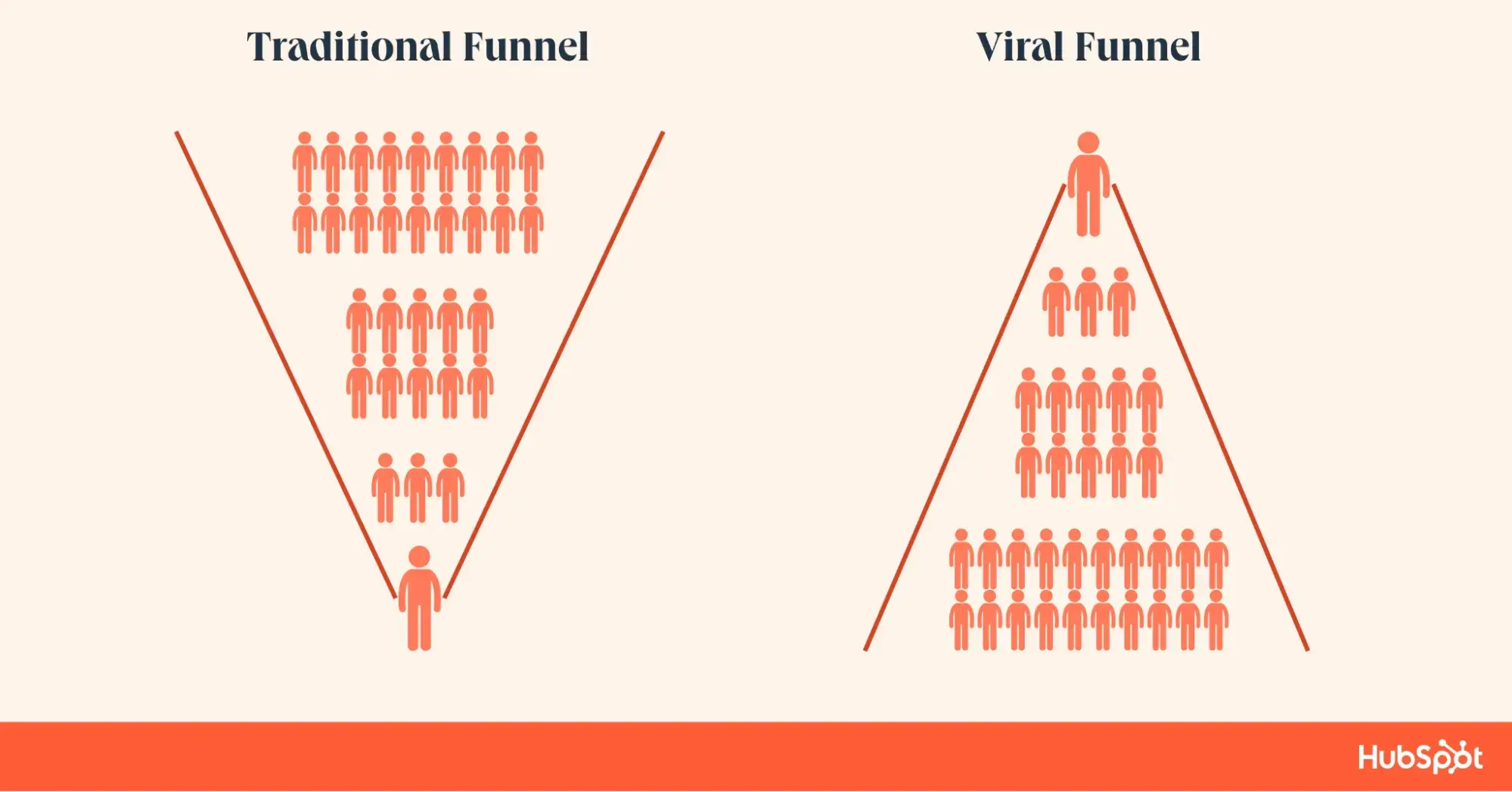
What we like: Instead of needing as many leads as possible at the top, a viral loop funnel requires just one satisfied user to share with others. The system continues growing as long as every referral results in at least 1.1 new users.
Viral Loop Example: Dropbox
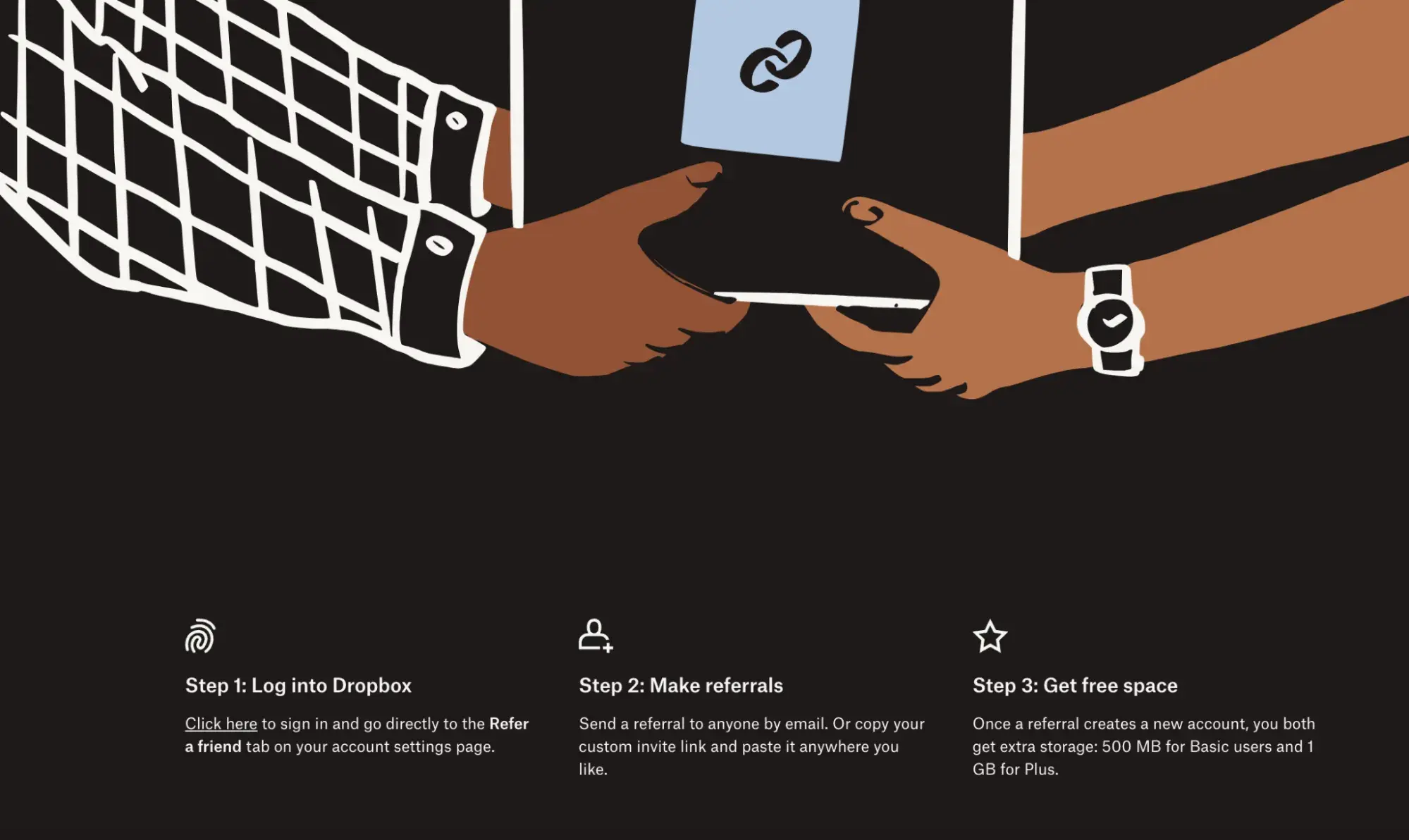
Dropbox is one product I use that uses viral loops as a growth strategy. Here’s how I fit into the company’s viral loop:
- I tried Dropbox as a cloud storage solution.
- I saw that I could get 500MB of free space for each successful Dropbox referral.
- I sent a referral link to my friends.
- Some of them signed up and used the same referral program with their networks.
The incentive is strong enough to drive new people to sign up, increasing the number of Dropbox users as a whole.
2. Milestone Referrals
The milestone referral model is similar to the viral loop. It relies on incentives to kickstart and sustain it. But milestone referrals add a more intricate, progressive element to the process.
Companies that leverage viral loops generally offer a flat, consistent offer for individual referrals. Milestone referrals, though, offer rewards for hitting specific benchmarks.
In many cases, “milestones” are metrics like the number of referred friends.
A business might include different or increasingly enticing incentives with more referrals, iinstead of a fixed incentive for each referral. For example, if a customer refers ten friends, they’ll receive a better reward compared to those who only refer two new people.
What we like: This strategy adds an engaging element to the referral process. When done right, milestone referrals are simple to share with relatively straightforward objectives and enticing, tangible products as rewards.
Milestone Referral Example: Morning Brew
I’m a huge Morning Brew fan. In fact, I start my day with the Daily Brew and my cup of coffee. However, I didn’t know the site had a milestone referral program until I began researching for this article.

The more people who sign up using my referral code, the better swag I get. Three referrals get me a sticker pack. Five earn me a tote bag. And with 25 referrals, I’ll get mailed a backpack. This system gamifies referral for a product that’s free, making people more likely to share Morning brew.
3. Word-of-Mouth
Word-of-mouth is organic and effective. Recommendations from friends and family are some of the most powerful incentives for consumers to purchase or try a product or service.
The secret of word-of-mouth’s effectiveness lies in a deeply rooted psychological bias: we think others know best.
That’s why social proof is so effective. Social proof is central to successful sales copywriting and broader content marketing efforts because it says, “Hey, people trust us.”
Businesses know in today’s customer-driven world, a single negative blog or social media post can compromise an entire marketing effort.
Pete Blackshaw, the father of digital word-of-mouth growth, says, “Satisfied customers tell three friends; angry customers tell 3,000.”
Pro tip: The key to word-of-mouth is to focus on a positive user experience. You need to grow a base of satisfied customers and sustain the wave of loyal feedback that comes with it. With this method, you have to focus on delivering a spectacular user experience, and users will spread the word for you.
Word of Mouth Example: Salud
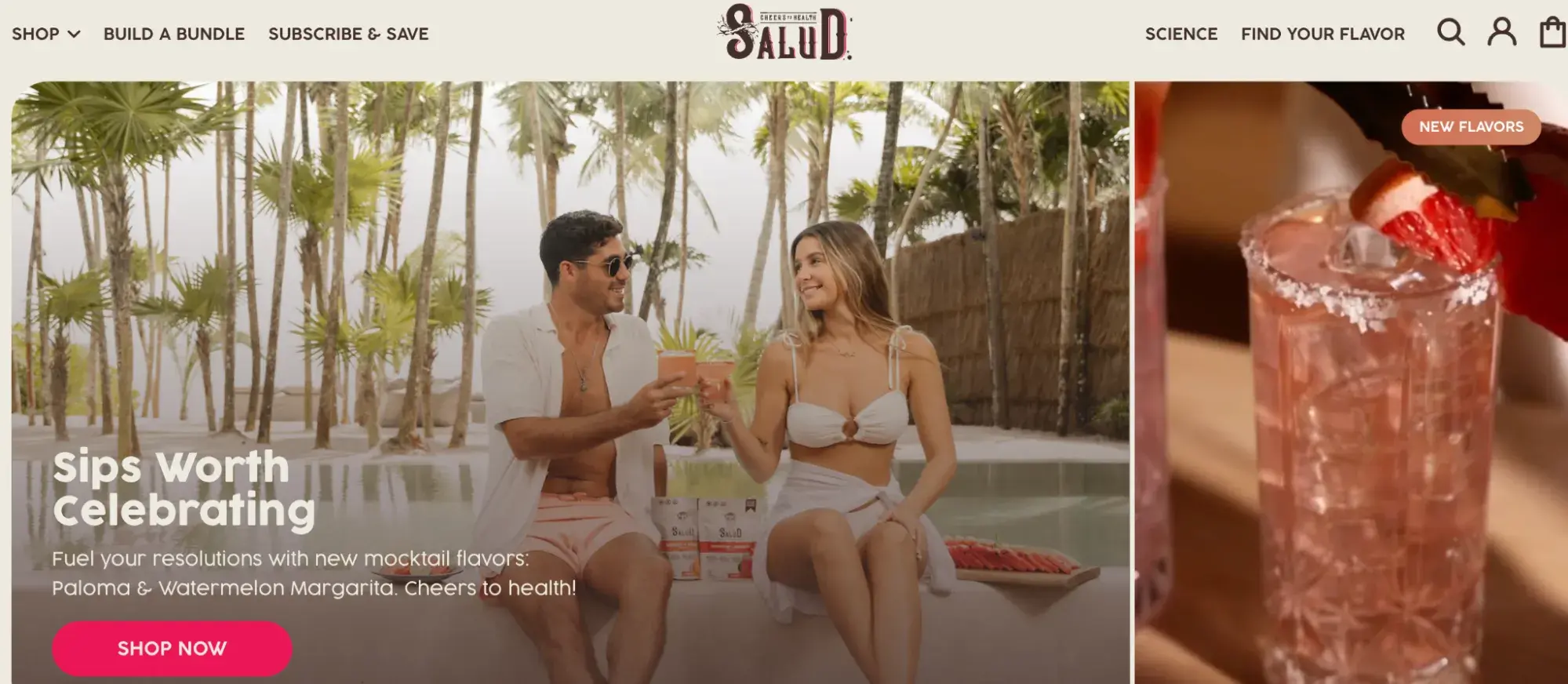
When I felt the early stages of a scratchy throat, I used to reach for Vitamin C tablets or mix-in powders. However, a friend recently brought over a few packets of Salud, a brand of beverage mixes that have hydration and immunity beverages.
I loved how these packets tasted, inspired by Latin flavors common in aguas frescas. Now, I keep a few in my cabinet. And, I’m not the only one in my social circle with Salud. I’ve noticed it in my other friends’ cabinets, showing the power of word of mouth.
4. The “When They Zig, We Zag” Approach
Sometimes, a company’s best growth strategy is to offer a unique experience that sets it apart from other businesses in its space.
Say your company developed an app for transitioning playlists between music streaming apps. Assume you have a few competitors who all generate revenue through ads and paid subscriptions — both of which frustrate users.
In that case, you might be best off trying to shed some of the baggage that customers run into trouble with when using your competitors’ programs. If your service is paid, you could consider offering a free trial of an ad-free experience from the start.
What we like: The point here is that there’s often a lot of value and opportunity in differentiating yourself. If you can “zig when they zag,” you can capture consumers’ attention and capitalize on their shifting interests.
Zig Zag Example: Octave

Online mental health is a space with a lot of competition. BetterHelp, Talkspace, and Modern Health all offer online counseling sessions. However, when a friend of mine started talking about Octave, my ears perked up.
Octave allows users to put in their insurance information and find therapists who are in-network for their healthcare plans. You don’t have to pay any additional fees to use the platform. Octave helped my friend find a therapist who actually accepts her insurance without a premium fee or surcharge.
This insurance angle differentiates Octave from digital mental health competitors. Its focus on mental health is more specific than doctor search sites like Zocdoc, showing the power of differentiation as a growth engine.
5. In-Person Outreach
Adding a human element to your growth strategy can help set things in motion for your business, and it’s highly effective.
Prospects are often receptive to a personal approach. And nothing is more personal than immediate, face-to-face interactions. Personally interacting with potential customers can be a great way to get your business the traction it needs to get going.
This could mean:
- Hosting or sponsoring events.
- Attending conferences relevant to your space.
- Hiring brand ambassadors.
In reality, it’s any other way to directly and strategically reach out to your target demographic in person.
What we like: With consumers used to being saturated with ads, in-person outreach shakes things up and will stand out to them.
In-Person Outreach Example: Conferences
If you want an example of in-person outreach in action, look no further than Inbound, HubSpot’s annual conference. Sponsors of the event have booths where they can demo products for interested business leaders. They can also give out swag and answer questions, getting in front of potential customers.
6. Market Penetration
Competition is a necessary part of business, but it can be tough going.
Imagine that two companies in the same industry are targeting the same consumers. Typically, whatever customers Business A has, Business B does not. Market penetration is a strategy that builds off of this tug-of-war.
Market penetration increases the market share of a product within the given industry. Market share refers to the percentage of total sales in an industry generated by a company.
Market Penetration Example: Coca-Cola
Coca-Cola, the most popular carbonated beverage in the United States, has a 42.8% market share. If competitors like Pepsi and Sprite wanted to increase market penetration, they would need to increase market share. This increase would imply that they are acquiring customers who previously bought Coca-Cola or other carbonated beverage brands.
Pro tip: While lowering prices and advertising are two costly yet effective tactics to increase market share, they are part of businesses’ methods for overall sales and customer retention.
7. Market Development
If a company feels as if they have plateaued and its current market no longer has room for growth, it might switch strategies from market penetration to market development.
Market development strategies help businesses to tap into a new markets and territories by creating new products or finding innovatise uses for a project.
Pro tip: Brainstorm adjacent products or services you could offer to expand into new markets.
Market Penetration Example: Uber
Uber launched in 2009 as a rideshare company, allowing people with cars to pickup passengers as a gig. In 2014, the company expanded its offerings with UberEats, allowing customers to order food and have it delivered — even if the restaurant does not directly offer delivery. Two years later, the company launched Uber Freight, an app that matches cargo carriers with shippers.
This growth is still underway today. In 2025, Uber expanded
- A program that serves teen riders to 26 new countries.
- A Shopper Pick & Pack program that allows gig workers to shop for orders and hand off completed bags to couriers.
- A Broker Access capacity-as-a-service solution that gives freight brokers direct access to the company’s technology platform.
The company started as a way to get passengers to their destinations. Uber expanded their idea and has become one of the biggest names in mobility today.
8. Product Development
For growth, many businesses need to introduce something new. Product development allows companies to attract new customers and retain existing ones by creating a new product or enhancing an existing one.
Pro tip: While this is one of the most common ways a business grows, be sure you’re listening to your customers so you know what they’re looking for.
Product Development Example: Apple
Tech giant Apple doesn’t just make a product and rest on its laurels. The company invests major time and money into product development. According to Statista, the company spent $31.4 billion on research and development in 2024. The goal here is to improve products so people stay loyal to the brand or add another Apple device to their tech stack.
9. Growth Alliances
Growth alliances are strategic collaborations between companies. They further the growth goals of the involved parties.
Pro tip: To make a growth alliance, look for an adjacent business that already serves your target audience (and vice versa) to benefit you both.
Growth Alliances Example: Sephora and Ulta
Sephora partnered with retailer Kohl’s in 2020, starting a growth alliance that benefitted both brands. Sephora gets to have products in new locations, reaching busy shoppers in an older age demographic who may not have time to visit their store. Kohl’s brings makeup lovers into the store, who can then shop for other products at the retailer.
In 2022, we also saw Target forming a growth alliance with Ulta Beauty to create dedicated shop space for Ulta in at least 800 stores. The following year, Fenty Beauty teamed up with Ulta Beauty at Target. Ulta Beauty and Fenty can get their products in front of shoppers at a major retailer. Target has the benefit of becoming an even more dominant one-stop-shop for customers.
10. Acquisitions
Companies can use an acquisition strategy to promote growth. By acquiring other businesses, companies expand their operations by creating new products or expanding into a new industry.
Acquisitions offer significant benefits to companies, such as:
- Allowing for faster growth.
- Gaining access to more customers.
- Reduced lower business risk.
- And more.
What we like: This is an easy (though sometimes expensive) way to grow since the products or services you acquire are already established and come with a customer base.
Acquisitions Example: Procter & Gamble
Founded in 1837, Procter & Gamble is a consumer goods company known for its acquisitions. It initially started in soaps and candles but currently has 65 acquired companies, allowing it to expand into different markets.
The list includes Pampers, Tide, Bounty, Tampax, Old Spice, and more. Although its sales dipped between 2016 and 2019, Procter & Gamble’s net sales for 2023 were $84 billion, its best year within the last decade.
11. Organic Growth
Organic growth is the most ideal business growth strategy. It could look like:
- Focusing on SEO.
- Developing engaging content.
- Prioritizing advertisements.
Instead of focusing on external growth, organic growth is a sustainable strategy that promotes long-term success.
What we like: Organic growth should always be part of your game plan, even while pursuing other business growth strategies. If your business isn’t growing organically, you’re not doing something right.
Organic Growth Example: Marketing at HubSpot
Looking to see organic growth in action? Well, this blog post and the HubSpot Blog on whole are a part of that strategy. This blog’s SEO team helps identify topics that people are searching for, so writers like me can craft engaging content that brings people into our ecosystem.
The site doesn’t have paid ads, but writers include product mentions and CTAs that point to our product.
12. Leverage Social Media
A strong social media presence can be invaluable to marketing and business growth. You’ll need to establish brand pages on all social media platforms like:
- Instagram.
- Facebook.
- Pinterest.
- TikTok.
- X.
Social media can help you increase engagement with your target audience and make it easier for potential customers to find your brand.
It’s also great for word-of-mouth promotion, as existing customers will likely share your content with their network. There has been a huge upswing in the popularity of using social media influencers as well. The global influencer marketing platform industry is expected to reach $22.2 billion by 2025.
Pro tip: Be where your customers are. Research which social media channels are most popular with your target audience and focus your efforts there.
Social Media Example: Stanley Cup
In 2023, TikTok user danimarielettering posts a video of her car after it caught on fire. She picks up a Stanley Cup in the car’s cup holder. She gives it a shake. There’s still ice jingling against the metal. The TikTok went viral, and the brand gave the video maker a new car.
Stanley continued to ride the social media wave. People began posting videos of their Stanley cup collections and their excitement over new colors of the product hitting the market, showing how social buzz can help you grow.
13. Provide Excellent Customer Service
It can be tempting to focus on acquiring new customers, but maintaining loyalty with your existing customers is just as important. Existing customers already love your brand and may evangelize for you for free.
Providing an excellent customer service experience ensures that you’ll continue to keep the customers you have. Plus, there’s a good chance you’ll reap some high-value referrals, too.
What we like: Customer retention offers one of the best ROIs, so it’s definitely worth investing in. Check out these strategies to keep your customers happy and coming back.
Customer Service Example: AMC Theaters
This is an example that hits close to home. I wanted to see a limited-release movie at a local theater. However, I noticed that the website time showed 10 a.m. instead of 10 p.m., making it the only location with a daytime showing.
I called the theater to see if the posting was a mistake. Turns out it was! The staff had to repost the movie time. However, on my call, I was able to reserve the seats I was eyeing in the previous booking. My problem was resolved with no issue, and I got to keep the best seats in the house.
I’m now loyal to that AMC location after the great service I received, making it my theater of choice.
The Key to Growing Your Business
Controlled, sustainable growth is the key to successful businesses. Industries are constantly changing, and it is the responsibility of companies to adapt to these changes.
Successful companies plan for growth. They work for it. They earn it. So what’s your plan?
Editor’s note: This post was originally published in March 2020 and has been updated for comprehensiveness.
![]()
12 Powerful CRMs and Use Cases for a Growing Business
12 Powerful CRMs and Use Cases for a Growing Business With so many customer relationship management (CRM) tools on the market today — and each with its own features, integrations, and capabilities — it can be challenging to find the right tool for your growing […]
Sales12 Powerful CRMs and Use Cases for a Growing Business
With so many customer relationship management (CRM) tools on the market today — and each with its own features, integrations, and capabilities — it can be challenging to find the right tool for your growing business.
How do you select the right CRM for your team? And how can you ensure that you’re taking full advantage of your CRM?
In this post, I’ll review 12 of the best CRMs on the market to help you narrow your search. With these example CRMs, I’ll also offer use cases for each tool to provide insight into how you can best use them.
Table of Contents
I’ve used several different tools over the years, ranging from all-in-one CRM platforms to a simple project management system that I’ve automated to fit my needs. Ultimately, the best CRMs support sales activities, customer service, and customer retention.
In a perfect world, CRMs should also integrate with any marketing software to make for a smooth transfer of data. However, that’s not always the case — and that’s okay too. In my experience, starting somewhere and working to integrate is more effective than waffling on a decision, waiting for the perfect solution, and not ending up with any systems or processes for tracking customer data.
What’s more, with nearly every tool on the market bringing AI into the mix — the insights and integrations will only get better.
Whether you’re just starting out or are looking for a CRM that meets your needs better than the current solution, I’ve evaluated the following list.
{{ sgMacro.render_ftSnippet({ header: “12 Best CRMs”, content_type: “ordered_list”, list: { items : [ “”HubSpot”, “Salesflare”, “EngageBay”, “Microsoft Dynamics”, “Salesforce”, “Zoho “, “BIGContacts”, “Pipedrive”, “Freshworks “, “ActiveCampaign”, “Close”, “NetSuite” ] }, paragraph: { content: “” } }) }}
Here are 12 CRMs available today and examples of how you might use them.
1. HubSpot

HubSpot is a CRM platform — meaning, it tracks customer relationships, as well as facilitates marketing, sales, and service processes. HubSpot is ideal for any scaling business (whether you’re small, mid-sized, or enterprise) and any team (such as marketing, sales, customer service, operations, or C-suite).
The platform combines Marketing Hub, Sales Hub, Service Hub, and Content Hub — along with hundreds of available integrations — to help you align all internal teams, gather meaningful insights, report on (and share) success and growth opportunities, create remarkable customer experiences, increase adoption, and delight your target audience throughout every moment of the buyer’s journey.
HubSpot serves as a single source of truth when it comes to managing your customer relationships — and with an exceptionally easy user experience (UX), you can spend more time on your customers and less time on software management and manual activities.
And speaking of your customers, they are a major part of what differentiates HubSpot from other CRMs on the market — HubSpot centers everything you do around your customers and the customer experience. As a result, you’re able to grow better and help your customers grow better, too.
Example of HubSpot in Use: Align Your Data
HubSpot syncs every interaction that happens between you and a contact to that contact’s timeline. This creates a single source of truth for every member of your team, from sales to marketing to service to ops.
This also makes it easy for your team to refer to and apply that contact data as needed. As a result, you’ll have the data alignment that’s necessary to effectively increase customer loyalty and delight.
Not to mention, you’ll be saving time in the process since HubSpot will enter, sync, and update your contact data for you — no more manual entry.
Did You Know? HubSpot Marketing Hub customers saw a 505% return on investment over three years. Check out our whitepaper for more insights into the business value of Marketing Hub (just like this one).
Testing It Out
A core part of HubSpot’s CRM is its predictive lead-scoring software, which uses machine learning to parse through thousands of data points to score leads. I found the setup process straightforward, and within minutes, the system started analyzing existing leads and assigning them scores based on their likelihood to convert.
By leveraging historical data and analyzing patterns in lead behavior, the software was able to prioritize leads who were genuinely interested in our offerings. Not only could the tool identify high-potential leads on its own, but it also allows me to create up to 25 different scoring systems to ensure that each lead is qualified adequately.
Overall, my experience with HubSpot’s predictive lead-scoring software was positive. Not only did it save me time, but it also improved the accuracy of my lead prioritization process.
Pricing
HubSpot CRM itself is a free tool, but the Hubs — including the Marketing, Sales, Service, Content, and Operations Hubs — are paid products.
- Marketing Hub. Starts at $15/month/seat (Starter), $800/month (Professional,) and $3,600/month (Enterprise)
- Sales Hub. Starts at $15/month/seat (Starter), $90/month/seat (Professional), and $150/month/seat (Enterprise).
- Service Hub. Starts at $15/month/seat (Starter), $90/month/seat (Professional), and $150/month/seat (Enterprise).
- Content Hub. Starts at $15/month/seat (Starter), $450/month (Professional), and $1,500/month (Enterprise).
- Operations Hub. Starts at$15/month/seat (Starter), $720/month (Professional), and $2,000/month (Enterprise).
These prices are billed annually.
2. Salesflare
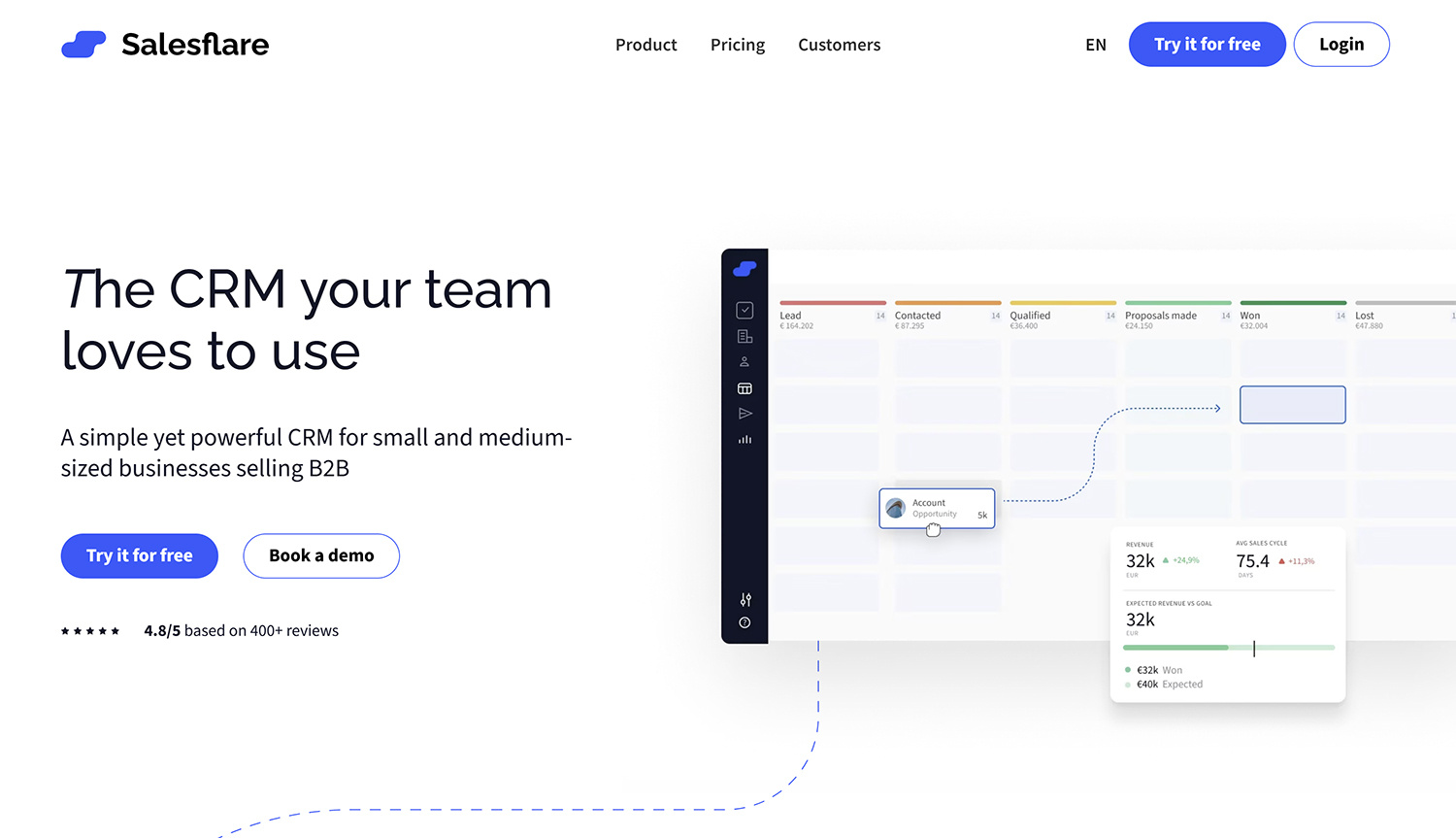
Salesflare is a B2B sales CRM platform, as it’s specifically built to track and organize your B2B operations. Their CRM automatically creates contacts and enriches them with additional details, including email signatures and complete customer timelines. The CRM then nudges you to follow up.
The Salesflare CRM has a built-in email sequence tool that allows you to send personal emails at scale, which can make your outreach way more efficient. And if you‘re a heavy LinkedIn user, you’ll appreciate their LinkedIn sidebar too, which allows you to create contacts from LinkedIn and find their email, all in a few clicks.
Example of Salesflare in Use: Track Your Sales
If you’re in B2B sales, it can be hard to keep track of every lead in your pipeline in an organized way. Sometimes, leads slip through the cracks, you can forget details, or you can follow up a little too late and lose the momentum.
That’s exactly what a B2B sales CRM platform like Salesflare is built for. It makes it very easy to keep track of your leads, so you don’t have to miss any details or lose out on revenue. Salesflare is also a great tool for sales managers who want to keep an eye on what their team is doing and coach them accordingly.
Testing It Out
When I tested Salesflare, two features stood out to me: the automated data entry and email & meeting integration features.
The automated data entry was seamless; as soon as I connected my email and social accounts, Salesflare began pulling in information and populating customer profiles without any manual input from me. I found that the CRM automatically gathered details like contact information, company data, and even social media profiles to create comprehensive records for each lead and customer.
The email and meeting tracking feature was equally impressive. Every email I sent and received was automatically logged into the CRM, along with details about when it was opened and links the recipients clicked. This gave me a clear view of how engaged my leads were and helped me prioritize follow-ups.
The platform also tracked every meeting I scheduled and added it to the timeline, complete with notes and action items, which ensured I never missed a meeting and had all the context I needed for each interaction.
Pricing
30-day free trial available. The paid plans include:
- Growth. $29/user/month.
- Pro. $49/user/month.
- Enterprise. $99/user/month.
These plans are billed annually. If you want to register more than five users for the Enterprise plan, you’ll need to contact Salesflare’s team.
3. EngageBay
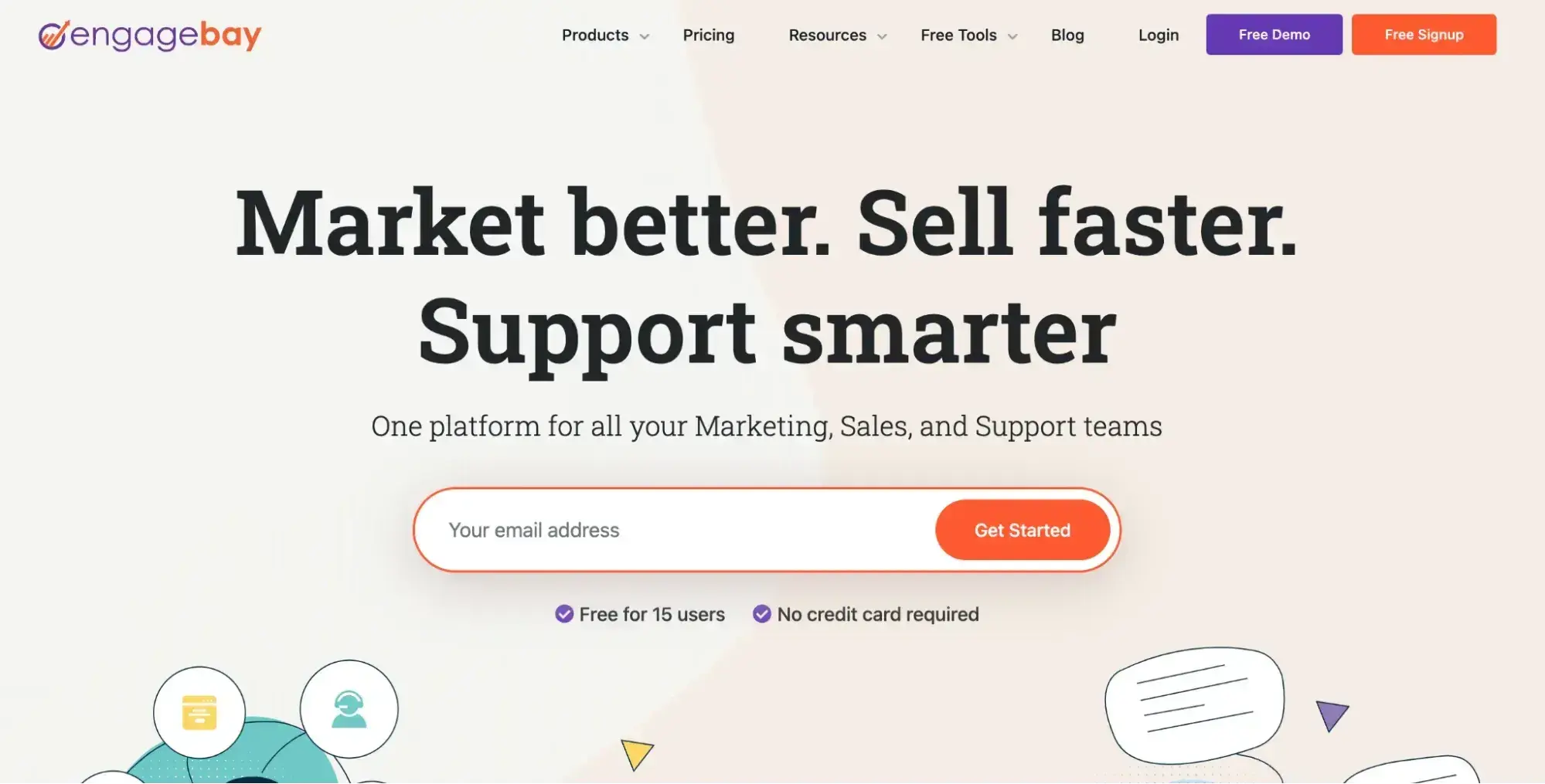
EngageBay helps small businesses manage customer relationships and sales processes effectively. It provides a wide range of features such as contact management, sales automation, lead capture, and marketing automation.
EngageBay is also used by companies to manage their sales and marketing efforts. The software provides users with tools to create and track leads, as well as follow up on sales opportunities.
EngageBay also helps companies measure their marketing campaigns to see what’s working and what isn’t so they can adjust their strategies accordingly.
Overall, EngageBay is an excellent CRM for businesses of all sizes. It is easy to use and comes at quite an affordable price too.
Examples of EngageBay in Use: 360-Degree Customer View
In today’s world, having a complete view of your customer’s journey is paramount. By leveraging data from various channels, companies can begin to understand their customers on a deeper level. That’s what EngageBay’s unified CRM does.
The all-in-one platform connects all the tools and sources its data from the CRM, allowing teams to work in tandem with real-time information.
The 360-degree view draws on each customer’s source, scores, and calls, and offers a complete picture to the business owner or sales manager. This helps sales teams discover new opportunities, close deals, and predict what the customer preferences could be.
Testing It Out
EngageBay’s AI-powered deal management software is incredibly efficient and user-friendly. The automated deal tracking provided real-time updates and prioritized deals based on predefined conditions. This meant that I could focus on high-priority deals without getting bogged down with manual tracking.
The AI-driven predictive analysis was particularly impressive, too. It gave insights into which deals were likely to close and which I needed to pay more attention to. This allowed me to allocate my time and resources more effectively, ensuring no deal was neglected.
The visual sales pipeline was another highlight; the drag-and-drop interface made it easy to manage deals. I could easily move deals through different stages and get a clear overview of their progress.
This visual approach — coupled with the AI and automation features — significantly streamlined my deal management process and increased my overall productivity.
Pricing
There’s a free forever plan available. The all-in-one paid plans include:
- Basic: $13.79/user/month
- Growth: $59.79/user/month
- Pro: $110/39/user/month
These plans are billed annually. They also offer standalone solutions for Marketing and CRM & Sales Bay depending on your needs.
4. Microsoft Dynamics

Microsoft Dynamics is a CRM and enterprise resource planning (ERP) software meant to improve sales and marketing productivity. The CRM gathers social insights, provides cloud-based campaign management, and offers business intelligence.
Choose to have your CRM delivered by cloud, hosted, or on-premises. Microsoft Dynamics offers apps so you can manage your relationships with customers on mobile as well as integrate and sync data from social media with your CRM.
Example of Dynamics in Use: Get In-Depth Customer Insights
A CRM has the power to provide a 360-degree view of your customers, and Microsoft Dynamics is no exception. The CRM’s real-time customer data platform provides AI-powered insights that tell you how to acquire valuable leads and customers, who your audience members are, what they need, how you can delight them, and more.
There are also real-time insights about your customers based on behavioral, demographic, and transactional data as well as engagement and customer feedback (e.g., survey data). This allows your team to apply these insights for targeted and personalized sales, marketing campaigns, support, and more.
Testing It Out
Microsoft Dynamics has a dedicated AI tool that aims to transform the workflow and customer management processes. When I tested it, the automation features stood out to me; the AI-assisted email drafting and meeting summaries saved a considerable amount of time, and the automated data entry (and intelligent reminders) ensured that I never missed important follow-ups.
Customer insights were another great feature. Dynamics 365 AI aggregated data from various touchpoints, providing a comprehensive view of customer behavior and preferences. This allowed me to tailor my interactions and campaigns more effectively. The AI-driven segmentation also allowed me to identify high-value customers and target them with personalized offers, which can boost conversion rates.
Dynamics 365 AI also lends itself to customer service in that AI-powered virtual agents can handle routine inquiries efficiently, freeing up human agents to focus on more complex issues.
The system’s ability to analyze customer interactions and provide real-time suggestions helps improve the quality and speed of responses.
Pricing
30-day free trial available. The paid plans range from $65/user/month to $1,000/tenant/month, depending on the use case you choose.
5. Salesforce
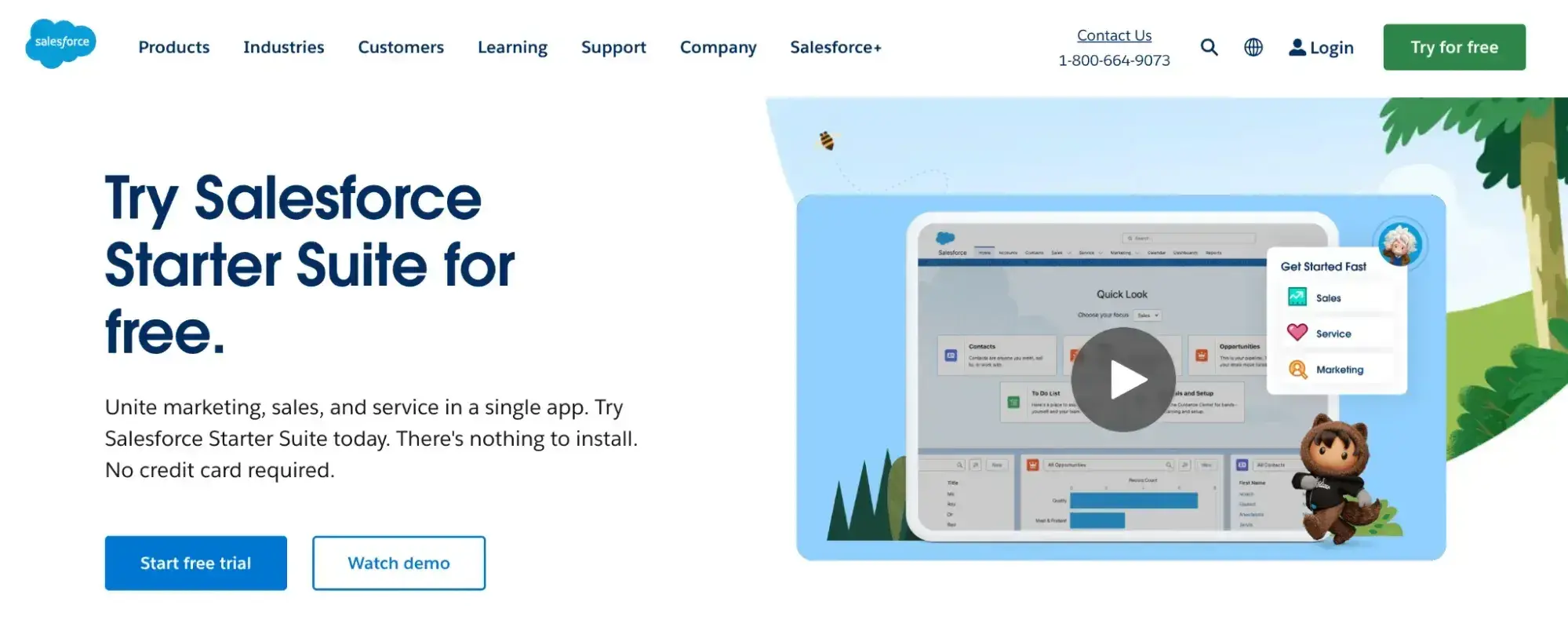
Salesforce’s CRM, Customer360, brings customer data plus sales, service, marketing, commerce, IT, and analytics together in a single location for quick access, shareable insights, and easy collaboration. The CRM is capable of lead and contact management, sales opportunity management, workflow rules, automation, and customizable reports and dashboards. It’s also accessible via a mobile app.
Salesforce offers a number of apps — such as Einstein AI — that make it easier to achieve your unique goals. There are also Employee Experience features within the tool to simplify work collaboration and increase motivation.
Example of Salesforce in Use: Automate Repetitive Tasks
Like many CRM options, Salesforce automates repetitive and time-consuming tasks.
The Einstein AI feature uses AI to provide your team with data about all past interactions with customers. This allows you to engage more thoughtfully and improve business communications and relationships. It also increases productivity by providing your team with the information they need, such as intelligent case classification and next actions.
Einstein AI also makes the process of providing remarkable customer service and support easier by recommending certain actions to reps, personalizing support for customers, and automating support when possible with bots to save reps time.
Testing It Out
Salesforce created a dedicated AI-powered tool to support its CRM, and when I tested it, I found its features to be very effective at providing actionable insights and increasing productivity.
With AI-powered predictive analysis, I could easily get forecasts on sales trends, which can help me make more informed decisions and focus on high-potential leads. Einstein also suggested personalized email content based on customer data, which significantly improved my outreach efficiency.
The conversational AI capabilities also stood out to me. I can use Einstein to generate summaries of sales calls and customer interactions, which saved me a ton of time on manual note-taking. The ability to automate routine tasks and receive real-time predictions on deal closures helped streamline my workflow, allowing me to concentrate more on strategic activities.
Pricing
30-day free trial available. The paid plans range from $25/user/month to $1,500/seat/month, depending on the use case you choose. You might need to call Salesforce’s team for custom pricing.
{% module_block module “widget_ae0bb7ee-2439-4ae9-9469-dae9df239313” %}{% module_attribute “child_css” is_json=”true” %}{% raw %}null{% endraw %}{% end_module_attribute %}{% module_attribute “css” is_json=”true” %}{% raw %}null{% endraw %}{% end_module_attribute %}{% module_attribute “hubdbrow_field” is_json=”true” %}{% raw %}{“id”:173158423372}{% endraw %}{% end_module_attribute %}{% module_attribute “label” is_json=”true” %}{% raw %}null{% endraw %}{% end_module_attribute %}{% module_attribute “module_id” is_json=”true” %}{% raw %}104842557838{% endraw %}{% end_module_attribute %}{% module_attribute “schema_version” is_json=”true” %}{% raw %}2{% endraw %}{% end_module_attribute %}{% module_attribute “tag” is_json=”true” %}{% raw %}”module”{% endraw %}{% end_module_attribute %}{% end_module_block %}
6. Zoho
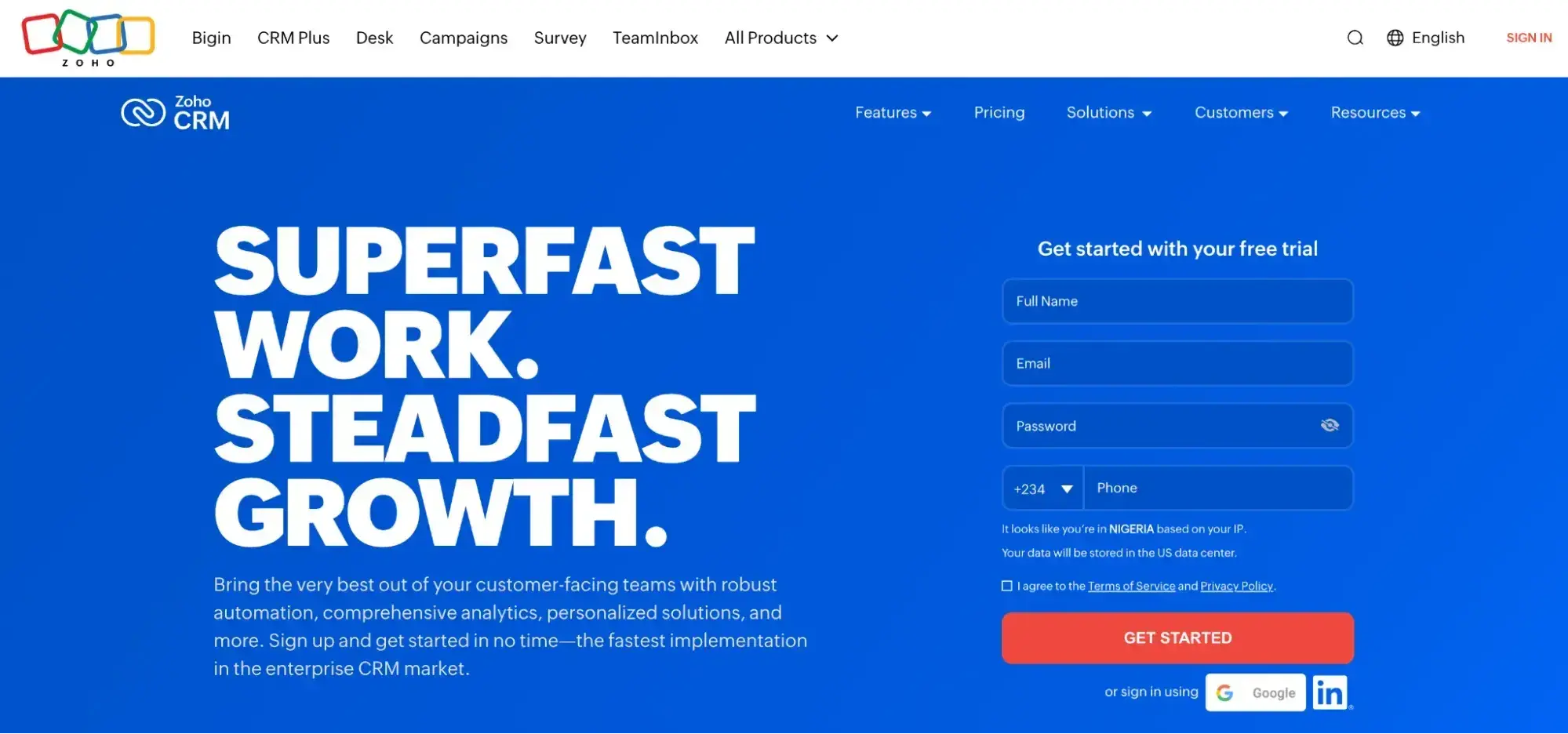
Zoho is a CRM that’s fully cloud-based, integrated, and offers a variety of features including lead management and scoring, workflow automation, analytics, and marketing and process management.
Zoho’s AI sales assistant, Zia, interprets CRM data, tracks website visitors, and predicts sales. These sales predictions also surface leads who are most likely to convert and deals that are most likely to close.
Zoho’s gamification feature keeps your reps motivated and focused on quota while the Google Ads integration aligns your sales and marketing teams by bringing your business’s ad spend and sales revenue to light.
Lastly, you can use Zoho to provide omnichannel support for customers and leads over the phone, email, live chat, social media, or in person.
Example of Zoho in Use: Provide an Omnichannel Customer Experience
Zoho allows you to provide an omnichannel customer experience for your contacts — meaning you can support your audience via email, live chat, social media, or an in-person meeting, all without ever leaving the CRM. Any data obtained through these interactions will be saved to the CRM automatically.
Bring all of your emails into the CRM and send messages directly from the tool. Your email conversation history will be updated and saved after every correspondence.
The same goes for your phone calls — take and receive sales and support calls from Zoho, so all conversations are logged and you don’t ever have to leave the tool. You can also host meetings and lead presentations from the CRM.
Testing It Out
I found Zoho CRM’s AI assistant, Zia, to be an incredibly versatile and intelligent tool. Zia’s conversational capabilities are particularly impressive as it can understand both text- and voice-based commands and queries. I can call and speak to Zia directly, which makes it easy to get real-time insights and updates on sales activities.
In addition to facilitating a quick, hands-free interaction, Zia can also predict sales outcomes by analyzing past sales data and patterns. Its anomaly detection capabilities are also admirable; it can alert you to any irregularities in your sales data, such as sudden spikes or drops in activity. This allows you to address potential issues proactively.
Pricing
There’s a 15-day free trial available. The paid pricing plans include the following:
- Standard. $14/user/month.
- Professional. $23/user/month.
- Enterprise. $40/user/month
- Ultimate. $52/user/month
These plans are billed annually.
7. BIGContacts
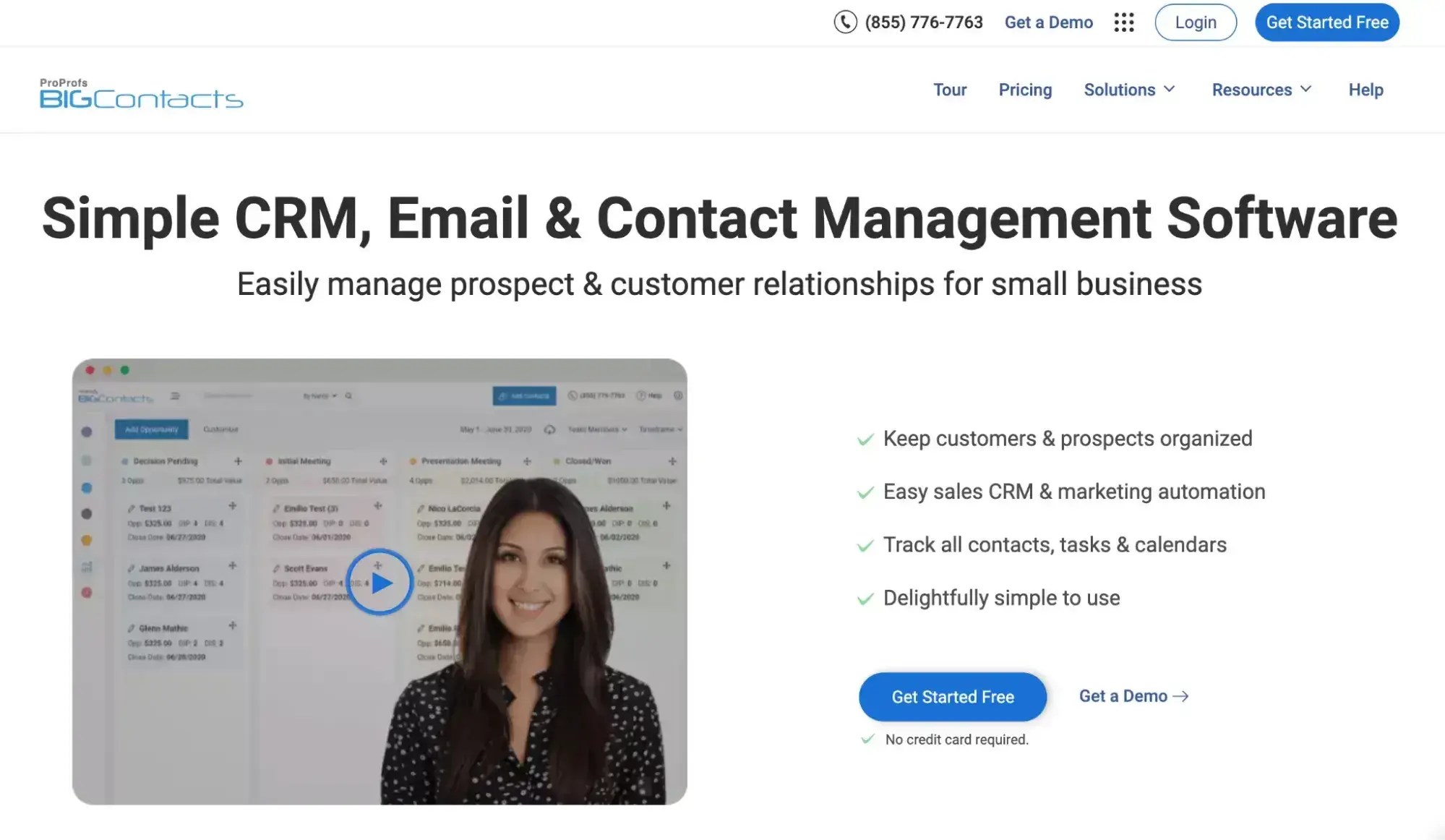
BIGContacts simplifies customer relationship management with its easy-to-use design and intuitive interface. The CRM tool is a reliable way for businesses to stay on top of all customer data and interactions. It provides a 360-degree view of contact data, including previous touches, social media profiles, notes, files, and upcoming activities. The tool enhances team collaboration, provides actionable business insights, and helps increase organizational productivity.
BIGContacts offers sales pipeline management, webform connection, lead nurturing, and task tracking. There are also custom reports and dashboards that allow you to gain better visibility into your business operations.
BIGContacts can also be a powerful tool for task management with detailed calendar views, automated recurring tasks, and custom reminders.
Example of BIGContacts in Use: Personalized Drip Campaigns
Personalized interactions play a monumental role in improving customer relationships. They help customers feel valued, contributing to improved brand loyalty and customer retention. BIGContacts helps businesses leverage the customer data available to craft more meaningful and engaging experiences.
Automated drip email campaigns that adjust based on contact activities can be set up using BIGContacts. These emails allow you to connect with prospects and customers at the right time. Furthermore, email templates are available, which can save a considerable amount of your time. You can also create your templates and save them for future use.
Testing It Out
One of BIGContacts’ core features is its AI-powered contact data standardization feature, which uses advanced algorithms and machine learning to analyze and transform raw contact data into a uniform format. Not only does this streamline data management, but it also reduces the chances of errors typically seen with manual processing.
The application of AI here changes the daunting tasks of manually ensuring data consistency across multiple platforms into a straightforward, automated process. The benefits are immediately noticeable, as it simplifies data analysis, customer segmentation, and targeted marketing efforts.
I was particularly impressed with how the AI tackled complex datasets to ensure accuracy and uniformity in contact information.
Pricing
There’s a free forever plan available for up to 100 users. The paid plan costs $9.99/month for up to 1,000 contacts, billed annually. If you’re managing over 20,000 contacts, you’ll need to talk to BIGContacts’ team for custom pricing.
8. Pipedrive
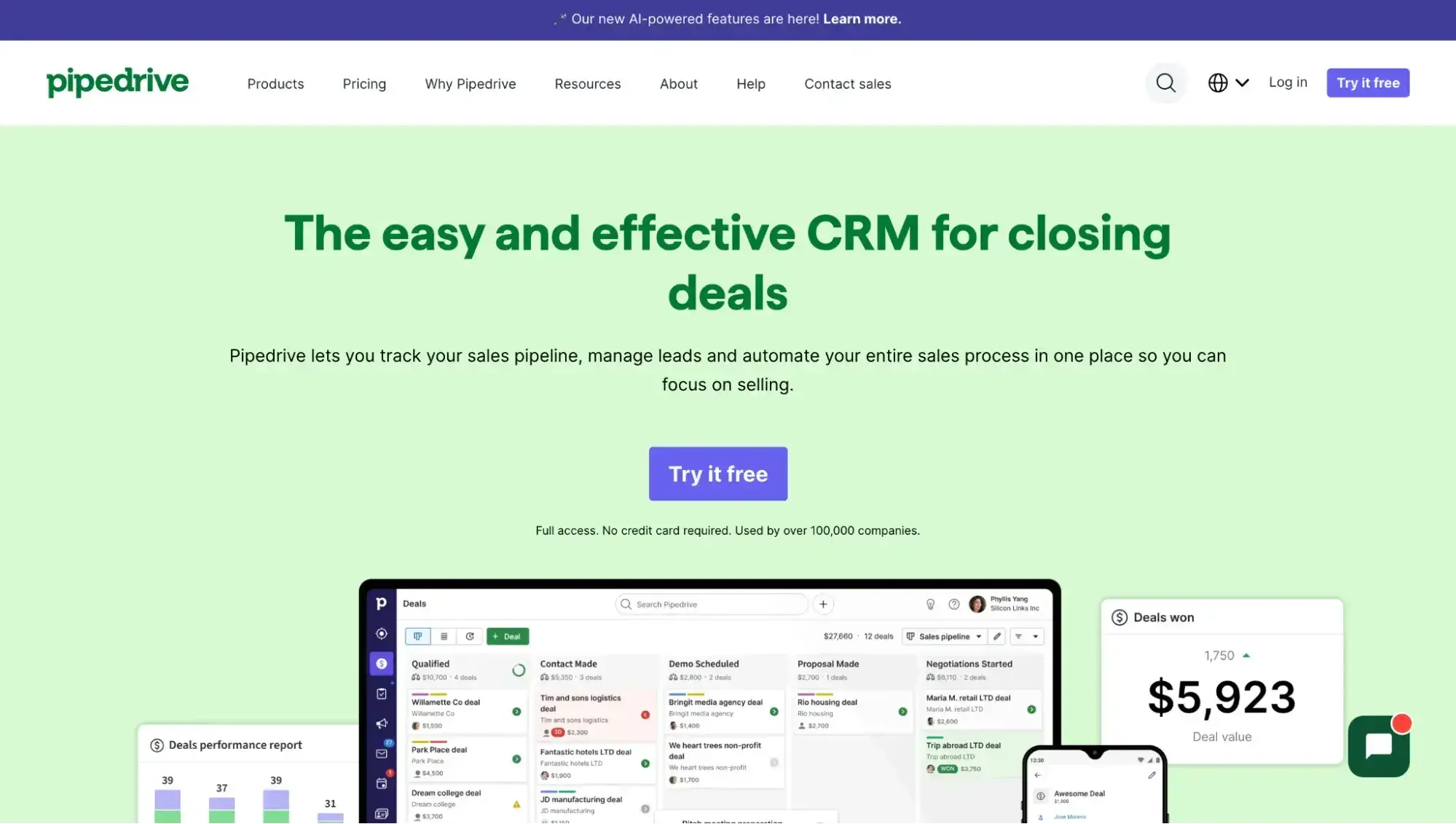
Pipedrive is a sales CRM and pipeline management tool ideal for small teams. The software comes stacked with features for tracking performance, managing deals, predicting revenue, and automating repetitive tasks. Pipedrive automatically visualizes your pipeline so you’re able to identify where your efforts should be focused.
Pipedrive includes sales forecasting and integrations so you can pair your current tools such as Mailchimp or Zapier with your CRM. There’s also a security feature that clarifies how your business data is being used.
Example of Pipedrive in Use: Track Your Data and Security
Use Pipedrive to keep track of your data and security — the software monitors all ways in which your company’s data is accessed and who’s accessing it. Identify suspect users and activities in real-time, all via a single security dashboard. Set notifications that alert you about when and where user log-ins occur. Lastly, create custom rules for secure practices (e.g., time-restricted access) to keep your CRM data safe.
Testing It Out
Pipedrive’s AI tool suite is exceptionally useful. I found that the AI Sales Assistant is able to provide actionable insights and recommend the next best actions for deals, which helps you make timely and informed decisions.
The AI email generator is also effective at creating compelling sales emails from simple prompts, which helps to overcome writer’s block and personalize messages at scale.
I also found the AI email summaries feature to be a huge time-saver as it condenses long email threads into brief summaries, providing clarity on the lead’s interests and suggesting viable steps to take next.
Pricing
There’s a 14-day free trial available. The paid plans include:
- Essential: $14/seat/month
- Advanced: $39/seat/month
- Professional (including AI): $49/seat/month
- Power (including AI): $64/seat/month
These plans are billed annually.
9. Freshworks
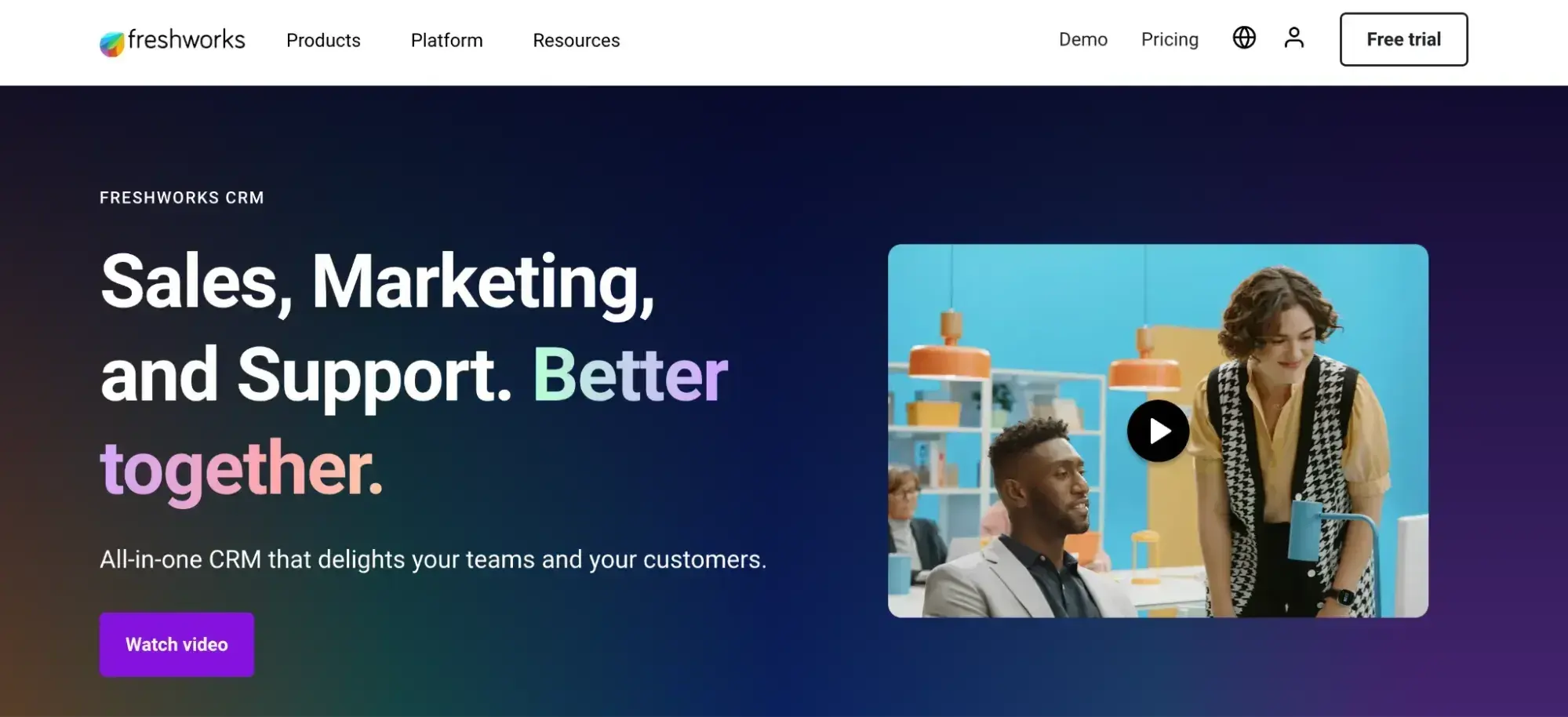
Freshworks is a sales CRM and customer engagement platform that uses AI to help your sales and marketing teams provide personalized customer experiences. Freshworks is split into the Sales Cloud and Marketing Cloud.
The Sales Cloud assists with lead attraction, lead qualification, and deal engagement. It also uses AI to forecast sales and predict which actions reps should take with prospects.
Marketing Cloud helps you conduct automated conversations with customers via an AI-powered chatbot. It also uncovers details about audience behavior and engagement so you can determine where to focus your efforts and how to create highly targeted campaigns and experiences.
Example of Freshworks in Use: Align Sales and Marketing
Sales and marketing alignment is critical to the success of any business. A CRM like Freshworks has the power to align your sales and marketing teams to increase productivity, improve collaboration, and enhance the customer experience.
Freshworks organizes and updates contact and engagement data in a single location — thanks to the Customer-for-Life Cloud feature — so sales reps and marketers know exactly who they’re targeting.
Testing It Out
Freshworks created a handy AI assistant (or coach, depending on the use case) called Freddy AI, which helps both customers and employees boost their productivity. I really like Freddy Self Service, which allows sales reps to deploy intelligent chatbots to quickly resolve customer issues 24/7. This frees up time for support reps to focus on more complex tasks.
Freddy Copilot comes in handy for employees as it can summarize issues and discussions, suggest next steps, and automate repetitive tasks with conversational prompts. And Freddy Insights provides AI-driven insights that give employees a 360-degree view into their operations, so they can fix any issues and spot viable opportunities.
Pricing
There’s a 21-day free trial available. The paid plans include:
- Growth, $9/user/month.
- Pro, $39/user/month.
- Enterprise, $59/user/month.
These plans are billed annually.
10. ActiveCampaign
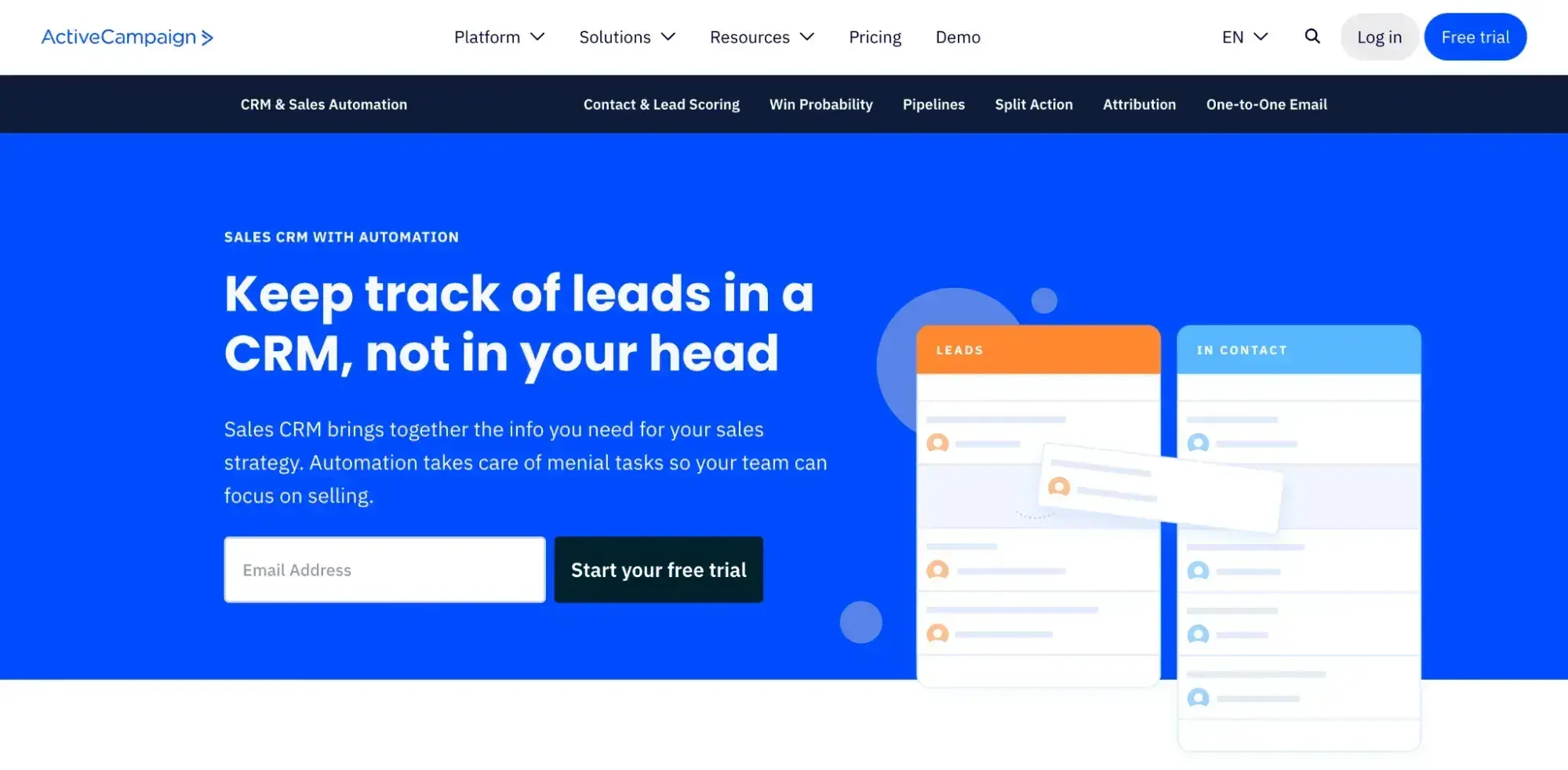
ActiveCampaign is a customer experience automation platform and CRM with a number of tasks and job functions you can automate across social media, email, live chat, SMS, and more. There are over 300 integrations — such as Shopify, Facebook, and WordPress — that you can use to tailor the CRM to your specific needs.
ActiveCampaign makes it easy to share customer lifecycle data cross-team and use it to make informed decisions about your interactions with customers (e.g., what content you should send to them, when to reach out, and what channel to leverage).
ActiveCampaign also helps you better understand your customers on an individual basis and effectively segment them by tracking buyer preferences, engagement, behavior, and unique traits.
This, along with other features like customizable campaigns and messages, allows you to personalize all communication with prospects and customers.
Example of ActiveCampaign in Use: Personalize Customer Experiences
A CRM organizes a lot of data about your customers on an individual basis — and a CRM like ActiveCampaign makes it easy to apply this data to create personalized customer experiences.
ActiveCampaign uses machine learning to automate personalization across various channels. As your business grows, you can continue to automate these one-on-one experiences to ensure every customer feels like they’re an individual who matters to your business.
ActiveCampaign also has customizable Personalization Tags and Deal Fields. These features allow you to add tailored, dynamic content to campaigns, emails, SMS, web forms, deal follow-up messages, and more, allowing you to tailor all communication to each individual.
Testing It Out
When I delved into ActiveCampaign’s AI capabilities, I found their AI-powered automation builder remarkably intuitive and efficient. The feature combines flexible actions with conversational AI and a user-friendly drag-and-drop interface to help you create automated email and SMS campaigns.
All you have to do is visually map out the journey you want to take your customers on, add triggers and touchpoints, and schedule when you want it to go into effect.
The generative AI feature impressed me as well. With just a few inputs on my end, the system suggested engaging and relevant email content that resonates well with my predefined target audience. This saved a ton of time and improved the personalization of my campaign.
I also explored the predictive email-sending feature, which uses AI to determine the optimal time to send emails based on contacts’ behavior and engagement patterns. This results in higher open rates for email campaigns, which can improve ROI.
Pricing
There’s a 14-day free trial available. The paid plans for the CRM and sales engagement platform include:
- Starter: Starting at $15/month
- Plus: Starting at $49/month
- Pro: Starting at $79/month
- Enterprise: Starting at $145/month
These plans are billed annually.
11. Close
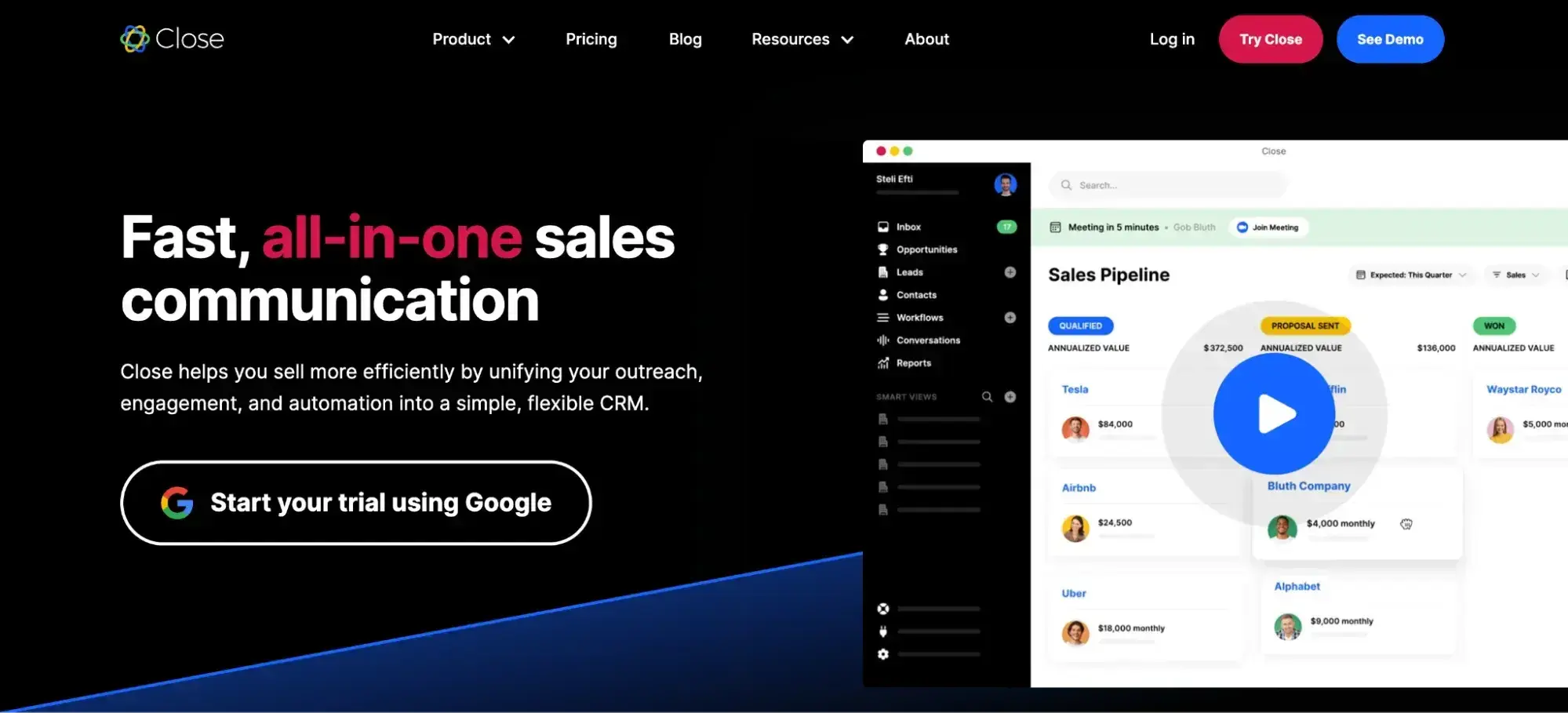
Tailored specifically for small and medium-sized businesses, Close offers a streamlined and efficient approach to managing customer interactions, tracking sales activities, and optimizing workflows.
This platform integrates communication tools such as email, phone, and SMS, which allows you to handle all your communications from one place, reducing the time spent switching between different tools and increasing overall efficiency.
Close also automates repetitive tasks such as follow-ups, reminders, and data entry, which ensures that no leads fall through the cracks and that you can focus on what you do best.
Example of Close in Use: Built-In Calling
One of Close’s standout features is its built-in calling functionality, which transforms how sales teams conduct their cold outreach and manage customer interactions. For example, I found that with Close, you can make and receive calls directly within the platform using VoIP technology. This eliminates the need for external phone systems and keeps all communication records centralized.
Whenever you make calls through Close, the platform automatically tracks and logs the call, providing valuable data on call duration, outcomes, and follow-up actions. The calls can also be recorded and stored for future reference or training purposes.
Testing It Out
During the testing process, Close GPT stood out to me. It’s like ChatGPT, but it’s tailored to quickly generate sales prospecting lists, summarize customer relationships, and create meeting agendas, among other things. I also loved the Call Assistant feature that automatically transcribes and summarizes all client (and cold) calls to help sales teams stay productive.
Close’s free AI tools were also pretty decent. The cold email generator, subject line generator, and AI email writer were designed to automatically create personalized and relevant emails that increase open and response rates, and scale the outreach process.
Pricing
There’s a free 14-day trial available. The paid plans include:
- Base: $19/user/month.
- Startup. $49/user/month.
- Professional. $99/user/month.
- Enterprise. $139/user/month.
These plans are billed annually. If you have more than 10 reps, you can call to create a custom plan.
{% module_block module “widget_0ce36c0b-2290-4206-b141-9ee6579f6238” %}{% module_attribute “child_css” is_json=”true” %}{% raw %}null{% endraw %}{% end_module_attribute %}{% module_attribute “css” is_json=”true” %}{% raw %}null{% endraw %}{% end_module_attribute %}{% module_attribute “hubdbrow_field” is_json=”true” %}{% raw %}{“id”:173158423372}{% endraw %}{% end_module_attribute %}{% module_attribute “label” is_json=”true” %}{% raw %}null{% endraw %}{% end_module_attribute %}{% module_attribute “module_id” is_json=”true” %}{% raw %}104842557838{% endraw %}{% end_module_attribute %}{% module_attribute “schema_version” is_json=”true” %}{% raw %}2{% endraw %}{% end_module_attribute %}{% module_attribute “tag” is_json=”true” %}{% raw %}”module”{% endraw %}{% end_module_attribute %}{% end_module_block %}
12. NetSuite
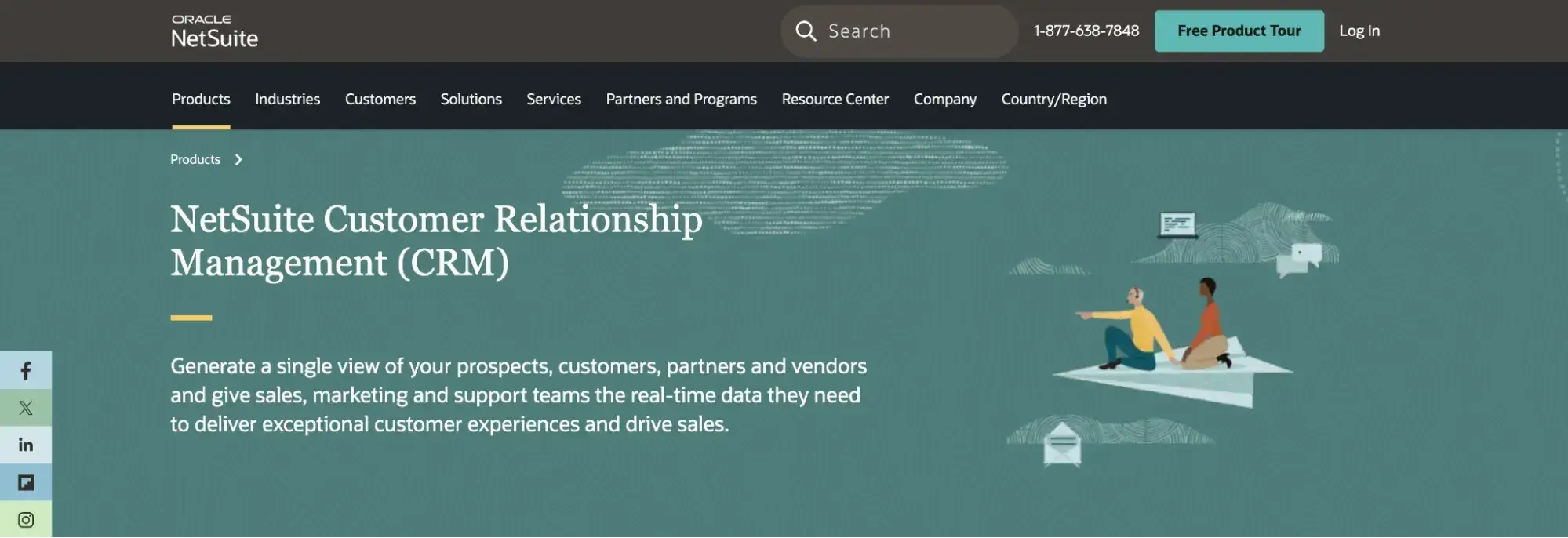
NetSuite is a comprehensive CRM solution offered by Oracle’s NetSuite. Designed for businesses of all sizes, this platform provides you with a bird’s-eye view of your customers, allowing you to manage the entire customer lifecycle, from lead generation to opportunity tracking, customer service, and order management.
As part of the broader NetSuite ERP suite, this tool integrates seamlessly with financial, inventory, and ecommerce systems, offering a unified platform for managing all business operations. NetSuite automates key sales processes such as lead assignment, sales forecasting, and territory management. This reduces manual tasks, increases efficiency, and ensures you can focus on building strong relationships with your customers and closing deals.
Example of NetSuite in Use: Sales Force Automation
NetSuite’s Sales Force Automation (SFA) capabilities are designed to enhance the effectiveness and productivity of sales teams. For example, the platform helps you manage leads and opportunities by capturing detailed information about prospects and tracking their progress through the sales pipeline. This allows you to easily view and update lead statuses, ensuring that no deal opportunity is ignored.
NetSuite also offers robust forecasting tools that provide visibility into future sales, which helps you plan resources and manage inventory effectively. These sales forecasts can be adjusted based on real-time data, which makes them highly reliable.
Testing It Out
When I tested NetSuite’s AI capabilities, I was impressed by how effective they were at enhancing various aspects of the marketing and sales workflows. For example, the AI-driven invoice processing feature can automate the entire invoicing process, from data extraction to payment tracking, which significantly reduces manual effort and minimizes errors.
The content generation tool was another highlight. I found that, by using AI and machine learning, NetSuite can create personalized content for customer communications and marketing campaigns. The ability to generate relevant and engaging content based on customer data and behavior is a game-changer when it comes to improving engagement and conversion rates.
Pricing
Users can subscribe to NetSuite CRM for an annual license fee, which covers the number of users, core platform, and optional modules. You’ll have to contact NetSuite’s team for custom pricing.
{% module_block module “widget_5bf64172-e392-45a1-937c-aa0a38834bc8” %}{% module_attribute “child_css” is_json=”true” %}{% raw %}null{% endraw %}{% end_module_attribute %}{% module_attribute “css” is_json=”true” %}{% raw %}null{% endraw %}{% end_module_attribute %}{% module_attribute “hubdbrow_field” is_json=”true” %}{% raw %}{“id”:173158423372}{% endraw %}{% end_module_attribute %}{% module_attribute “label” is_json=”true” %}{% raw %}null{% endraw %}{% end_module_attribute %}{% module_attribute “module_id” is_json=”true” %}{% raw %}104842557838{% endraw %}{% end_module_attribute %}{% module_attribute “schema_version” is_json=”true” %}{% raw %}2{% endraw %}{% end_module_attribute %}{% module_attribute “tag” is_json=”true” %}{% raw %}”module”{% endraw %}{% end_module_attribute %}{% end_module_block %}
Types of CRM (with Examples)
As you’ve seen, there are CRM options for just about every use case. In testing these options, I’ve found two things to be true:
Not all CRMs are created equal.
And that’s okay. Some businesses need a super-robust CRM to manage all aspects of their business, while others need a simpler solution. What matters most is finding one that works for you now and can grow with your business so you don’t have to go through the time, labor, and cost-intensive process of migrating to a new platform.
AI is making CRMs better.
Although AI is certainly controversial when it comes to privacy and its growing sophistication, there’s no doubt that it unlocks a ton of incredible insights.
In fact, AI is taking CRMs to the next level, from — for lack of a better word — a simple database for storing information to a tool that yields significantly better business intelligence (BI). In addition to optimizing sales, predicting growth, and identifying potential new buyers, I’ve found that AI-powered CRMs bridge all the “traditional” CRM functionalities and make it easier for sales people to do what they do best — drive revenue.
So what are the “traditional” CRM functionalities? Most fall into three categories: Operational, Analytical, and Collaborative. That said there are a few more speciallized types of CRMs.
While several CRMs, including the HubSpot CRM with AI, bridge them all, I’m going through each type below and sharing potential use cases so you can determine which is likely best for your needs.
1. Operational CRMs
In a nutshell, operational CRMs manage all of the business processes across sales, marketing, and servicing customers. Basically, they cover all aspects of the customer journey and automate as much as possible, minimizing manual workarounds and data entry.
Best for: Growing businesses that want to align their teams, streamline processes, and improve customer interactions.
Key Features of Operational CRMs
- Sales automation to track leads, automate follow-ups and reminders, and help move potential customers through the journey.
- Marketing automation to automate messaging, email campaigns, and lead scoring.
- Customer service tools to manage support tickets, deliver a better customer experience, and improve team morale.
Example of an Operational CRM in Action
The Challenge: Hypothetically, a mid-sized tech company selling software subscriptions struggles with manual follow-ups and missed opportunities.
The Operational CRM Solution: With an operational CRM, when a prospect downloads a whitepaper, they are automatically added to a nurturing campaign, assigned to a rep, and reminded to follow up if they don’t respond. Meanwhile, the system logs all interactions, ensuring customer support sees past conversations when the same prospect later reaches out with questions.
2. Analytical CRMs
The best way I’ve seen analytical CRMs described is that they focus on understanding. Where operational CRMs focus on doing, and collaborative CRMs focus on — well — collaboration, analytical CRMs put the data at the forefront and make it easier for companies to make informed, data-driven decisions.
Best for: Data-driven businesses that want to improve marketing and sales strategies.
Key Features of Analytical CRMs
- Customer data analysis to help sales teams identify specific touchpoints, trends, and areas of friction in the customer journey.
- Sales forecasting to help sales teams predict future sales.
- Customer segmentation to make it easier to create messaging and campaigns targeted to specific groups.
Example of an Analytical CRM in Action
The Challenge: Again, hypothetically, an outdoor gear e-commerce brand wants to improve customer retention.
The Analytical CRM Solution: The analytical CRM tracks purchase behavior and reveals that customers who buy hiking boots often return for trekking poles within three months. Using this insight, they create a follow-up email campaign with a discount on trekking poles at the exact time customers are most likely to buy.
3. Collaborative or Strategic CRMs
Collaborative CRMs are all about seamless interaction so that every team marketing to, selling, to, or servicing a client can work together. Ultimately, the advantage of this type of CRM means that all team members are informed and the customer doesn’t have to repeat themselves. (I’ve been on both sides of the equation and both are frustrating.)
Best for: Companies that need seamless internal communications.
Key Features of Collaborative CRMs
- Comprehensive customer data so everyone is on the same page.
- Multi-access user controls, so each person has access to the data they need to work effectively.
- Internal team comms to help teams collaborate more effectively.
Example of a Collaborative CRM in Action
The Challenge: Loving my hypothetical examples? Let’s keep going. A real estate brokerage with multiple agents and an in-house legal team needs all departments to have access to client information, but not everyone needs the same level of access.
The Collaborative CRM Solution: The CRM allows agents to track client interactions and property searches, legal teams to access only transaction documents, and marketing to see how past clients engaged with listings and personalized follow-ups.
What’s more, the service and admin teams have access to important customer information, so clients enjoy a seamless experience regardless of who they talk to.
4. Campaign Management CRM
As you might guess, campaign management CRMs are marketing heavy and they’re all about ensuring that marketing efforts are unified and seamless. These CRMs fall into the specialized category. I’ve found that they can be standalone platforms, but often are features of more comprehensive CRM tools.
Best for: Companies heavily focused on marketing.
Key Features of Campaign Management CRMs
- Email & ad campaign tracking to oversee marketing efforts and measure performance.
- Customer segmentation to improve customer targeting and personalization.
- Marketing ROI calculators to measure and analyze success and identify opportunities to improve in the future.
Example of a Campaign Management CRM in Action
The Challenge: A hypothetical fitness subscription company has found they have poor customer retention and want to increase renewals before customers’ annual plans expire.
The Campaign Management CRM Solution: By segmenting users based on frequency of engagement, creating personalized email sequences tailored to the level of engagement, and tracking open rates and responses, the company can improve engagement and become a must-have solution instead of “another subscription” people feel comfortable dropping at renewal time.
5. Social Media CRM
As you might guess, social media CRMs focus most heavily on social channels, including tracking all aspects of customer acquisition and reputation management, including ad targeting social listening. I’d consider these CRMs highly specialized as well. However, there are some social management platforms that incorporate these tracking aspects as well.
Best for: Brands with a heavy reliance on social media for growth and service.
Key Features of Social Media CRMs
- Social listening tools to stay on top of what people are saying about your company.
- Engagement tracking to improve the way you engage with customers.
- Audience analysis to identify potential brand ambassadors and simultaneously uncover new leads.
Example of a Social Media CRM in Action
The Challenge: A skincare brand launches a new product and wants to track online buzz.
The Social Media CRM Solution: Their social media CRM monitors brand mentions across different platforms, identifies customers who frequently engage with their content, and notifies the marketing team when influencers organically mention their product.
Using this data, they reach out to engaged customers for testimonials and launch a user-generated content campaign that leads to more sales.
6. Mobile CRMs
Mobile CRMs aren’t necessarily mobile-exclusive, but they have a high level of mobile functionality to make it easier for teams to collaborate from less traditional sales offices. Again, these are more specialized and often are a mobile-enabled aspect of larger, more robust CRMs.
Best for: Companies with remote teams, traveling service techs, and field sales reps who need CRM access on the go.
Key Features of Mobile CRMs
- Mobile app functionality to make it easy for teams to access the CRM from mobile devices.
- Offline access to simplify service even without internet availability.
- Push notifications to make sure teams get alerts about important customer updates.
Example of a Mobile CRM in Action
The Challenge: Let’s say a solar panel installation company has sales reps and installation teams who are at different locations on a daily basis. They want to make sure all teams can update their data regularly so that anyone can speak authoritatively to the customer if and when they call. (I have a non-solar service-based client who runs into this very issue, who chose their CRM based on its mobile app — among other functionalities.)
The Mobile CRM Solution: Their mobile CRM lets them quickly access client details before meetings, update customer status on-site, syncing automatically once back online, and receive push notifications if a lead they contacted a week ago reaches out again.
So, what CRM is right for you? Ultimately, every business has different CRM needs, so take some time to analyze what you need most and how you anticipate your company changing in the coming years. Then go back through this list and try the top 2-3 best-fit solutions to see which you and your team like best.
Choose Your CRM
There are a number of ways to use a CRM — and the use cases I shared above are just a handful of them. Start thinking about your goals and needs to select the right CRM for your team. Then, use your CRM to start building stronger relationships with contacts, improve the customer experience, save your team time, align business data, and grow better.
Editor’s note: This post was originally published in January 2021 and has been updated for comprehensiveness.
{% module_block module “widget_0e255094-eda2-49b5-a6e4-c6adc52bcb2e” %}{% module_attribute “child_css” is_json=”true” %}{% raw %}null{% endraw %}{% end_module_attribute %}{% module_attribute “css” is_json=”true” %}{% raw %}null{% endraw %}{% end_module_attribute %}{% module_attribute “hubdbrow_field” is_json=”true” %}{% raw %}{“id”:173158423372}{% endraw %}{% end_module_attribute %}{% module_attribute “label” is_json=”true” %}{% raw %}null{% endraw %}{% end_module_attribute %}{% module_attribute “module_id” is_json=”true” %}{% raw %}104842557838{% endraw %}{% end_module_attribute %}{% module_attribute “schema_version” is_json=”true” %}{% raw %}2{% endraw %}{% end_module_attribute %}{% module_attribute “tag” is_json=”true” %}{% raw %}”module”{% endraw %}{% end_module_attribute %}{% end_module_block %}
![]()

How to Code a Website for Free in 8 Easy Steps
As someone who navigates the complexities of web development, I know firsthand the challenges of learning how to code a website — especially with a budget of $0. Luckily, we have the internet, complete with thousands of resources to help you get started. The tricky […]
WebsiteAs someone who navigates the complexities of web development, I know firsthand the challenges of learning how to code a website — especially with a budget of $0. Luckily, we have the internet, complete with thousands of resources to help you get started. The tricky part becomes finding the right tutorials in a sea of information.
![]()
The Best AI Tools on the Market for Productivity and Audience Growth, as Tested by HubSpot’s SVP of Marketing
2024 was the year of AI tools. Thousands of new apps launched — some just photo generators and gimmicks, others much more useful. What stood out to me were the tools that actually helped you get things done. This list comes from a16z’s AI Unwrapped, […]
Marketing2024 was the year of AI tools. Thousands of new apps launched — some just photo generators and gimmicks, others much more useful. What stood out to me were the tools that actually helped you get things done.
This list comes from a16z’s AI Unwrapped, which largely features consumer apps for personal use. I’m calling out a few favorites from categories like productivity, audience growth, learning, and even building your own tools. You can try these tools tomorrow to start being more productive.
Whether you need a research dump on space agriculture, want to clone yourself into a short-form video creator, or just stop typing everything out by hand, there’s something here worth trying. Let’s get into it.
AI Tools for Productivity and Audience Growth — My Top Picks
1. Flow Voice: Hands-Free Productivity with AI
If you’ve ever wished you could talk to your laptop instead of typing, Flow might be the AI tool you’ve been waiting for.
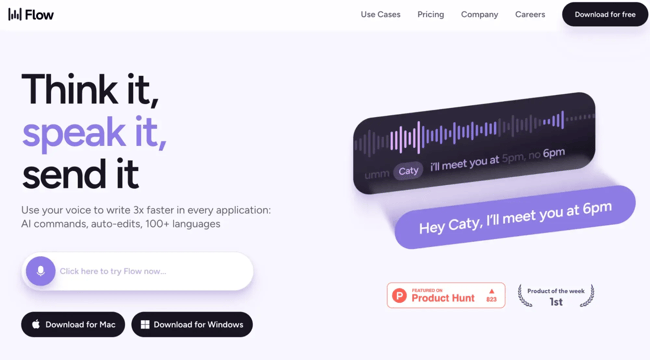
Similar to Grammarly, Flow embeds itself into every application that you use. But instead of fixing your grammar, Flow lets you control all your apps by speaking out loud. You can write emails, respond to Slack messages, edit Google Docs, and more — all without touching a keyboard.
Why Flow Is Interesting
We all type way too much. Between emails, Slack, docs, and text messages, it adds up. Flow is trying to cut out the extra effort by making it possible to talk to your computer the way you’d talk to an assistant.
Flow is built to be integrated into your workflow, meaning you can:
- Speak out a full Slack response instead of typing.
- Edit a document just by saying what changes you want.
- Translate text on the fly.
- Control your entire workflow with voice commands.
How Flow Works
I tested Flow, and here’s how it works:
- Hold down the space bar, speak your command, and Flow transcribes it in real time.
- Live editing is possible — just tell it to delete, rewrite, or change wording.
- You can even reply to Slack and email hands-free. AI makes sure your messages don’t sound like a robotic mess.
Here’s a screenshot of Flow in action:
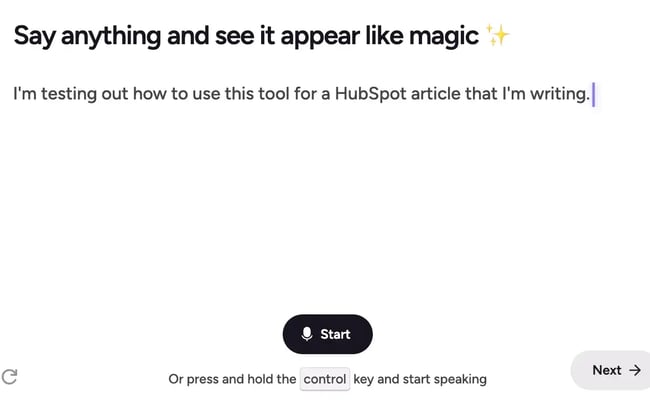
My take: Editing by voice is weird at first but kind of amazing once you get used to it. If you’re someone who lives in Slack and email, Flow is worth trying
2. Cubby: AI That Organizes Your Research for You
Cubby is a research assistant for people who hoard information. If you’re the kind of person who has 50 tabs open at all times, you should try Cubby. This tool makes remembering where you saw that one quote, article, or podcast clip simple.
![]()
Instead of dumping links into a Notion doc or bookmarking things you’ll never revisit, you can just drop everything into Cubby. That includes PDFs, podcasts, MP3s, MP4s, YouTube videos, social media threads, articles, and files from your computer. Then, Cubby can transcribe and organize the information into something useful.
Why Cubby Is Useful
AI tools promise to make life easier, but Cubby solves a real problem: Research is a mess.
If you’ve ever tried to do a deep dive on a topic, you know how it goes. You start by reading one article, which links to a whitepaper, which references a podcast, which makes you think of a YouTube video someone recommended, which leads to another article. Now, you have a dozen sources but no structure.
Cubby acts as a central brain for all your research, pulling everything together and making it searchable and usable. Instead of keeping track of tabs and notes, you just dump everything in and let AI handle the rest.
How Cubby Works
- Drag and drop anything you’re researching into Cubby.
- Cubby transcribes everything and pulls out the key points.
- You can ask it questions about the content instead of manually digging through hours of material.

My take: Cubby acts as a personal research assistant, helping you find connections between different sources without manual effort.
3. Delphi: AI Clones for Content Creation
Delphi lets you create an AI clone of yourself that people can interact with. Instead of constantly answering the same questions or trying to be in a hundred places at once, you can train an AI model on your knowledge. Your audience can then “talk” to you even when you’re not there.
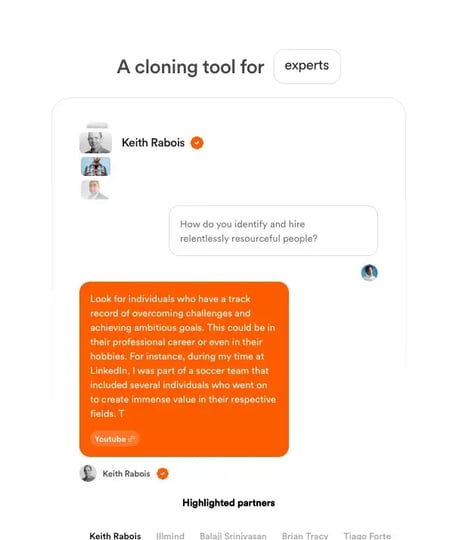
Why Delphi Is Useful
Let’s say you’re a content creator, consultant, or educator. You probably get a lot of the same questions over and over again — how to start a newsletter, how to grow an audience, how to price services.
Normally, you’d have to either:
- Answer every question manually (exhausting).
- Create FAQ pages or pre-recorded videos (helpful but static).
With Delphi, your AI clone can answer those questions for you in a way that feels interactive and personal. AI pulls from everything you’ve ever said, written, or recorded and responds in a way that sounds like you.
If you’ve built an audience and people value your expertise, Delphi lets you scale that engagement without being on call 24/7.
How Delphi Works
You train Delphi on your existing content — articles you’ve written, your podcasts, your videos, and any relevant recordings. Once your AI clone is up and running, people can go to your page and have a conversation with it.
Delphi’s chatbot is built to sound like you and to give answers based on your perspective — not just generic, AI-generated advice.
I tested this out with the AI clone of Brian Halligan, co-founder and executive chairperson at HubSpot. I wanted to ask questions about growing to $30M ARR and got some pretty helpful responses, along with referral links where I could learn more from Brian.
Delphi is a great idea for someone who has a wealth of expertise and with little time for one-on-one convos.
That said, this tool does raise a bigger question: Do people actually want to talk to an AI version of you? If someone is looking for a step-by-step process, they might be fine talking to AI. But if they want real feedback, ideas, or emotional connection, they’re probably still going to want you, not your clone.
My take: Right now, Delphi is best for creators who already have deep knowledge in a specific space and a community of people who are eager to access it.
4. HeyGen: AI-Powered Video Avatars
AI-generated video content has come a long way.
A few years ago, most AI avatars looked stiff and robotic, the kind of thing you’d see in a bad deepfake. But, HeyGen is pushing the boundaries. People might actually mistake an AI-generated version of you for the real thing.
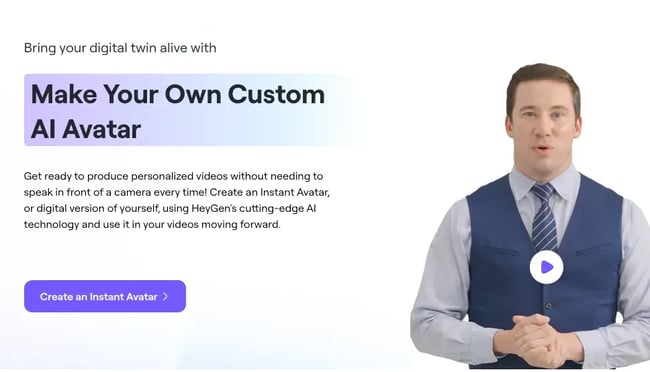
HeyGen lets you clone yourself into a high-quality AI avatar. Your digital self can then give presentations or even just talk to your audience, without you stepping in front of the camera.
To experiment with the tool, I cloned myself and delivered an entire course through my AI clone.
Why HeyGen Is Interesting
HeyGen isn’t like those weird robotic avatars from a few years ago. The tool now has smoother facial movements and better hand gestures, which means the uncanny valley effect is shrinking.
In fact, some people didn’t realize AI was presenting my course. They emailed me afterward, saying I seemed “a bit off” because I was keeping my hands still — something the early HeyGen model required. However, even that level of confusion shows how far the tech has come.
If your content is purely educational or instructional, HeyGen is a great way to create at scale without having to appear on camera every time.
Where HeyGen Could Be Helpful
For people who need to create video content at scale, HeyGen is actually a really useful tool.
- If you run an online course, you could use HeyGen to create lessons without filming every single one.
- If you record a lot of social media content, HeyGen could help you create short-form videos faster.
- If you need to translate videos into different languages, HeyGen can dub your avatar’s voice while keeping a natural lip sync.
My take: Just like with Delphi, there’s one big question in my mind. How much do people actually want to engage with an AI version of you instead of the real thing?
If your content is purely informational, this could be a great way to scale video creation. But if your audience is invested in YOU — your unique expressions, humor, and energy — an AI clone isn’t a real substitute.
5. Argil: AI Cloning for Short-Form Video Content
This one is specifically built for short-form video. Argil is a startup that lets you clone yourself with just a couple minutes of video. You can then start generating AI-powered videos by typing out a script.
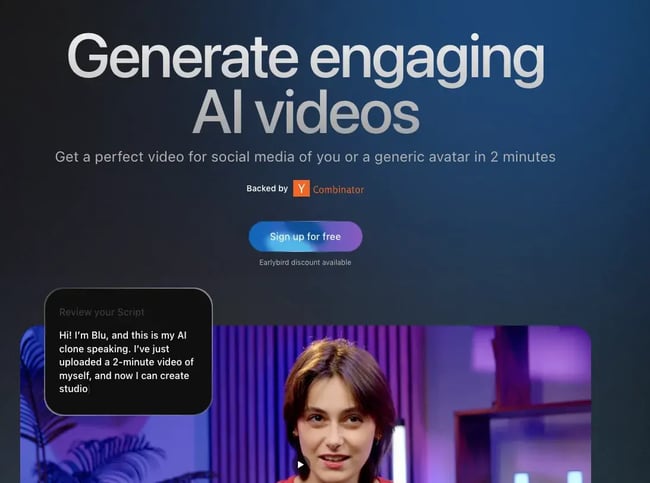
When browsing examples from their site, I noticed Argil focused on quick, punchy, creator-style content. It’s not trying to replace HeyGen or other full-scale avatar tools. Argil is built for speed and simplicity.
Why Argil Is Useful
You upload a short training video and then use your AI clone to generate clips that teach, promote, or entertain. Argil’s quality isn’t perfect — especially in the voice and visual realism — but it’s fast and lightweight.
Where Argil Could Be Helpful
Argil is best suited for:
- Creators making short-form content on platforms like TikTok or Instagram.
- People who already have an audience and want to repurpose or batch video production.
- Anyone experimenting with AI avatars who doesn’t need a full production studio.
Just like HeyGen and Delphi, the real value here comes after you’ve built an audience and figured out what kind of content resonates.
How Argil Works
Record a two-minute video of yourself, and Argil generates an AI clone. From there, you can script videos by just typing text. The clone will read it back, fully animated. The interface is simple and feels more like a Notion doc than a video editor, which makes it pretty approachable.
My take: Argil is a cool concept for short-form creators, but you’ll get the most out of the tool if you already know what audience you’re speaking to.
6. Opus: AI-Powered Video Editing
Opus is a tool most people already know. It takes long-form video — podcasts, interviews, keynotes — and automatically cuts it into short, shareable clips.
Given that editing video is one of the biggest time sucks in content creation, tools like Opus can be especially valuable. I tested it using an episode from Lex Fridman’s podcast. Opus grabbed highlights from the conversation and turned them into clips for TikTok, Shorts, Reels, and beyond.
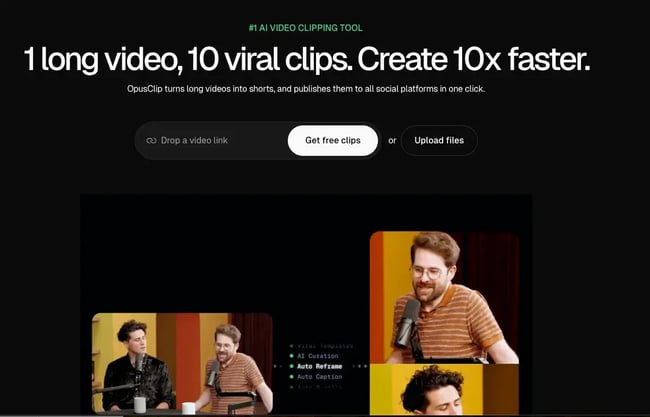
Why Opus Is Useful
People consume short-form videos at scale, but creating engaging clips from long content is tedious. Opus helps by:
- Identifying key moments in your video (so you don’t have to scrub through hours of footage).
- Auto-generating captions and subtitles for social media.
- Cutting multiple clips at once to batch-create content.
Where Opus Could Be Helpful
If you’re producing long-form video content, this is a must-try — even if you have to tweak the AI-generated clips.
However, here’s the reality: These tools create the average version of short-form content. They’ll get you something functional, but if you want something that really stands out, you still need to put in the work.
How Opus Works
You upload your long-form video to Opus. The AI scans it, detects key moments, and cuts them into short clips that are ready for social media. Opus then automatically adds captions, trims the fluff, and gives you multiple clips to work with — all in a few minutes.
My take: Tools like Opus are great for saving time, but they won’t make you a great content creator. Use them to speed up the basics, but still put in the work if you want content that hits.
7. Replit AI: Personalized Coding and Automation
Replit is kind of mind-blowing. Their AI agent is incredible, and the product as a whole is just super fun to use. This is one of the best examples of why we’re all going to have personalized software — tools that are built by and for us, instead of trying to fit into one-size-fits-all platforms.
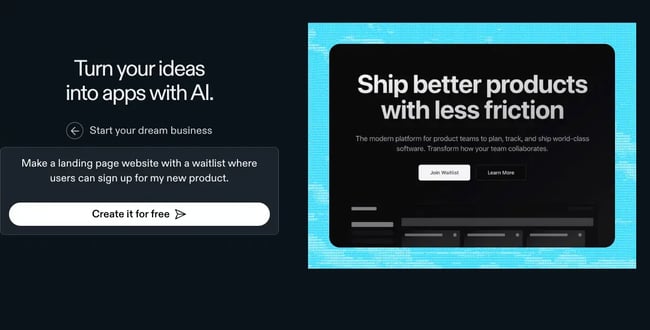
Replit AI acts like a co-pilot for coding, helping you generate and refine code based on what you need. That could be a simple scheduling app or a more complex automation.

The results are mind-blowing. You can actually build real products for yourself in a matter of minutes.
Why Replit Is Useful
Let me give you a real example. I was watching TV and talking to my partner. We talked about getting better at scheduling. We have a 10-month-old, and every hour of the day counts.
We were using Google Calendar, but it wasn’t exactly what we needed. So, I built something for us. It’s a basic scheduler that shows both of our days side-by-side from 6 a.m. to 8 p.m. We can add tasks, mark them as completed, and see where we overlap, especially when we want to play with our daughter or give each other a break.
It’s not a polished app, but it works. And that’s the point: I didn’t need every feature under the sun — I just needed something that worked exactly the way I wanted.
Where Replit Could Be Helpful
Replit is a game-changer for entrepreneurs and business owners who need custom software but don’t want to hire developers for every little thing.
Replit is great for:
- People who want to build personal tools that don’t exist yet.
- Teams looking to spin up lightweight internal tools fast.
- Marketers or operators experimenting with productized utilities or free tools as part of their marketing strategy.
How Replit Works
Replit uses an AI agent that supports you through the entire coding process. You describe what you want to build, like a scheduling tool or a custom dashboard, and it generates the underlying code.
You can make changes in real time, and the AI continues to adjust, refine, and debug as you go. You don’t need to know what you’re doing to get started, and that’s kind of the point.
My take: The big unlock here is personalized software. Instead of buying generic tools or trying to force your workflow into a template, Replit lets you build exactly what you need in the exact way you need it.
8. Notebook LM: AI for Smarter Note-Taking
Notebook LM was one of the best AI products released last year, and not nearly enough people are using it. If you deal with a lot of information — docs, ideas, meeting notes, research — it’s easy for things to get scattered. Notebook LM turns all of that into a structured, searchable, and actually usable knowledge base.
It’s like your second brain but better organized.
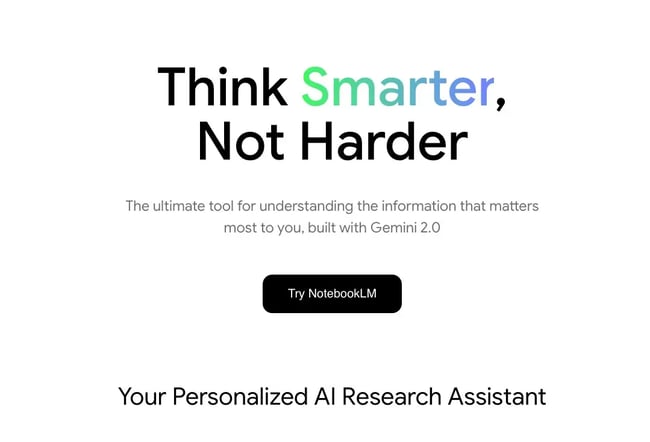
If you’ve ever wished your notes could actually work for you, this is the kind of tool that could change how you process information.
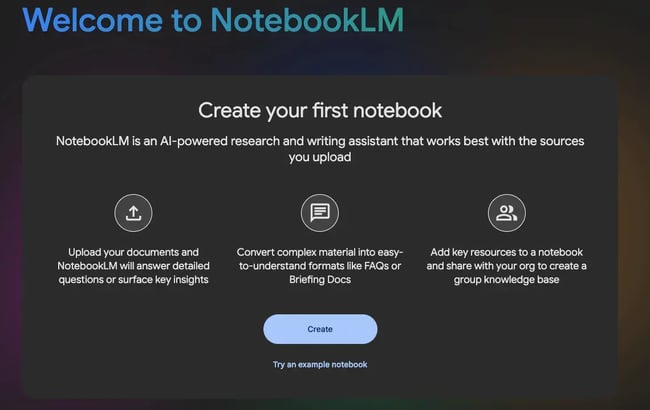
Why Notebook LM Is Useful
I use Notebook LM all the time. I’ve got it hooked up to all the different folders I use for work. It lets me:
- Create briefing docs based on everything in a folder.
- Generate audio reviews of content.
- Turn raw content into study guides or structured summaries.
Basically, it’s like having an AI-powered assistant who helps you turn scattered material into usable output without having to manually sort through everything.
Where Notebook LM Could Be Helpful
Notebook LM is especially useful for people who deal with a lot of information but don’t have the time to manually sort through everything.
It’s a huge win for:
- Writers and researchers who need to quickly summarize large amounts of text.
- Students and professionals who want AI to pull out key insights from notes.
- Content creators who juggle multiple projects and need to stay organized.
How Notebook LM Works
You connect Notebook LM to the folders or files you’re working with. AI analyzes the content and then generates summaries, notes, and guides.
You can query it like a research assistant. Ask it to surface themes, explain complex concepts, or highlight key ideas across documents. One of my favorite features is the study guide tool — you drop in content, and it builds out a full learning guide based on what’s in the folder.
My take: Notebook LM is one of the best AI tools I’ve used in the past year. If you haven’t tried it yet, start now. It’s the kind of product that feels more valuable the more you feed into it.
9. Napkin AI: AI-Generated Business Visuals
Most AI image generators are built for entertainment or aesthetics. They’re fun to play with but not really designed for business use. Napkin AI flips that. It’s focused on helping you create polished, professional visuals specifically for business content.
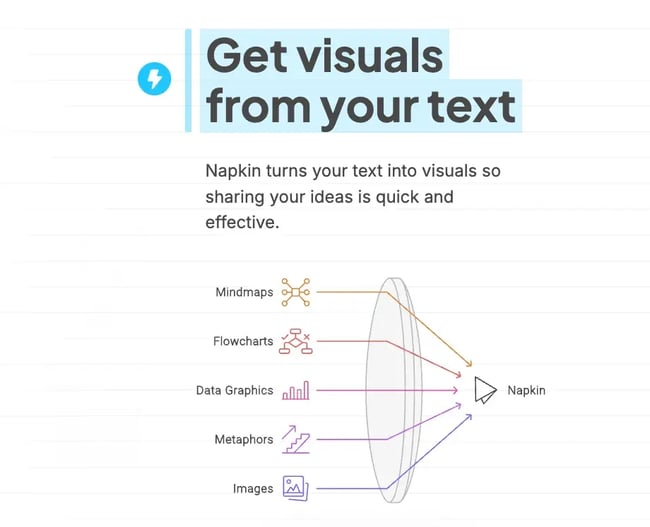
My take: If you’re creating presentations, writing LinkedIn posts, or building sales decks, this tool gives you fast, clean images that look like they belong in a real business context.
Why Napkin AI Is Useful
I used Napkin AI on one of my LinkedIn posts about AI-driven procurement, and it instantly generated a range of professional, business-friendly graphics. These weren’t surreal or off-brand. They actually looked like they belonged in a deck or B2B post.
This is where Napkin stands out. It helps you:
- Create clean, relevant images tailored to your business content.
- Skip the endless hunt through stock photos.
- Make posts, presentations, and reports more visually engaging without needing a designer.
Where Napkin AI Could Be Helpful
For professionals who create a lot of business-focused content, Napkin AI helps make posts and presentations more visually engaging. Here are some B2B materials I think Napkin AI could spruce up:
- LinkedIn posts. Instead of using overused stock images, I can generate custom graphics.
- Sales decks and presentations. I can quickly create business visuals without hiring a designer.
- Marketing and branding materials. I can generate on-brand images that match your messaging.
How Napkin AI Works
Napkin AI can take something like your latest LinkedIn post and automatically generate image options to go with it. You don’t have to prompt it from scratch or tweak complicated settings.
This tool is designed to generate visuals that feel like they belong in a professional setting — clean, minimal, and topic-specific — rather than the surreal or cartoonish output most image tools default to.
Napkin AI isn’t trying to replace a designer, but it gives you a starting point that feels about 80% of the way there. In most cases, that’s more than enough.
My take: If you post a lot of business-related content, Napkin AI is worth trying. AI-generated visuals still aren’t perfect, but Napkin AI’s focus on professional-looking graphics makes it stand out from other image tools.
Work Smarter, Not Harder With These AI Tools
In the past year, thousands of new AI apps have launched. I’ve personally tested dozens if not hundreds. While some were gimmicks and more AI fluff, some of these tools made a massive difference in my productivity.
If you’re looking for some AI tools to experiment with, give these options a shot first. Flow and Cubby make it easier to process information and cut down on manual work. Delphi and HeyGen let you scale yourself in ways that weren’t possible before. Replit and Opus are making it easier for anyone to build and repurpose content faster than ever.
So experiment. Build. Use what works. Just don’t forget to put your own edge into it.
To learn more about lead-scoring tactics and marketing growth strategies, check out the full episode of Marketing Against the Grain below:
This blog series is in partnership with Marketing Against the Grain, the video podcast. It digs deeper into ideas shared by marketing leaders Kipp Bodnar (HubSpot’s CMO) and Kieran Flanagan (SVP, Marketing at HubSpot) as they unpack growth strategies and learn from standout founders and peers.
![]()
The HubSpot Blog's TikTok Marketing Report: Insights from 1,000+ Social Media Marketers
I first downloaded TikTok during college to scroll through comedy and pop culture discourse. But then, as I grew as a marketer, I started seeing some serious potential everywhere. And I’m not the only one who noticed. TikTok has evolved beyond just dance trends and […]
MarketingI first downloaded TikTok during college to scroll through comedy and pop culture discourse. But then, as I grew as a marketer, I started seeing some serious potential everywhere. And I’m not the only one who noticed.
TikTok has evolved beyond just dance trends and viral challenges into a genuine powerhouse for brands connecting with audiences authentically. And don‘t just take my word for it — we’ve surveyed over 1,000 social media marketers to bring you data-backed insights on how TikTok is reshaping the marketing landscape.![Download Now: The 2025 State of Social Media Trends [Free Report]](https://no-cache.hubspot.com/cta/default/53/3dc1dfd9-2cb4-4498-8c57-19dbb5671820.png)
In this article, I’ll share the latest of our 2025 State of Social findings to help give your brand or business TikTok profile the visibility it deserves.
Table of Contents
Why TikTok Matters for Your Marketing Strategy
What started as a platform many marketers dismissed as “just for teens” has evolved into one of the most important channels in our digital marketing arsenal.
And the numbers don’t lie. Our research shows that 56% of social media marketers are now using TikTok, making it one of the top five most-used platforms alongside Instagram (76%) and YouTube (79%).

It’s so impressive to me when I reflect on the progress of other trending social sites. Unlike the slow adoption we saw with platforms like Snapchat in the marketing world, TikTok has managed to overcome initial skepticism and cement itself as a marketing essential in record time. I believe this rapid acceptance comes down to one thing: results.
TikTok isn‘t just popular — it’s effective. Marketers report that TikTok is a top performer across key metrics:
- 17% rank it as a top platform for driving website traffic
- 18% cite it as a leader for social media engagement
- 19% recognize its power for audience growth
If you’re a marketer looking to elevate your social strategy, a content creator aiming to maximize your reach, or a business seeking new channels for growth, this guide will help you navigate the world of TikTok marketing with confidence.
How Social Media Marketers Are Leveraging TikTok
Marketers have a knack for understanding and using social media in more ways than one, let me share the different ways we leverage TikTok for marketing objectives.
Platform-Specific Strategies
TikTok isn’t just another box to check in your social media marketing plan. Its unique algorithm and content discovery mechanisms require tailored approaches that differ from strategies you might employ on LinkedIn or Facebook.
Pro tip: In my experience, the brands seeing the most success on TikTok create platform-native content rather than repurposing material from other channels. I recommend starting fresh with content specifically designed for TikTok’s vertical format and fast-paced environment. Not to mention, video editing in the app is easy enough for anyone to do it!
Marketing Objectives That Shine on TikTok
Now, you can‘t just post a bunch of videos without a game plan. Marketers need to use social media strategically to achieve the results they’re looking for.
Our data shows that TikTok excels at:
- Building brand awareness through viral content
- Fostering community engagement (18% of marketers rank it as a top platform for engagement)
- Driving meaningful audience growth (19% cite it as a leader in this category)
I’ve found that TikTok particularly excels at humanizing B2B brands, something that can be challenging on more formal platforms. Its casual, authentic nature allows even the most corporate brands to show personality in ways that resonate with audiences.
Paid vs. Organic: Finding Your Balance
While TikTok offers robust advertising options, many brands succeed through organic content that resonates with the platform’s authenticity-first ethos.
However, our research indicates a growing trend toward paid strategies, with 30% of social media marketers planning to increase their TikTok investment in 2025, while 26% plan to maintain their current spending levels.
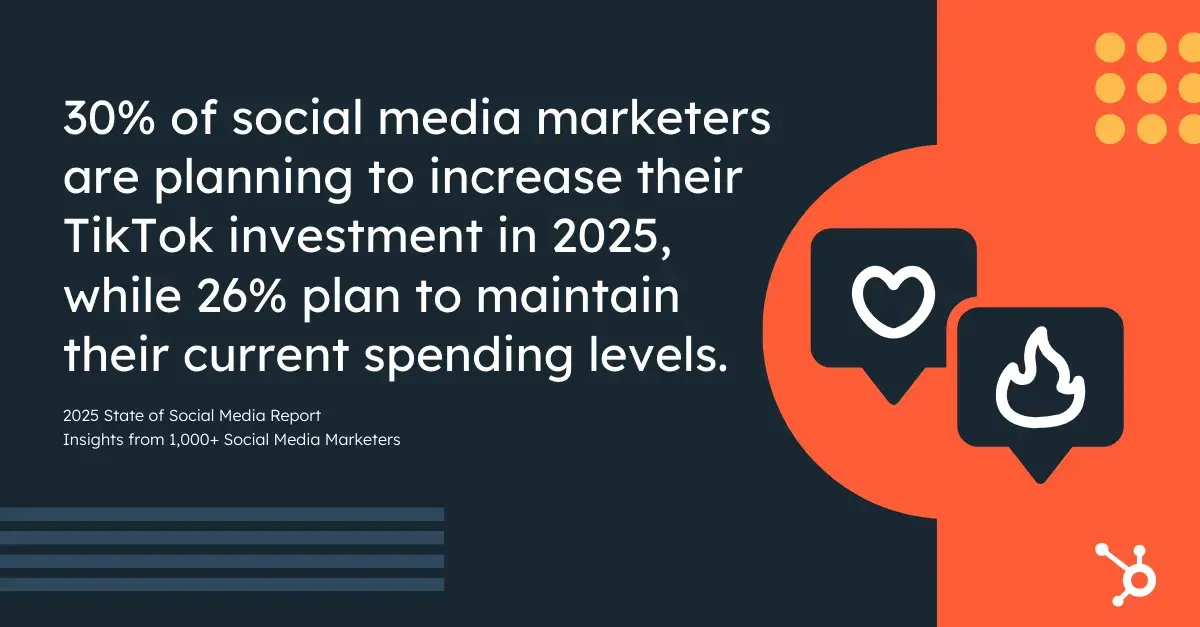
What I like: I‘m impressed by how TikTok has managed to create an advertising ecosystem that doesn’t feel intrusive. In my opinion, this is why both paid and organic strategies can thrive side-by-side on the platform—something that’s becoming increasingly rare in social media.
Data-Backed Benefits of TikTok Marketing
Engagement That Outperforms
TikTok isn‘t just keeping pace with other video platforms — it’s setting new standards for engagement. Our survey results place TikTok among the top performers for social media engagement at 18%, competing directly with Instagram and YouTube.
I‘ve personally observed that TikTok’s engagement rates often surpass what we see on other platforms, even with comparable content. There’s something about the format that encourages active participation rather than passive consumption.
Pro tip: I love repurposing TikToks into LinkedIn posts since video content is also a marketing priority on that social platform. Just download your TikTok and use the right hashtags for the audience you wish to reach, and you can make some meaningful connections there, too.
The Power of the For You Page
The platform’s algorithm-driven content discovery allows even accounts with modest followings to achieve significant reach, something that 17% of marketers recognize as they rank TikTok as a top platform for driving site traffic.
Pro tip: I always tell marketers not to get discouraged by slow follower growth on TikTok. Unlike other platforms where your follower count largely determines your reach, TikTok’s For You Page can put your content in front of thousands — even millions — of relevant viewers regardless of your account size. Focus on creating content that resonates, and the views will come.
Brand Safety Confidence
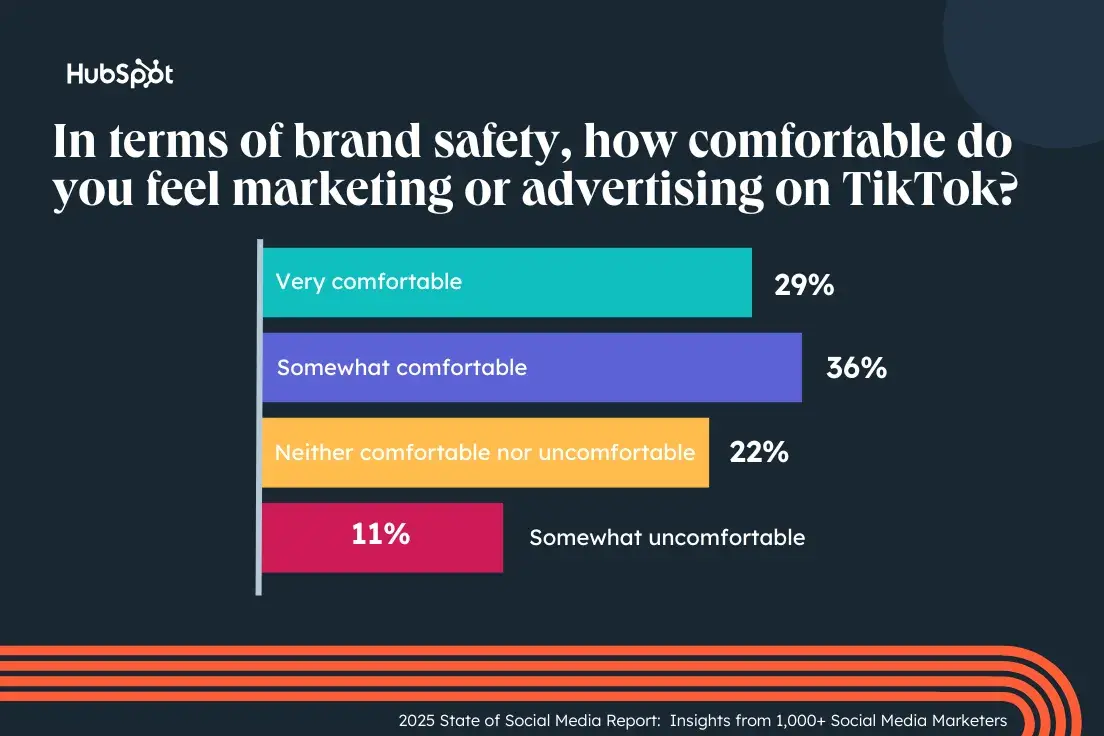
Concerns about brand safety have faded as TikTok has matured. Our data shows that a majority of marketers feel comfortable with their brand presence on the platform:
- 29% feel very comfortable
- 36% feel somewhat comfortable
- 22% feel neither comfortable nor uncomfortable
- Only 11% express some discomfort
Honestly, I was initially skeptical about brand safety on TikTok, but I’ve been pleasantly surprised by how the platform has evolved. The sophisticated content filtering and advertising safeguards have come a long way, and I now feel confident recommending TikTok to even the most risk-averse strategists.
How Content Creators & Marketers Are Earning ROI on TikTok
Influencer Marketing Excellence
TikTok has established itself as the leading platform for influencer marketing ROI. An impressive 47% of marketers report getting their highest ROI from TikTok influencer collaborations — outperforming both Instagram (46%) and YouTube (41%).
What I like: I‘m fascinated by how TikTok has democratized influence. Unlike Instagram, where established mega-influencers dominate, TikTok has created space for micro and nano influencers to drive significant results. I’ve seen campaigns with creators who have just 10,000 followers outperform those with influencers boasting millions — it’s all about authentic connection with niche communities.
Future Investment Trends
The confidence in TikTok’s ROI is reflected in future spending plans. When asked about their 2025 influencer marketing intentions, 15% of marketers plan to prioritize TikTok, making it the third most popular platform behind Instagram (27%) and YouTube (24%).
I believe we’re just seeing the beginning of the TikTok influencer ecosystem. As the platform continues to mature and more creators master its unique format, I expect that 15% figure to grow substantially by the time we run this survey again.
Driving Measurable Results
Beyond brand awareness, TikTok is proving its worth in tangible business outcomes:
- Traffic generation (ranked as a top performer by 17% of marketers)
- Community building and engagement (18%)
- Audience growth (19%)
Pro tip: In my experience, the key to driving measurable results from TikTok is integrating it into a multi-channel approach. I’ve found that using TikTok for awareness, then retargeting those engaged viewers on platforms like Instagram or through email, creates a powerful conversion pathway that maximizes ROI.
What Content Stands Out on TikTok
Authenticity Reigns Supreme
Unlike Instagram’s polished aesthetics or YouTube’s long-form depth, TikTok rewards authenticity and creativity. This creates unique opportunities for brands to connect with audiences through more casual, human content.
I’ve learned (sometimes the hard way) that over-produced content often flops on TikTok. My most successful posts have been those where I embraced imperfection and focused on genuine storytelling over production value (and coincidently, were the ones I edited the least).
Community-Driven Content
The platforms that foster authentic communities are seeing the most success. TikTok’s strength in engagement (ranked top by 18% of marketers) speaks to its ability to create meaningful connections between brands and their audiences.
Pro tip: Don‘t just broadcast on TikTok—participate. Some of the best brand moments I’ve seen on the platform come from companies that actively engage with trends, respond to comments, and duet with users. I recommend allocating at least 30 minutes daily to community engagement if you’re serious about building a TikTok presence.
How Experts Navigate TikTok Governance
Compliance Confidence
Despite early concerns about platform governance, marketers are increasingly comfortable with TikTok’s ecosystem. Our Social Media Trends Report shows that 65% of marketers feel at least somewhat comfortable with brand safety on the platform, with only 11% expressing discomfort.
I remember the uncertainty many of us felt when TikTok first emerged as a marketing channel, but I’ve been impressed by how the platform has responded to concerns and built robust systems to protect both users and brands.
And on the note of a different type of governance — despite TikTok experiencing a U.S. temporary “ban” (if you call 12 hours a ban) in January 2025, it hasn‘t stopped the hundreds of thousands of creators and businesses on the platform from continuing to post. If that isn’t an indicator of this app‘s impact and staying power, I’m not sure what is!
Adapting to Platform Evolution
Smart marketers stay agile, ready to adapt to TikTok’s evolving landscape — from algorithm updates to new features. This adaptability will be key as 30% of marketers plan to increase their TikTok investments in 2025.
Pro tip: I‘ve found it essential to dedicate time each week to staying on top of TikTok’s changes. Join TikTok for Business newsletters, follow their blog, and connect with other marketers in the space. The platform moves quickly, and staying informed about new features or algorithm shifts can give you a significant competitive advantage.
TikTok Marketing Examples
Success Across Business Models
Both B2C and B2B brands are finding their footing on TikTok. The platform’s versatility has allowed companies across sectors to connect with audiences in meaningful ways, contributing to its status as a top platform for audience growth (19%).
What‘s surprised me most is how well B2B companies can perform on TikTok when they approach it strategically. I’ve watched traditionally “boring” industries create engaging content that not only drives awareness but actually converts. The key? Focusing on the humans behind the business decisions.
Influencer Success Stories
The data speaks volumes: 47% of marketers report their highest influencer marketing ROI comes from TikTok. These collaborations are proving more effective than traditional advertising for many brands, explaining why 15% of marketers plan to prioritize TikTok for influencer partnerships in 2025.
What I like: I love how TikTok has broadened the definition of “influencer” to include subject matter experts, industry professionals, and everyday enthusiasts. This has created opportunities for more authentic partnerships that feel less like advertisements and more like valuable content—which, in my experience, is precisely why they perform so well.
Hone Your TikTok Strategy for 2025 and Beyond
As we look toward 2025, TikTok’s importance in the marketing mix continues to grow. With 30% of marketers planning to increase their TikTok investment and only a small minority expressing concerns about brand safety, the platform has firmly established itself as a marketing essential.
For marketers looking to start or improve their TikTok presence, our data offers clear direction:
- Prioritize authentic, engaging video content
- Consider influencer partnerships for maximum ROI
- Balance organic and paid strategies
- Focus on metrics that matter: engagement, traffic, and audience growth
I‘ll be honest: if you’re not already incorporating TikTok into your marketing strategy, you‘re likely falling behind competitors who are. The data doesn’t just suggest TikTok is important—it screams that this platform has become essential for brands that want to stay relevant and connected with audiences.
![]()
How Customer Journey SEO Turns Clicks Into Conversions
Before you decide what to buy, you probably decide where to shop — which means turning to your favorite search engine. With online searches dominating as the starting point of most purchases, customer journey SEO is now mission-critical for every business. I honestly can’t remember […]
MarketingBefore you decide what to buy, you probably decide where to shop — which means turning to your favorite search engine. With online searches dominating as the starting point of most purchases, customer journey SEO is now mission-critical for every business.
I honestly can’t remember the last time I made a purchase without some online research first. Earlier today, I fell down a Google rabbit hole looking for bulk-dried tortellini. Last fall, it was a new MacBook.
By the time I was searching for the best deal on a MacBook, I had already done the bulk of my research — comparing specs, vendors, and reviews. And that tortellini search? It introduced me to brands I never would’ve found if they hadn’t optimized for the SEO-driven customer journey.
Here’s the real question: If your brand isn’t showing up when customers are searching, how much business are you losing to competitors?
Table of Contents
- What is customer journey SEO?
- Mapping Your Customer Journey
- Creating Your Customer Journey Map
- A Step-by-Step Guide to Align SEO With Your Customer Journey
What is customer journey SEO?
Customer journey SEO is simply where SEO and customer journey mapping intersect. While most businesses focus on SEO as a way to rank higher, that’s only part of the equation.
The best SEO strategies do drive traffic. But they take it a step further, supporting customer inquiries through every step of the journey from discovery to purchase, maximizing visibility, engagement, and conversions.
Understanding Different Types of Searches
So, how do you integrate SEO into your customer journey? It starts by understanding the three core types of search: navigational, informational, and transactional.
As you can imagine, each phase correlates with different types of search queries. Aligning your SEO strategy to the customer journey means tying your efforts to each type of search.
Navigational Searches: When Customers Already Know You
Your prospect has a solid idea of what they’re looking for and just wants help going to a specific site.
Using my MacBook example above, some navigational searches I used were:
- “Apple new releases”
- “Costco computers and laptops”
- “Best Buy Geek Squad”
I knew I wanted an Apple product, and I was headed to different vendors I trusted to find out more about the models and to get the best price.
Successful SEO optimization for navigational searches focuses heavily on branding.
Informational Searches: When Customers Are Exploring Options
Your prospects are looking for answers, knowledge, and help. This usually means more top-of-funnel content. Examples of these searches for new laptops might be:
- “MacBook Air vs. MacBook Pro”
- “Best laptops for running an online business”
- “Is the latest MacBook worth it?”
When I was still deciding on a MacBook version and confirming that I wanted Apple over Windows, I looked for content like blog posts, comparison articles, and product reviews.
Successful SEO optimization for information searches means leaning into content marketing.
Transactional Searches: When Customers Are Ready to Buy
Your prospects are ready to buy. They might be looking for the best deal, still deciding between options, or looking for confirmation that their top pick is truly their best bet. Examples of these searches might be:
- “Best deals on MacBook Pro.”
- “Where to buy a MacBook Pro.”
- “Amazon MacBook deals today.”
At this stage, I was really just looking for the best deals and best options, so I looked at product pages and pricing comparisons.
Finally, successful SEO optimization for transactional searches means emphasizing information-rich product pages.
Here’s what that looks like in a visual:
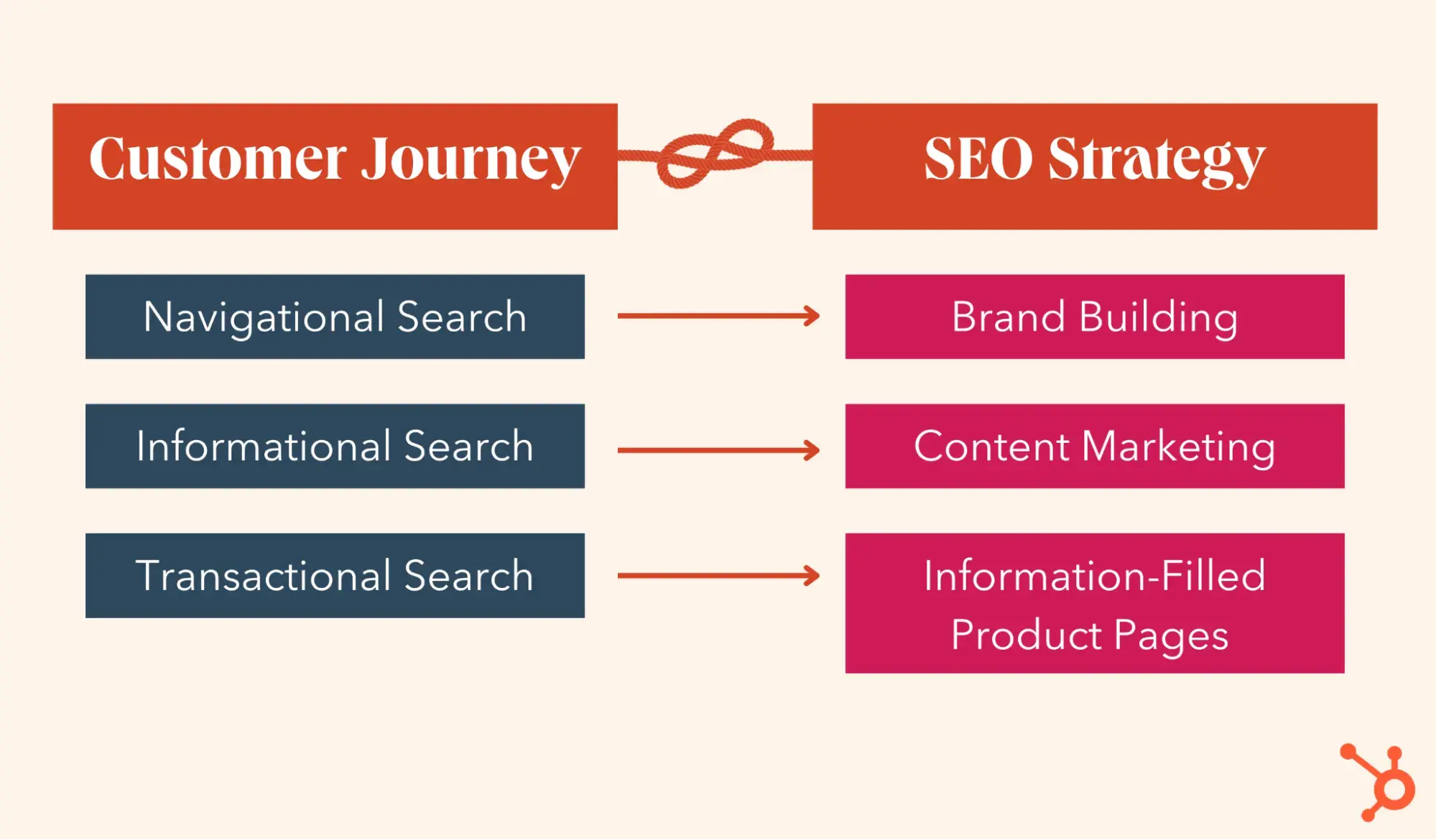
Mapping Your Customer Journey
Before you optimize for SEO, you need to map out your customer’s journey. A customer journey map helps you visualize exactly where potential buyers engage with your brand — and where gaps exist.
Marketing Consultant Kerry Bodine explains it best in this must-watch video:
The great thing about customer journey maps is that they put customers first. By sketching a sticky-note map of people progressing through a theoretical funnel, you are putting the focus on customers.
I firmly believe that’s how every organization should function — elevating, honoring, and giving pride of place to the customers. This level of customer obsession leads to loyalty, referrals, and competitive advantage.
Pro tip: Don’t make the mistake of thinking customer journey maps are the same as sales funnels.
While sales funnels do provide a broad-based sketch of a process and can be a good starting point, they don’t actually map the journey. With that in mind, it’s best to think of them as two separate entities serving two separate purposes.
Creating Your Customer Journey Map
For the purposes of this article, I’ll stay high level. We’ve got a great post that goes into detail on creating your customer journey map, and I definitely encourage running through it.
With that said, here’s how to create your map and make it SEO-friendly.
Step 1: Identify the key stages in your customer journey.
We typically break this down into three stages:
- Awareness. When customers first discover their problem or need.
- Consideration. When customers begin researching their options.
- Decision. When customers are ready to buy.
In fact, you can see them in the screenshot below of our free customer journey map template.
Step 2: Map your customer search behavior.
Now, it’s time to figure out what they’re searching for at each phase. I want you to consider search intent as well as the specific keywords and questions.
- Awareness. Informational searches for “how to” content about solving their problem.
- Consideration. Product comparisons and brand research.
- Decision. Transactional and vendor searches.
With that in mind, start mapping out the types of searches they’re likely making. You can usually shorten this page by using your SEO marketing software (it’s HubSpot, right?).
Pro tip: Revisit this regularly. Consumer habits and markets change, which means search patterns do, too.
Step 3: Connect the customer journey to SEO efforts.
This is where the customer journey SEO comes in. It’s important to understand the types of content that best fit each phase before diving headlong into mapping. Here’s a quick rundown of how things often break down at each stage:
- Awareness. Top-of-funnel (TOFU) content like blogs, guides, and frequently asked questions.
- Consideration. Middle-of-funnel (MOFU) content like product comparison pages, case studies, and testimonials.
- Decision. Bottom-of-funnel content (BOFU) like product pages, pricing comparisons, and lead gen content.
Pro tip: Don’t overcomplicate it. Start with these quick wins:
- Repurpose what you can. Before creating a ton of new content, do an audit of your existing content. You may have a lot of great stuff that just needs some tweaking or optimization.
- Identify the low-hanging fruit. What content is easy to create that will have a big impact? TOFU content often fits into this category, but not exclusively.
- Prioritize content that serves a double duty. Maybe this means focusing on resources that can also help existing customers. Or perhaps it means focusing on optimizing product pages to create awareness earlier in the process.
Want more detail? Check out our free Customer Journey Mapping lesson.
More Customer Journey Mapping Examples
Your customer journey map can take MANY different forms and should help you identify what your customer is experiencing at each stage of the journey.
If the first template you find isn’t working for you and you can’t easily adjust it for your needs, I recommend opening up your favorite infographic tool to see what customer journey templates exist. I did a quick Canva search, and clicked on one of the first designs that caught my eye. As you can see below, there are several different options right below it.
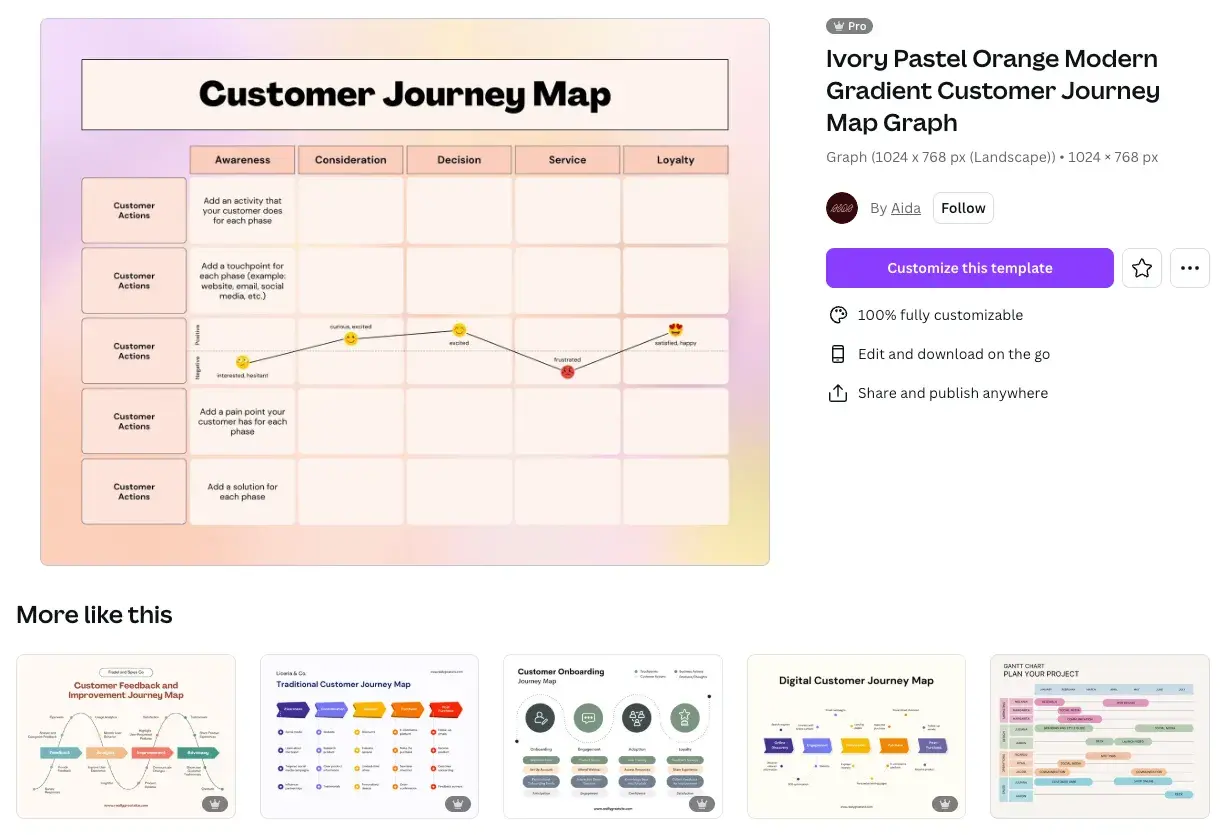
I usually end up combining visuals with tables or spreadsheets because both are helpful to me.
A Step-by-Step Guide to Align SEO With Your Customer Journey
If your brand isn’t visible at the right moments, your competitors will be. That’s why SEO isn’t just about rankings. I want you to instead think about it through the lens of making it easy for your audience to find you when it matters most — or at the start of the customer journey.
If they can’t find you — clearly the best option — customers will veer off to a competitor. Or, even worse, they’ll get lost and end up frustrated or back at ground zero. So, findability is not an option.
Your SEO strategy should be built around user intent. Here’s how to optimize your content for each stage of the journey based on the customer journey map and content overview you mapped out above (you did that, right?).
Step 1: Make a list of keywords/queries for each point in the customer journey that involves a specific query type.
Find each touchpoint in your customer journey and use your favorite SEO keyword research tools to develop a list of keywords your customers are likely using.
Let’s say a customer is researching luxury vacations. They start with informational searches (“Best Caribbean resorts”), progress to navigational searches (“Four Seasons Bora Bora vs. Ritz-Carlton Maldives”), and finally move to transactional searches (“Four Seasons Bora Bora best deal”).
Type of website: Family vacation planning service
Customer: Suburban mom planning for family vacation
Point in customer journey: Getting a sense of travel costs for her upcoming family vacation.
Query type: Informational
Possible Keywords:
- family vacation cost
- cost for family of 4 to go to Disney World
- vacation cost calculator
- how much vacation can I afford
- average vacation cost for family of 4
- average vacation cost
- cost vacation Ireland
- cost vacation
- low-cost family vacation ideas
Step 2: Optimize for intent.
Now, take those keywords and plug them into your SEO strategy. How? Let’s take one keyword from the above example — “how much vacation can I afford?” Here’s what you might do:
- Create a page on the website.
- Page title: “How much vacation can I afford? | Vacation Planning.”
- H1: “How much vacation can my family afford?”
- Article: Discuss answers to this question in the article, and provide a CTA at the end.
- Create a series of four evergreen blog articles that deal with this question. Use this keyword and any longtail variations of “how much vacation can I afford?”
- Create an infographic that answers the question, “How much vacation can I afford?”
- Interview several experts on vacation affordability and post a video series on YouTube.
After conducting an effort like that, you will start to dominate that keyword. More to the point, you will also dominate this phase of the customer journey. Whenever potential customers engage in informational searches for this phase, they will likely see your website in the search results.
Step 3: Measure and refine.
SEO can have quick wins, but it’s also a bit of a long game. And as I touched on above, things change as markets and technology evolve. So what worked 10 years ago didn’t work 5 years ago — and definitely doesn’t now. To that end, what works well today will barely scratch the surface in the next 5-10 years.
So, use Google Analytics to track conversions and tools like Ubersuggest or Ahrefs to track SEO performance. Then, improve underperforming content and create new content to meet your new needs.
Step 4: Improve technical SEO for visibility.
Keywords and on-page SEO will help your customer journey optimization efforts immensely. But there’s another piece of the puzzle that matters, too — technical SEO. By improving your domain health and ensuring that your site is usable and functional, you build even more trust with Google and other search engines. And that ensures that your customer journey SEO efforts pay off.
If you’re not deep into the SEO world, it’s probably worth bringing in a technical expert, but you can do a lot of this stuff yourself if interested. You can check out our free Technical SEO lesson here.
Findability Is a Must for Customer Journey SEO
To stay competitive in today’s market, online visibility is a must.
If you want to market more effectively, and you don’t yet have a customer journey map, you’re going to want to make one. But don’t stop there. A customer journey map is an excellent exercise, but without SEO implementation, it’s going to be less than productive.
The bottom line? If you’re not mapping SEO to your customer’s journey, you’re leaving money on the table. And you and your customers deserve better.
Editor’s note: This post was originally published in September 2014 and has been updated for comprehensiveness.
![]()




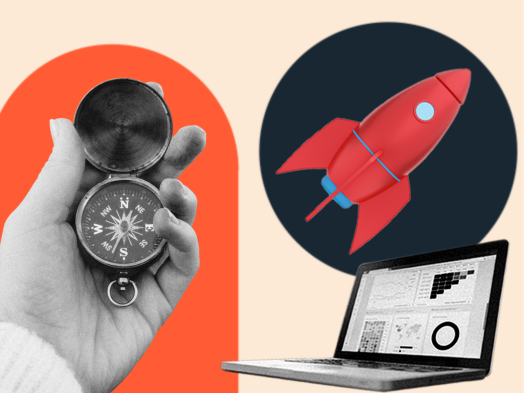
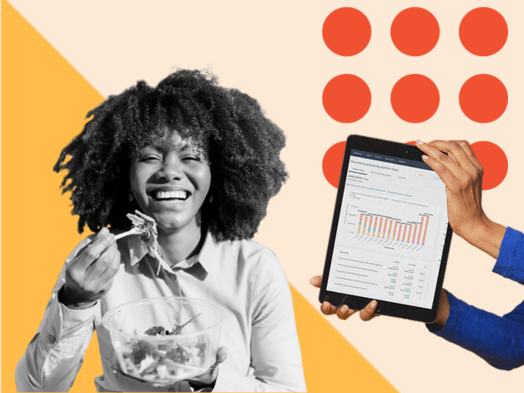



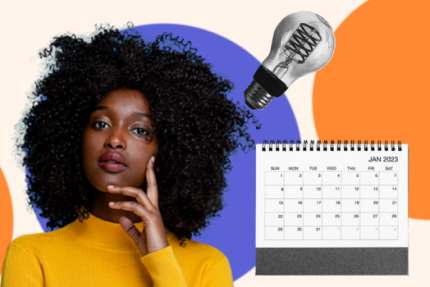





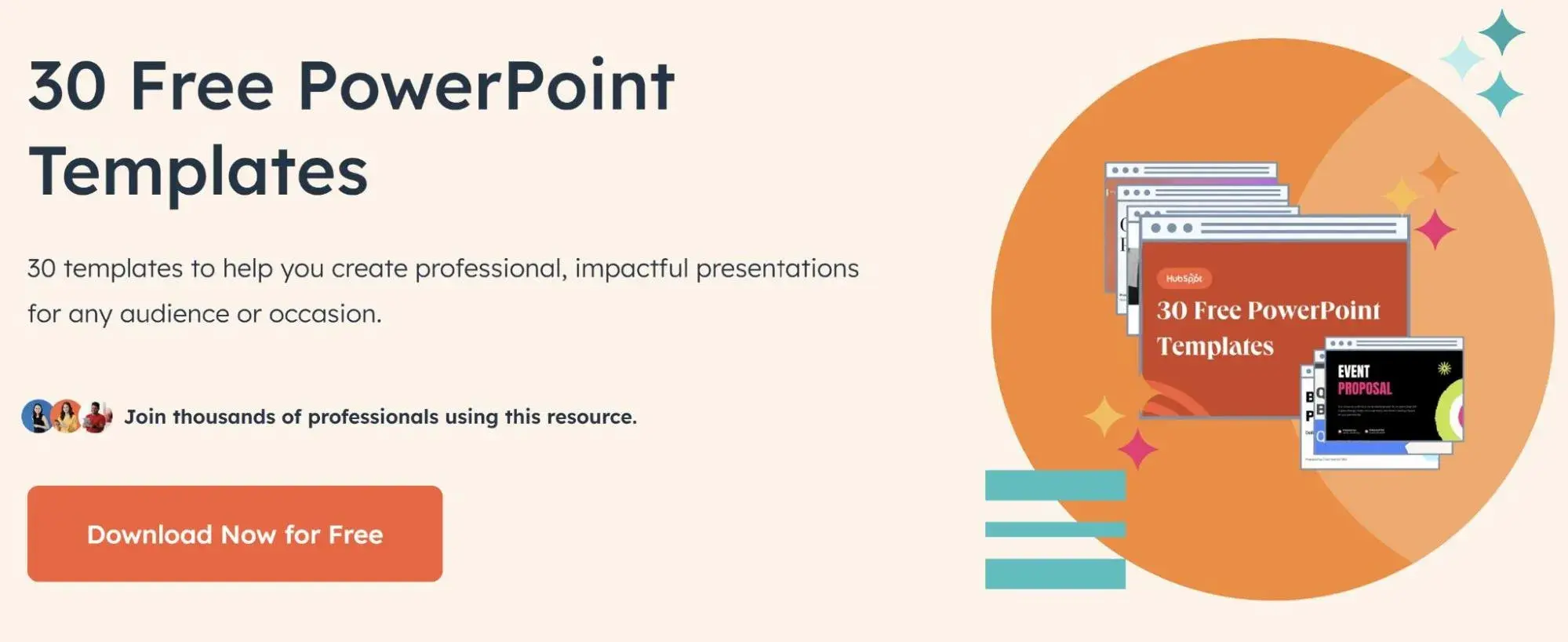
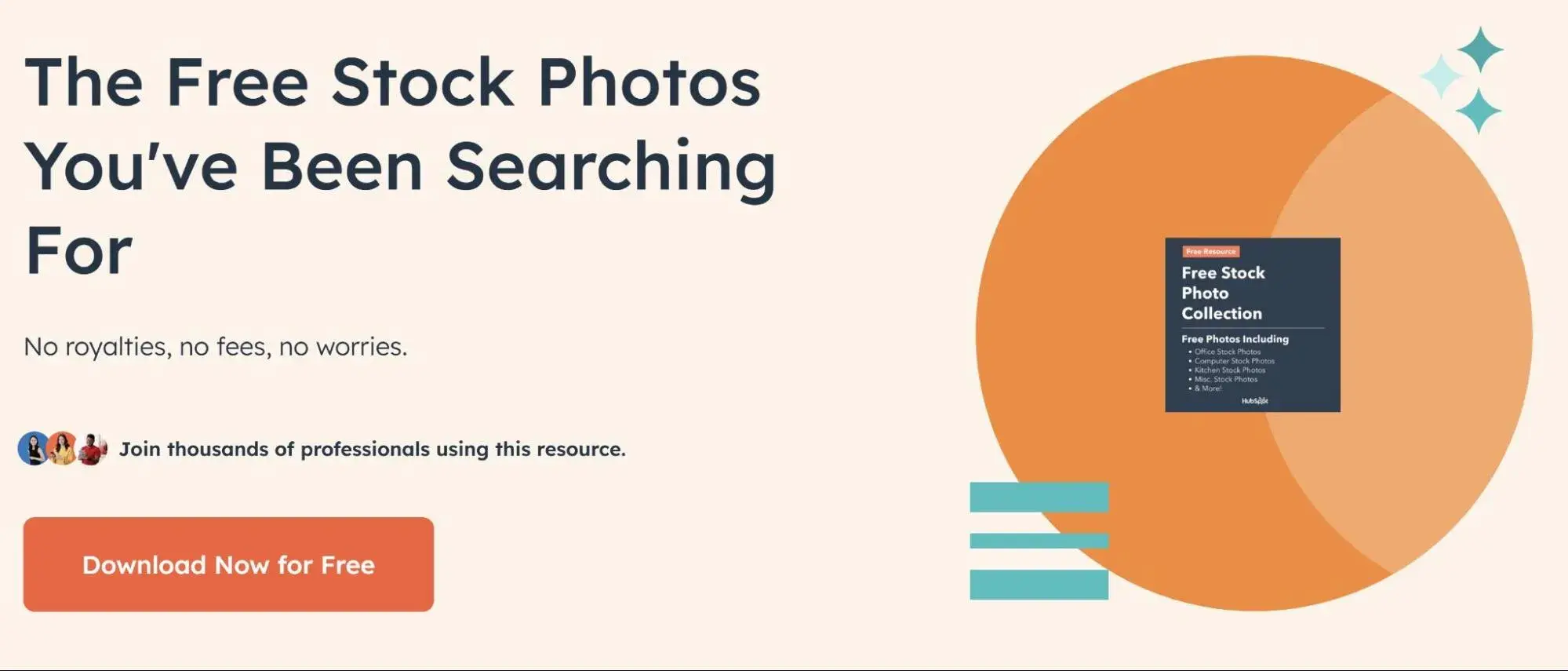
![Download Now: The State of U.S. Consumer Trends [Free Report]](https://web-stil.info/wp-content/uploads/2025/04/ebf9ec8e-a468-455a-943e-80aa4e6be694.png)

![Download Now: Free State of Marketing Report [Updated for 2024]](https://no-cache.hubspot.com/cta/default/53/db725f24-564c-483b-a28c-2d6ff9986516.png)
